Essential Reference Library for Pulp GMs (and others): 5th Shelf

Finally, it’s done! This has turned into the largest single post ever published by Campaign Mastery, and by a huge margin.
So, what happened? Well, when the initial blowout took place I calculated, based on the Europe results, that I could expect to have to add another 216 entries or so, at an average of four-point-six in each section. I then divided the list of extras in two – half for last week’s post, and half for this week. Last week’s post was used to test the validity of the original estimates, and they seemed to track fairly well.
Because a full quarter of the list of entries were already done, just needing some copy-and-paste work, I had reasonable expectations of being able to post this article on time, especially since I devoted most of my Tuesday, and half of my Wednesday, to getting an early start. I predicted that sometime Thursday night or Friday, it would be all systems go.
On Tuesday I did the basic structure, the introductions, and populated the Caribbean section. The goal Wednesday was to do China, leaving the rest of Asia to happen on Thursday, and the balance on Friday. And, if there had been four-point-six entries per subsection, that schedule would have been achieved.
Came Friday Night, and I was only just getting to Africa; Asia had seen quite a blowout in entries. On top of that, I kept thinking of sub-sections and whole sections that had been overlooked, and extending the list. And then Saturday came and went, and then Sunday Morning. It’s now 4AM Monday Morning, and the words – aside from this sidebar – are done.
Almost every category and subcategory have blown out. Instead of 104 recommendations, this list contains 270. Instead of being about 18000 words, a third of which were already written, it now contains more than 36,000 – plus HTML code that carries it past the equivalent of 43,000 words. That’s almost 8000 words a day – when my usual average is forty-five hundred.
So the post may be late – but I haven’t been wasting my time. Without further ado, here are the contents of the Fifth Shelf…
The Fifth Shelf: The Stranger Places – Introduction by Mike
In these days of sat-nav, when virtually every inch of the planet’s surface has been photographed and mapped to within an inch, it can be hard to appreciate the impact of not knowing. Even the iron curtain fell, and the soviet union not long after, and people can now tour Russia and China in relative impunity. Relations between Cuba and the US have thawed and are beginning to stabilize. The only place that even comes close to presenting the facade of mystery that was once so prevalent is North Korea, and even that is but a shadowy reflection of the great unknowns of the past.
It wasn’t like that in the Pulp Era. Like the age of Steam that preceded it, the world could be divided into three categories: the places that were well known, the places that the average person might know a little about, but which would still be strange and exotic, and the places where anything might exist, and wonders remained to discover. Only the number, size, and shape of those unknowns had changed.
Some places had recently undergone intensive exploration and discovery just prior to the pulp era, and the discoveries of Ancient Egypt (and, to a lesser extent), the Incas and Mayans retained a grip on the imagination of the common man that lingers to this day.
These places of mystery are the subject of this shelf of the reference library, and so far as they are concerned, the GM is in an incredibly privileged position. Not only can he draw upon all the modern knowledge of these places of mystery, he can ignore, edit, and rewrite that modern knowledge as he sees fit, in the name of excitement and adventure.
Not that being unknown stopped the writers of the past, who populated these unknown regions with all sorts of strange things. Not being constrained by reality, they were free to invent all manner of strangeness – and many did so. Some of these strangest places of all were advanced as serious – if fringe – theories, and some of those have since been found to have a grain of truth. Others seem to be total and utter mythology.
Things are complicated still further by the fact that these were amongst the least politically-stable locations of the twentieth century. That places information about the way they are at arm’s length to the way they were, further marginalizing the value of modern reference materials.
When I was a child, one of my relatives had a board game that included a world map. I don’t remember the game’s name, or how to play; what I remember is speculating endlessly about what might be in these strange places that I had never heard of before, And that was in the early-yo-mid-70s, and despite being very well-read for my age at the time. The place names alone held an aura of wonder. Khartoum. Cairo. Constantinople. Istanbul. Nepal. Bermuda.
In the Pulp Era, that mystique should not only be alive and well, the reality should mirror it – rather than reflecting the more-prosaic reality that has been uncovered. These are places where one can step into the looking glass.
Relevance to other genres
“Sense Of Wonder” is something that most genres try very hard to manifest, whether it be the alien in a sci-fi environment or the fantastic in a fantasy existence. While prosaic reality makes an essential foundation to provide some point of connection for the truly bizarre, necessary for players to interact with them, these places provide the foundations for the only-slightly-less-strange, and many can be imported more-or-less whole. So the people who live in this desert are insectoid, humanoid-ant-people? That doesn’t make the Bedouin any less a great cultural role model, modified if necessary for the caste-system of an anthill.
The results are too outré for a wild west campaign. Anything and everything else that I can think? It would fit right in.
 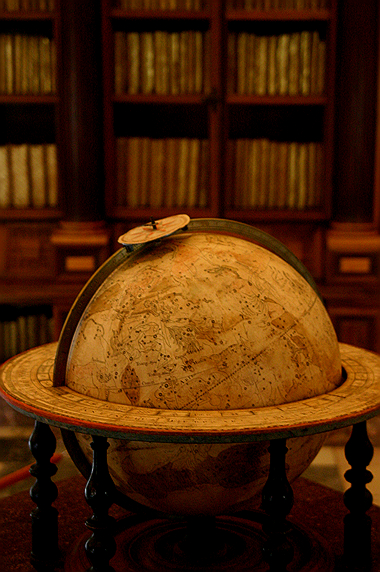 image credit: freeimages.com / Philip A. Shelf IntroductionThere is a particular difficulty involved in stocking this shelf, for the most part: the relevance of books about the reality is at its most marginal, while books about what might be there tend to be few and far between, and mostly focus on the local mythology – which goes in an entirely separate shelf of the library. The only real solution is to present the reality of those places that are undeniably real, with the advice that this should be just the beginning, a jumping-off point – and that GMs should unlimber their creativity. Style and Flavor are at least as important as facts when it comes to these places; be true to the style and flavor, and you can twist and distort the facts as necessary. There are 14 sections on this shelf: The Caribbean Some of the most picturesque waters on earth are to be found around the islands. It’s harder to do these days, but in the Pulp Era it was entirely conceivable that an entirely uninhabited piece of land could be discovered, a tiny speck never seen before. The Caribbean is home to more than 700 islands, islets, reefs, and cays. Four of the most iconic get dedicated subsections: Bermuda, Haiti, Cuba, and The West Indies / Jamaica. Asia There is hardly a single location in the Asian area that has not been transformed in one way or another in the course of the middle- and later-twentieth century. Our recurring theme was to be rather confined in the choices of what to recommend. Even the most politically-stable countries in the region, like India, have undergone massive changes. Africa excluding Egypt Most of the great explorations of the African Continent took place in the 19th century or even earlier, but to most people, much of Africa was still a mystery. At the same time, for each of the African nations, the 20th century contained at least one period of turbulent, blood-soaked revolution in which that nation changed quite radically. Most of what might apply today certainly does not have any validity to a pulp world, so we have tended to be very restrained and judgmental in our approach to this content. The Middle East A region which has changed dramatically since the 1930s in terms of its politics and the cultures of different nations. A huge proportion of anything relevant to real tourists – which is what you mostly expect to find – will be completely irrelevant to a pulp setting. As such we have been both harshly judgmental in choosing content for this section, and have limited ourselves to the one major nation within the region – Turkey, and the city that traditionally stands at the crossroads between East and West, Istanbul. Egypt & Egyptology – There is good reason why the heart of the first Indiana Jones movie centered around Egypt. While the greatest age of discovery in the area took place before World War I, fascination with the exotic architecture of Ancient Egypt and its treasures endures to this day. It is easily the best-known part of Africa, by a margin of hundreds-to-one. We have deliberately restrained ourselves in this section. Of course, adding Pulp sensibilities to this already iconic setting only makes it more exotic! The Atlantic Something of an afterthought, we confess. The North Atlantic in Winter is subject to some of the most hostile weather conceivable on a regular basis, at least in comparison to the rather more placid Pacific. There have been suggestions that this ‘trapped’ Europe’s explorers for centuries, prompting them to turn their attention to the African continent – but the lateness in history of exploration of Africa beyond the northernmost regions casts considerable doubt on this theory in our opinion. At this point, we aren’t sure what we’ll find for this section – it may even be empty. But we’re going to look, and recommend the best of what we find. The Bermuda Triangle – In the real world, this alleged phenomenon has largely been debunked and discredited. In a pulp universe, don’t place any bets either way. Antarctica Underneath the snow and ice of the coldest region of the world there is a for-real continent. If we could only excavate, who knows what fossilized remains might be discovered? Even today, exploration of Antarctica is difficult, dangerous, and has barely begun. We don’t expect to have many entries in this section. The Arctic Rather better known is The Arctic – but in the pulp era it was far from certain that there wasn’t land beneath the ice. Most educated scholars didn’t think there was, but couldn’t be certain. Only explorations beneath the ice shelf by submarine established reasonably conclusively that it was free-floating. The Hollow Earths – We’ve labeled this category Earths, plural, because there are so many conflicting and competing versions of the broader concept of a green and viable environment under the Earth’s surface. Many legends have these accessible through the poles, but recent discoveries of the extent and complexity of the Mexican cave/underground river systems suggest that this may be a viable alternative. (We looked for, but didn’t find, any books on that subject while doing the Mexico section of the last shelf). But Mike is going to look again, so who knows? Lost Cities & Civilizations – As unreal as Hollow Earths and Bermuda Triangles might be in real life, these are completely real – well, almost completely – but are often given a quick touch-up with a fresh coat of paint for Pulp purposes. The real things are just the starting point! Atlantis, Mu, & Lemuria – And, speaking of Lost Cities & Civilizations, the most controversial ones of them all deserves this category of their own. Picturesque Places – We may or may not have anything in this category, which was originally created to hold a single item that has had to be relegated to Honorable Mentions. But Mike is looking for alternatives to recommend and hasn’t yet finished the hunt, so there may be a last-minute inclusion. Strange & Exotic Places – As if the places listed above weren’t strange or exotic enough, we have this final catch-all category for a few leftovers that didn’t quite fit elsewhere, or that fitted multiple categories. Within this miscellanea, there is a dedicated subsection devoted to Florida’s Coral Castle. It won’t surprise us if many of you have never heard of this place. The Coral Castle is a limestone structure created by Latvian-American eccentric Edward Leedskalnin in Florida, supposedly single-handedly by using… well, accounts vary. Anti-gravity, Reverse Magnetism, Telekinesis… somehow, if the myths are to be believed, he was able to move and shape numerous stones weighing many tons, over a period of 28 years, starting in 1923. In 1936, he moved the entire thing ten miles a process that took only three years. No-one knows for sure how he did it, since there is no record of trucks or heavy equipment being used. When asked, Leedskalnin would only say that he “understood the laws of weight and leverage well.”
NB: Prices and Availability were correct at the time of compilation but are subject to change. |
|||

|
|||
Books About The Caribbean
|
|||
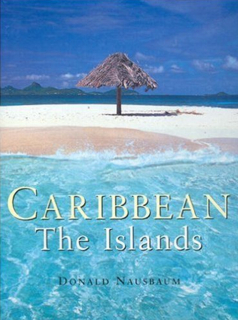
311 Caribbean: The Islands – Donald NausbaumThe only photographic album of the Caribbean that we are recommending, this is a record of the author’s photographic journey through the islands over a period of years, and the results seem comprehensive, encompassing islands from the well-known (Trinidad, Jamaica) to the relatively obscure (The Grenadines). New copies of this 168-page book will set you back $45, but used copies start at just $10. |
|||
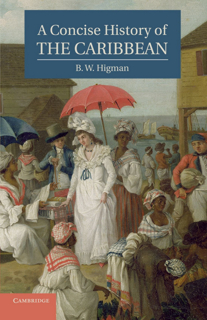
312. A Concise History of the Caribbean – B W HigmanThis is our second choice of history books covering the region; the one that looked the most promising was too expensive (you’ll find it – eventually- in Honorable Mentions). But the margins were small, and this 374-page “concise history” will have to do. Kindle and Paperback. |
|||
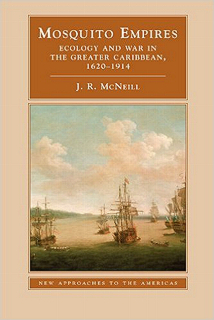
313. Mosquito Empires: Ecology and War in the Greater Caribbean, 1620-1914 (1st Edition) – J R McNeillWhile this book stops short of the pulp era, this book’s premise – exploring the links between ecology, disease, and international politics in the societies of the Greater Caribbean – sounds too useful in understanding the place to ignore. The hardcover is completely out of reach at $90+, but there are Kindle Editions and 26 used copies of the paperback from $15 – and, when they run out, new copies of the paperback can be almost as affordable at $22. |
|||
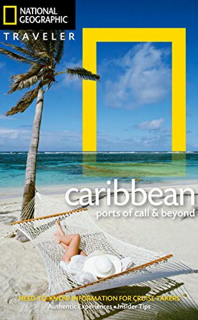
314. National Geographic Traveler: The Caribbean, Ports of Call and Beyond – Emma Stanford and Nick HannaPorts of call “both large and small on islands throughout the Caribbean” are detailed in this travel guide. We expect limited utility from the book in terms of material relevant to the Pulp GM, and the price is quite high – but it also seems to be amongst the best of the broader travel guides to the region. Both used and new copies are available for about $17, and Amazon’s price of $22.51 is comparable once P&H are taken into account. |
|||
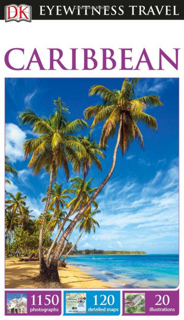
315. Caribbean (DK Eyewitness Travel Guides) – Theresa Storm and James Henderson with photographs by Linda Whitwam, Nigel Hicks, and Demetrio CarrascoThis much-cheaper guide might have been our first choice were it not for some specific problems identified in the customer reviews: “Coverage is superficial even for a guide covering the whole Caribbean. The section on Bonaire had all three ABC islands (Aruba, Bonaire, Curacao) jumped into one mess rather than having separate sections for each island.” “Does not include Southern Caribbean! Aruba, Curacao, etc.”. “I guess the Bahamas and Bermuda are not in the Caribbean…” Those three reports were enough to give us pause. On the other hand, a superficial guide might make it easier to invent the rest, which you would want to do for a Pulp flavor, anyway. It was the reported omissions that really detracted from our appraisal. On top of that, the description seems to focus more heavily on tourist activities than on things to see and experience – “Spotlights the Best Places (their capitalization) to dive, snorkel, sail, and play golf”. There is a newer edition that sounds rather more promising – but is a lot more expensive. In the hope that much of the content of the newer edition was also present in the older one, simply not being highlighted by the publishers, we’re including links to both. 2009 edition (much cheaper): http://amzn.to/2e2wB3J 2016 edition (pictured, more expensive – but still cheaper than the National Geographic offering): http://amzn.to/2dgYM1o
|
|||
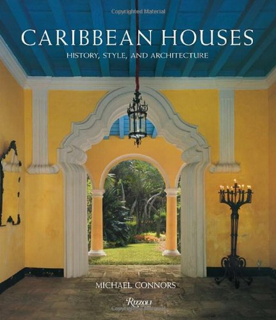
316. Caribbean Houses: History, Style, and Architecture – Michael ConnorsIf only a book like this were available for everywhere – we would happily have included them as standard entries in each subsection! “a lavishly illustrated account of the development of historically significant houses in the West Indies.” “The book is divided into five chapters, one for each European heritage: the Spanish Antilles, the Dutch Leewards, the English Islands, the French Lesser Antilles, and the Danish Virgin Islands.” “Authoritative text sheds light on the area’s … architectural and interior design history and gives the reader a unique view of houses that combine the tradition of European styles with the vernacular island forms and decorative motifs.” By not focusing only on modern buildings, this also sheds light on what the buildings would have been like at other points in history – including the Pulp Era. |
|||

317. Pirates: The True and Surprising Story of the Pirates of the Caribbean – Patrick AuerbachYou can’t talk about the Caribbean without discussing the most famous class of residents ever to call it home. This book, published in January this year, seems to avoid the myths and clichés from Hollywood, just as the title suggests. At a mere 82 pages, however, we have some concerns as to its depth and value for money. Kindle and Paperback. |
|||
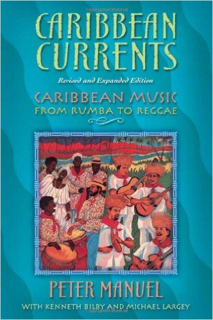
318. Caribbean Currents: Caribbean Music from Rumba to Reggae, Revised Edition – Peter Manuel with Kenneth Bilby and Michael LargeyWe almost didn’t include this book, fearing that there would be little content of value to the Pulp GM. Once again, guidance came from the customer comments more than any of the “official” reviews or description: “We know that much of the world’s contemporary is influenced by Africa and the Americas, but maybe you don’t realize how much of the old music was influenced by colonialism, how Cuban music ended up in Baroque music of the 1600’s … for example.” Which convinced us that this was a comprehensive guide that would encompass the pulp era and not simply be about the modern day, musical culture having changed so radically since that time. New copies start at $22 but used copies are more affordable. |
|||

319. Peoples and Cultures of the Caribbean: An Anthropological Reader (1st Edition) – Michael M HorowitzUnless you’re silly enough to buy a new copy of this 1971 book, copies are surprisingly affordable. The thinness of the description leads one to expect a pamphlet or thin booklet at best, an impression reinforced by Amazon’s generic “cover image”. A glance at the details reveals otherwise: this is 606 pages and published by the Natural History Press, who have a reputation for publishing reasonably solid references. |
|||
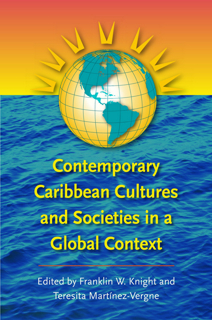
320. Contemporary Caribbean Cultures and Societies in a Global Context – Edited by Franklin W Knight and Teresita Martinez-VergneWe were very back-and-forth on the inclusion of this book. It could be absolutely brilliant and insightful, or it could be totally academic and entirely too modern-day to hold any relevance to the pulp GM. Quite frankly, we weren’t – and aren’t – sure. So we are listing it anyway, and quoting Amazon’s description in full: “The Caribbean ranks among the earliest and most completely globalized regions in the world. From the first moment Europeans set foot on the islands to the present, products, people, and ideas have made their way back and forth between the region and other parts of the globe with unequal but inexorable force. An inventory of some of these unprecedented multi-directional exchanges, this volume provides a measure of, as well as a model for, new scholarship on globalization in the region. “Ten essays by leading scholars in the field of Caribbean studies identify and illuminate important social and cultural aspects of the region as it seeks to maintain its own identity against the unrelenting pressures of globalization. These essays examine cultural phenomena in their creolized forms – from sports and religion to music and drink – as well as the Caribbean manifestations of more universal trends – from racial inequality and feminist activism to indebtedness and economic uncertainty. Throughout, the volume points to the contending forces of homogeneity and differentiation that define globalization and highlights the growing agency of the Caribbean peoples in the modern world.” In terms of illuminating the processes that have resulted in everything from Reggae to Vodou, this could be absolutely brilliant. Or it could be completely irrelevant. Make up your own minds. New copies are expensive at $26+, used copies start at $7.40, and there is a $14 Kindle edition. |
|||
Books about The West IndiesThe West Indies comprise three separate subregions of the Caribbean: The Lesser Antilles, the Greater Antilles, and the Lucayan Archipelago. In some contexts, it can also be synonymous with the entire Caribbean Basin, and even areas with a cultural connection beyond mere Geography – the West Indies cricket team includes members from Guyana, which is actually part of South America. The Greater Antilles includes the Cayman Islands, Cuba, the Dominican Republic and Haiti, Jamaica, and Puerto Rico; The Lesser Antilles comprises 24 nations; and the Lucayan Archipelago includes the Bahamas. Several of these have been given dedicated sub-sections; these are books about the area generally, or about the rest. |
|||
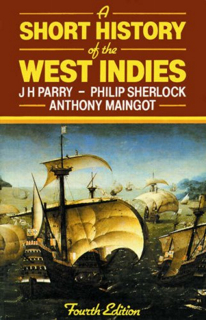
321. A Short History Of The West Indies (Fourth Edition) – J H Parry, Philip Sherlock, and Anthony MaingotAmazon only list the first of the authors and provide virtually no information about the contents of this book. The information that sold us on including this work comes from one of the customer comments: “This is a very readable history of the islands in the Caribbean. There also is some supporting discussion of mainland British colonies. The material generally is informative and the writing generally is reasonably good. “Probably the major advantage of this book compared to alternatives is the solid discussion of the political development of the islands in a way that is easy to follow and remember. With so many disparate islands being discussed, it is easy to get lost. The discussion clearly distinguishes between the larger and smaller islands and that makes it all clear.” There are some drawbacks regarding typographic errors and authorial stylistic changes partway through the book, but those don’t detract from the clear value of the book to the Pulp GM. |
|||

322. The West Indies and the Spanish Main – James RodwayThe first of two books by the same name by different authors. We know next to nothing about this particular one except the title and author and the fact that it is an old book that has been reprinted by scanning the old text. From the single customer review, we can see that it’s a history of the region, and that the reviewer thought it was well-written. This book is only 114 pages in length, so there is no chance that the two titles refer to the same book. There are only just enough copies to clear our minimum requirements but those tend to be on the cheap side, and the Kindle edition is free. There appears to be no contents page. |
|||
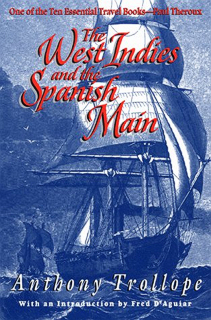
323. The West Indies and the Spanish Main – Anthony Trollope“British Postal Service employee and successful Victorian novelist Anthony Trollope sailed aboard the Atrato from the English port of Southampton to Kingston, Jamaica, in November, 1858 to survey land and conclude treaties in the West Indies and Central America for the English government. In the course of his extended sojourn, he also wrote a book — not about official business but rather about the islands he visited and the people he met; about breathtaking landscapes, exotic foods, the tropical climate, earthquakes, Panamanian railroads, Cuban cigars, racial hierarchies, and colonial customs.” 1858 is, of course, quite a distance removed from the Pulp Era – some sixty years, in fact – but colonial subjects like the West Indies changed relatively little in that time, and a lot of the content will remain useful to the Pulp GM, especially for flavor content. This book is 384 pages long – hence the certainty that this is not the same as that previously listed. |
|||

324. Pirates of the West Indies – Clinton BlackTo look at the cover, you might think this is a children’s book. It’s not; it is, instead, a short book (144 pages) published by Cambridge University Press, providing a “concise history of the lives of ten of the most important pirates of the Caribbean Region” that “sheds new light on popular notions of piracy and stereotyped conceptions”. There are lots of cheap copies, both hardcover and paperback. |
|||
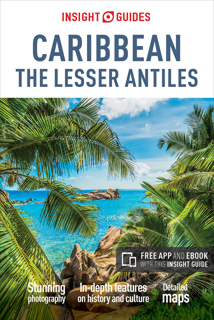
325. Insight Guide to the Caribbean and the Lesser AntillesThe Lesser Antilles are a chain of tropical islands that stretch from the Virgin Islands to Trinidad and Aruba. This travel guide lists a number of landmarks that would have existed and made great specific locations in a Pulp Campaign such as the Brimstone Hill Fortress in St Kitts. We liked the promise of “descriptive place-by-place accounts” and the promise of “detailed high-quality maps”. While this book is 368 pages, it also comes with an app that delivers the information like Hotel Recommendations and prices that are subject to change – and are of no interest to the Pulp GM; we hope that this means that this space-filler has been excluded from the text itself, leaving a greater preponderance of useful material. This book has only been released last month, so it is very new, but already Amazon has almost sold out of it, having only 15 copies left in stock – but it would be cheaper to buy from one of the third-party vendors, anyway. The misspelling of “Antilles” on the cover is a bit of a concern, though. |
|||
Books about Bermuda
|
|||

326. Fodor’s Bermuda Travel GuideWe have two travel guides to discuss that focus on this famous resort destination – because we could not choose between them. Choice number one is Amazon’s best-selling travel guide to Bermuda, available in two different editions – a 2014 one of 240 pages, and the 2016 edition of 224 pages. We always find shorter page counts to be a concern. That said, these do look to be excellent guides to more than the usual tourist traps and activities – not that Bermuda, at just over 20 square miles, has all that much room for anything more. 2014 edition (pictured, much cheaper, Kindle and Paperback): http://amzn.to/2dh2RSZ |
|||
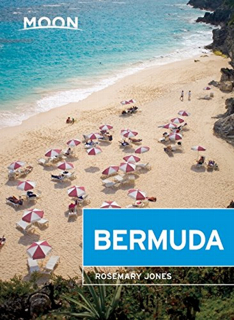
327. Moon BermudaUsually, we prefer books written by a local resident. Moon’s guide to Bermuda is just such a book, and at 368 pages, it’s getting close to double the length of Fodor’s. That means a lot more content. Time-wise, this fits right in between the two editions of Fodor’s. Counterbalancing those advantages is the book’s description, which seems a lot more tourist-oriented, and the excerpt provided on getting Married in Bermuda, which is full of wonderfully-useful detail – for a campaign set in the modern day. Price-wise, this sits in-between the two editions of Fodor’s as well – and therein lies the rub: we can’t tell, from the information provided, how much of the content is relevant, but the topic is too minor (in pulp terms) to recommend buying both. So we leave the buying decision in the hands of the reader. |
|||
Books About HaitiHaiti was devastated in 2010 by an Earthquake that was just the latest in a string of political, social, and economic disasters. There are a number of scathing books about the relief efforts and the impact of corruption and vested political & religious agendas in the aftermath. Even before this tragic event, Haiti was synonymous with political instability; Mike can remember the statement “It’s Wednesday, there must be a coup in Haiti” seeming both accurate and withering in the early 80s or 90s. All of which makes it very difficult to find books whose content is not contaminated by post-pulp events. |
|||
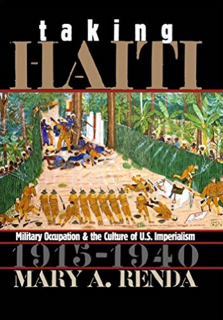
328. Taking Haiti: Military Occupation and the Culture of US Imperialism, 1915-1940 – Mary A RendaIn 1915, the US invaded Haiti and began a military occupation that would last for nineteen years. This explores what Americans thought and wrote about Haiti in that period, which completely overlaps the Pulp era. It’s that direct relevance that elevates this book over the broader history below. |
|||
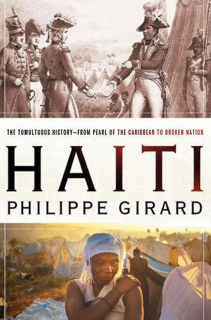
329. Haiti: The Tumultuous History from Pearl of the Caribbean to Broken Nation – Phillippe GirdardThis book explores the cumulative effects of multiple failed attempts by the US to create a stable democracy in Haiti, coupled with the legacies of colonialism and slavery dating back to the War Of Independence (1791-1804) and the ever-present poverty of “The poorest nation in the Western Hemisphere” have created the political instability for which Haiti is renowned, painting a portrait of a population caught in a trap, an endless cycle of corruption, revolution, and failure. |
|||
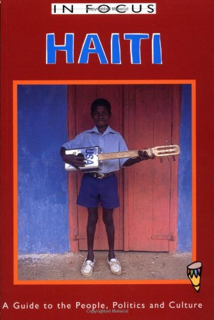
330. Haiti in Focus: A guide to the People, Politics, and CultureThe description of this book makes it clear that it looks beyond the popular perceptions of Haiti to the real people and culture, and adds to the themes of the book listed above in the process. The best guide to the populace of Haiti and their culture that we could find. |
|||
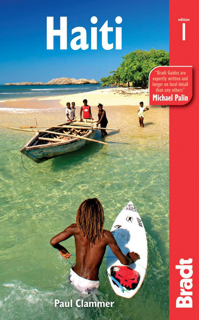
331. Haiti (Bradt Travel Guide)- Paul ClammerThis 2013 book claims to be the only stand-alone guidebook on Haiti on the market. That wasn’t true when it was published, and isn’t true now, as our next recommendation will make clear. Nevertheless, there’s a lot of content that looks interesting and useful – “…packed with practical information covering … travel routes, wildlife and Vodou … insightful information on Haiti’s rich artistic and musical heritage… and … discusses the medicinal merits of Haitian rum”. Customer comments are lavish with praise. |
|||
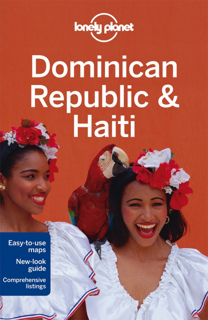
332. Lonely Planet Dominican Republic & Haiti – Paul Clammer, Michael Grosberg, and Kevin RaubThis guidebook dates from 2011 and was co-written by the author of the previous recommendation. The contents listing suggests that this contains a lot of useful information that the previous listing may lack, including an annual festival calendar, over 39 local maps, and coverage of many of the cities and towns. Amazon claims there is a newer edition but the titles don’t match. Because this is a very out-of-date book, however, it is very inexpensive. |
|||
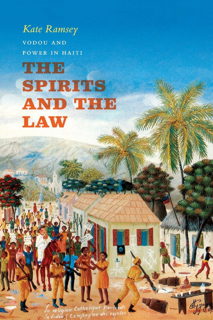
333. The Spirits and the Law: Vodou and Power in Haiti – Kate RamseyThe vexed history of the Haiti political leadership and their relationship to the religion of Vodou, banning many of the key practices (and sending the worship underground). This book provides context and motivation for many of the events discussed in earlier recommendations (323, 324, 325, and 326). We’re not sure of how much relevance there is for the Pulp GM, and that’s the only reason this book is languishing at the end of this subsection. Technically, it’s too expensive to include, but in terms of telling “the whole story” it looked too useful to ignore. |
|||
Books about Cuba
|
|||
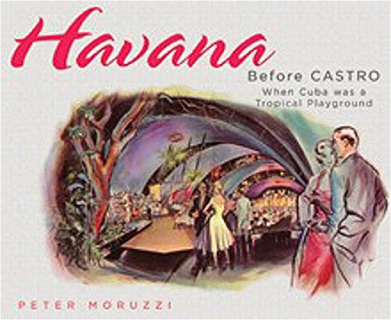
334. Havana Before Castro: When Cuba Was A Tropical Playground – Peter Moruzzi“Hundreds of vintage photographs, postcards, brochures, and other materials evocative of [the] time and place”, this collection “documents how the city of Havana evolved from a Prohibition haven and rich man’s playground” (in the Pulp and Pre-Pulp Era). 256 pages, which is quite large for this kind of collection. Kindle and Perfect-bound Paperback. The text should be equally valuable as reference for the Pulp GM. |
|||
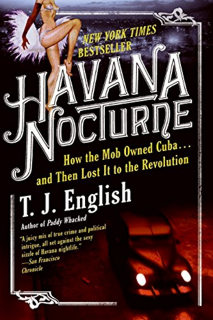
335. Havana Nocturene: How the Mob owned Cuba and then lost it to the Revolution – T J English“To underworld kingpins Meyer Lansky and Charles “Lucky” Luciano, Cuba was the greatest hope for the future of American organized crime in the post-Prohibition years. In the 1950s, the Mob – with the corrupt, repressive government of brutal Cuban dictator Fulgencio Batista in its pocket – owned Havana’s biggest luxury hotels and casinos, launching an unprecedented tourism boom complete with the most lavish entertainment, top-drawer celebrities, gorgeous women, and gambling galore.” Although principally focused on a post-pulp era, there are a number of references to how the Mob reached the level of ascendancy described in the above description. And you can always twist history to bring the Gangster’s Paradise into existence early, with this as a foundation – or perhaps giving the PCs a chance to slow the takeover would be more satisfying? Clearly you have options for how to employ this material, but it definitely deserves a place in this list. |
|||
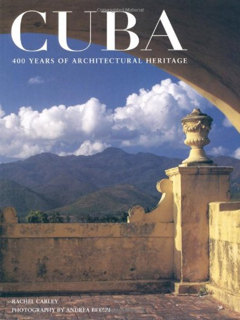
336. Cuba: 400 Years of Architectural Heritage – Rachel Carley and Andrea BrizziAnother photographic album, but this one dedicated to the architecture of Cuba. Rare photographs and “exquisite” commentary. There are four or five books on this subject, but most are in the $60+ price range; New copies of this in hardcover form are the same, but there are very affordable used copies of the paperback, and almost-affordable used copies of the hardcover. 224 pages, again fairly lengthy for this sort of book. |
|||
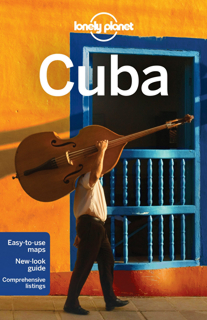
337. Lonely Planet Cuba – Brendan Sainsbury and Luke WatersonThere aren’t many travel guides to Cuba yet, and too many of them would not be relevant to the pulp GM anyway; too much has changed since the 1930s. We’ve selected this one because it includes sections on the history, architecture, cuisine, music, dance, landscape, wildlife, literature, arts, and politics of Cuba, has over 80 color maps inside, and (possibly missing if you buy used) a free pull-out map of Havana in the print version only. 544 pages. |
|||
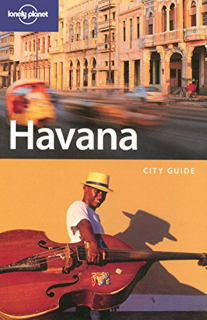
338. Lonely Planet Havana (City Travel Guide) – Brendan SainsburyThe perfect accompaniment to the map in the preceding travel guide is this book from the same travel line, and written by one of the two authors of the Cuba guide. |
|||
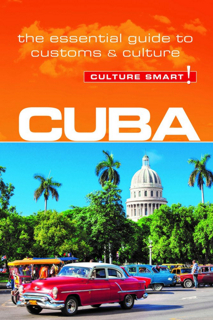
339. Cuba Culture Smart – Russell MaddicksAs with the travel guides, our great concern is that there will have been too much change in the Revolution and Castro years for this to be relevant. The description of this book suggests that, in fact, very little changed from the time Castro took over until the thawing of relations with the US; the country was stuck in a “cold war time warp” that is only now beginning to change as the nation stumbles headlong into the 21st century. “Culture Smart! Cuba will take you beyond the usual descriptions of Havana nightlife, vintage cars, and hand-rolled cigars and give you an insider’s view of an island that is teetering on the brink of historic change. It offers insights into Cuba’s fascinating history, national icons, unique food, vibrant cultural scene, and world-renowned music. Practical tips help business travelers gain an edge on the competition. But most of all, this book aims to show you how best to break the ice and get a better understanding of the infinitely resourceful Cuban people, who despite severe hardships and shortages over many years remain optimistic and fiercely proud of their heritage and culture.” There’s a much smaller cultural step from the Cold War back into the Pulp Era, and the key phrase in the preceding quote is “teetering on the brink” – meaning that most of the content is actually going to be fairly relevant. |
|||
Books about Jamaica
|
|||
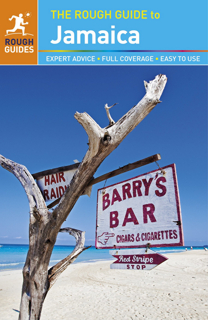
340. The Rough Guide to Jamaica – Robert Coates and Laura HenzellWe’ve recommended a lot of the Rough Guides because they have a tendency to include useful information that other travel guides lack, excluding them only when there are reports of omissions or significant errors. While none of the commentators indicate that this is or is not the case in this particular book, they rate the book very highly. Lots of copies available and new doesn’t cost that much more than used. There is also a Kindle version. |
|||
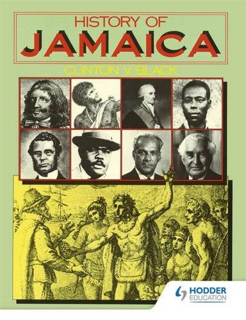
341. History Of Jamaica – Clinton BlackBlack is the Government Archivist for Jamaica, making this 176-page book as definitive as it gets. There is a reported bias against Europeans in the history, but they didn’t exactly cover themselves in glory during their ascendancy over the island – the Spanish period, the British Occupation, the introduction of slavery and the sugar plantations, and the British Colonial period which was followed by independence from 1962. |
|||
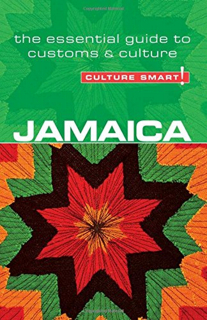
342. Jamaica Culture SmartLike many places, the mass media have sensationalized the dangers and stereotyped perceptions of Jamaica. In defiance of these perceptions, and despite genuine economic and social problems, Jamaica is regularly ranked among the five happiest nations on Earth in the annual Happy Planet index. This book promises to take you beyond and behind the clichés. Paperback and Kindle. |
|||
Books about The Panama CanalWork commenced on a Canal across the Panama Isthmus to connect the Pacific and Atlantic oceans in 1881, but France abandoned the project in 1894 due to engineering problems and a high worker mortality rate. In 1904, the United States took over the project and completed it in 1914. In the first 6 months of its operation, 1,000 vessels made the six-to-eight hour passage through the Canal, a tally that has risen steadily ever since, reaching a peak in 2008 of 14,702 transits. It is a key strategic location in world commerce and has been since its opening. |
|||
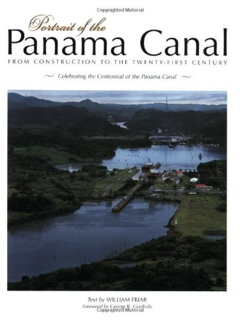
343. Portrait of the Panama Canal: From Construction to the Twenty-first century – William FriarA collection of historic and contemporary photographs and accompanying text to celebrate the centenary of the initial groundbreaking on the Panama Canal. At 80 pages, an unusually small collection, but at least some of them, probably hard to find, should be from the Pulp Era and copies are extremely cheap – used copies start at 1 cent. |
|||
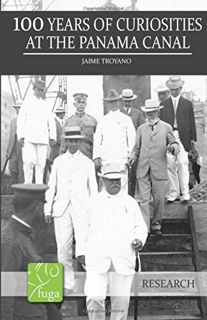
344. 100 years of curiosities at the Panama Canal – Jaime A TroyanoThe first of two books by Troyano, who worked as a guide for the Panama Canal Authority for 15 years. He began collecting photos and anecdotes about the canal’s history with which to regale the tourists he was escorting, and turned them into this book. Kindle and Paperback. |
|||

345. Panama Canal Facts, Myths & Legends – Jaime A TroyanoThe origins of this book are obviously the same as that previously listed. This doesn’t quite meet our normal standards of availability, but the source is sufficiently authoritative and the adaptability of that content that isn’t directly relevant is likely to be high, so an exception has been made. |
|||
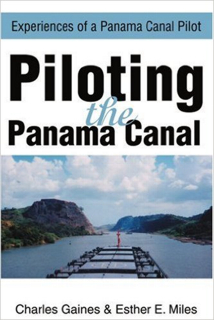
346. Piloting the Panama Canal: Experiences of a Panama Canal Pilot – Esther MilesAnd, speaking of authoritative sources, the author of this book spent “many years” as a pilot responsible for guiding vessels through the Canal, and through her eyes, the reader comes to see life as it actually was along the Canal (the Suez might dispute the appellation of ‘most famous canal in the world’). This focuses on the period before the Americans signed a treaty handing control of the Canal over to Panama. Along the way, you get introduced to the famous and infamous people who passed through this part of the world – some of whom may be pulp relevant. Even if not, though, it seems most unlikely that there would have been substantial change in the nature of this job from the Pulp Era, and it is that relevance that earns this book a place on our list. New and Used copies are the same exact price at the moment. |
|||
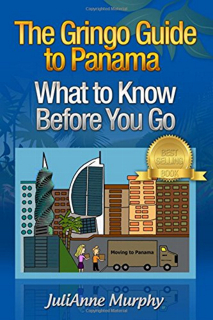
347. The Gringo Guide to Panama: What to know before you go – JuliAnne MurphyIn 2008, expat and author Murphy relocated to Panama for business reasons; the experiences of the next two years led to this book, in which she describes all the things that she wished she had known before making the move but didn’t know to ask in advance. |
|||
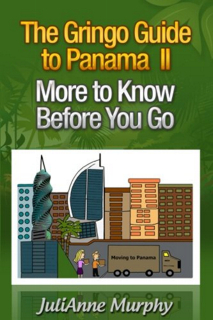
348. The Gringo Guide to Panama II: More to know before you go – JuliAnne MurphyThe sequel to the previous recommendation. This was not as well received by readers, several of whom were under the impression that this was a revised edition and not a sequel. There are reportedly a lot of comments within the book pointing to the earlier volume, which may become annoying after a while. In general, the first book is the more essential, while this contains more personal anecdotes and color. |
|||
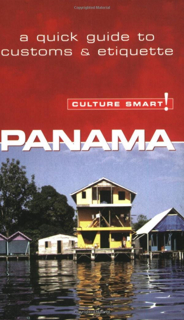
349. Panama Culture Smart – Heloise CrowtherThe product description is a canned series description, but customer comments suggest that this book fulfills the brief quite successfully. “It covered all of the basics of the customs, culture, history, food, etc. for what turned out to be a very charming country. This book is a must read for anyone that is traveling to Panama and wants to go beyond the boundaries of a guided tour or 4 star hotel stay. If you prefer to get to know the people and culture of Panama choose this quick read to get you started.” 168 pages, which is a little more substantial than a “quick read” in our opinion. |
|||
 |
|||
Books about Asia
|
|||
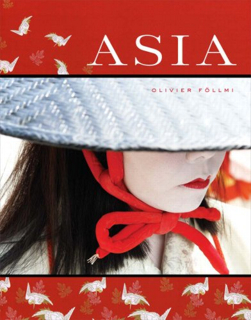
350. Asia – Oliver FöllmiThe fourth volume in a series of photographic collections sponsored by Harry N. Abrams’ project Offerings for Humanity, this book contains images from Burma, Japan, China, and Vietnam, and many points between, all taken by Föllmi. This is not a lightweight collection; 352 pages, and each of them is 11.6 x 14.8 inches in size. Expect postage to be higher than usual. The Hardcover starts (new) at $24.95 ($65 through Amazon) but used copies can be a mere $16.95. |
|||
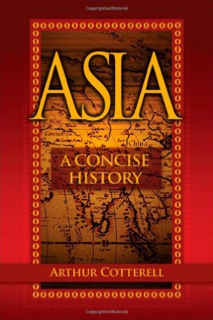
351. Asia: A Concise History – Arthur CotterellThis history appears more comprehensive than we thought possible. starting with Assyria and Persia and ending somewhere close to the modern day – certainly World War II and its aftermath are included. Used as the textbook for a number of “History of Asia” classes. Of course, squeezing more than 3000 years of history for such a vast geographic region into a mere 450 pages, not everything can be reported in detail. Nevertheless, the author is not afraid to incorporate snippets and sidebars of little historical relevance but acute interest and flavor. While the book does refer to dates on occasion, it prefers to adopt a narrative approach that is reportedly easy to read. Kindle and Paperback. |
|||
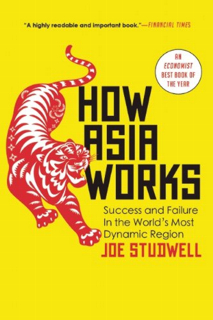
352. How Asia Works – Joe StudwellSome Asian countries have boomed, economically, over the last 35 years or so, while others have stagnated. Studwell boils the economies of nine Asian nations – Japan, South Korea, Taiwan, Indonesia, Malaysia, Thailand, the Philippines, Vietnam, and China – into narrative form that anyone can follow, “debunking Western misconceptions, show[ing] what really happened in Asia and why, and for once makes clear why different countries have prospered while others languish. This 400-page book has been praised by everyone from Bill Gates to the Financial Times; 70 customer reviews average about 4.5 out of 5. Hardcover, Kindle and paperback. Paperback: (pictured, costs about the same new as used, $10) http://amzn.to/2d69jxC Hardcover (costs about the same new the paperback, cheaper than paperback used, fairly plain cover): http://amzn.to/2dLuCq9 Kindle from either of the above links $8.22. |
|||
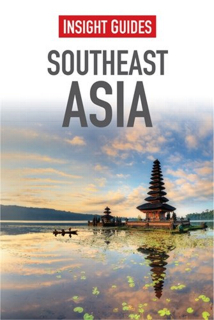
353. Insight Guide to Southeast AsiaThere aren’t many tourism guides that cover the entire Asian region, or even a significant part thereof, and most are too modern-day-tourist in orientation. This appears to be the best of them, describing an “unrivaled range of amazing experiences and unforgettable sights – from the northern hills of Thailand to the dragons of Komodo, frenetic Manila to laid-back Vientiane, the sands of Ko Samui to Balinese temples and the ruins of Angkor Wat”. Throw in a photograph on (almost) every page and “detailed, high quality maps throughout” and affordable prices both used and new, and it was impossible to go past it. |
|||
Books About China
|
|||
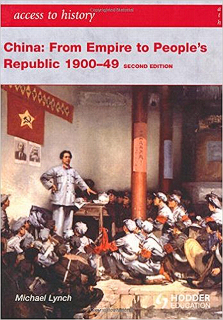
354. China: From Empire to People’s Republic 1900-49 (2nd Edition) – Michael LynchWe’re accustomed to thinking of Imperial China as being from Centuries ago, and indeed, the first emerged around 2070 BC – so long ago that the Xia Dynasty was considered mythical until archaeological evidence for a Bronze Age dynasty was uncovered in 1959. The Xia were succeeded by the Shang, which is the earliest to be confirmed by contemporary records, and ruled for roughly 600 years circa 1600 BC. And so it comes as some surprise to many that the last Dynasty, the Qing, only fell from power in 1912, only six years prior to the Pulp Era. It was replaced by a Republic. A period of political instability followed this transition, and a modicum of stability was finally forcibly achieved in 1928 by General Chiang Kai-Shek, until he in turn was overthrown in the Chinese Civil War in 1949, founding the People’s Republic Of China. This history details this turbulent period. Normally, we look for the older editions first as they are generally cheaper, but that was definitely not the case on this occasion; the first edition is now priced at $60 or more, while the newer edition is far more affordable. Paperback only. |
|||
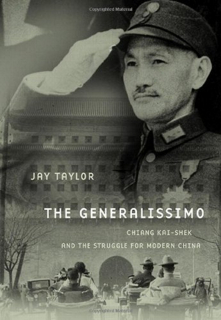
355. The Generalissimo: Chiang Kai-shek and the Struggle for Modern China – Jay TaylorWe almost didn’t include this book, and we almost included it on the Second Shelf in the “notable real people” section. Ultimately, it was decided that the historical content outweighed the biographical. A deeply complex individual who was at once progressive and ruthless, conscientious and at the same time, temperamental. Understanding him is essential to understanding the China of the Pulp Period – unless, of course, you decide to extend the existence of Imperial China (there are other books below for you if that’s your intent). Even then, we suspect that the General would find himself at the center of events, either the strongest supporter of Government or its greatest enemy. Used copies of the hardcover are cheaper than copies of the paperback, either new or used, but new hardcover copies are quite expensive. While the used hardcovers last, those would be our recommendation – followed by the paperbacks, either new or used, once the price of the Hardcovers exceeds $11. |
|||
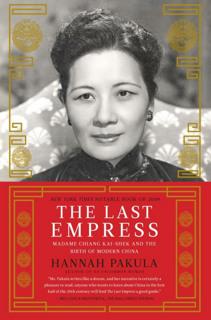
356. The Last Empress: Madame Chiang Kai-shek and the Birth of Modern China – Hannah PakulaHer husband may have behaved like a Dictator, his wife behaved like an Empress. You might think from that information that she was raised in a traditional Chinese manner, but she was in fact a Christian born to wealth and educated in America. She was inarguably a potent political force in Pulp-era China. Again, the most obvious place for this book is in the “Significant Real People” section, but the inclusion of period photographs and (most especially) maps, along with her undeniable influence over the history of China, made its relocation to this section a no-brainer. Kindle and Paperback, and much cheaper through third-party vendors (new or used). |
|||
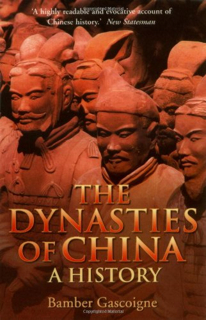
357. The Dynasties of China: A History – Bamber GascoigneSix short years. The Pulp GM has three basic options when it comes to Pulp-era China. The first is to reflect the real history, in which there is nominally a republic, ruled by what is effectively a dictator, while civil war brews in the hinterlands; the second is to bring forward and amplify that period of unrest; and the third is to extend the life of the Chinese Empire. Any of these is extremely Pulp in tone. If you choose the latter option, you will need a history of the Empire and its Dynasties; we’re listing two, both by the same author. At 304 pages, this is the longer of the two. The hardcover is completely out of reach at $63 (used) and $89 (new), and new copies of the paperback are only half as unreasonable at $37+ – and all of them very limited in numbers. But there are cheap and reasonably-plentiful used copies starting at just $2.16. |
|||
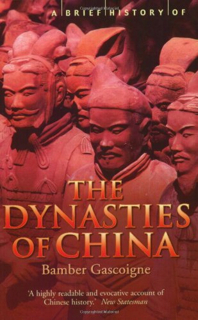
358. A Brief History of the Dynasties of China – Bamber GascoigneWith virtually the same cover and definitely the same author, you might mistake this for being the same book. It’s not – this is only 240 pages, and a lot cheaper. In terms of customer ratings, the two are distinguished only by plentiful reviews of the first and a paucity for this book; the overall ratings are virtually identical. The product description separates the two; the first is a proper history, while this book examines the subject by narrating the stories of representative real-life figures from each historical period. The two do not conflict or even overlap; they are complimentary. |
|||

359. A Brief History of the Boxer Rebellion: China’s War On Foreigners, 1900 – Diana Preston“Fueled by hatred of foreigners and all they stood for, the ferocious uprising of Chinese peasants and ensuing siege of Peking in the summer of 1900 sent shockwaves around the world.” The rebellion only lasted for 55 days, but it shaped world perceptions of, and relations with, China for decades, and was one of the first signs of the imminent collapse of Imperial Rule. |
|||

360. Forgotten Ally: China’s World War II, 1937-1945 – Rana MitterWhen did the Pulp Era end? The rough end-point that we have been using is the start of World War II, just as the beginning is the end of the Great War – but when exactly is that? The official date is 1939, when Britain and France declared war on Germany over the invasion of Poland, but Pulp Adventures within the US (and a large part of the rest of the world) are clearly possible beyond this date. Perhaps it is the date of US entry into the War – Pearl Harbor? Even then, if given an intelligence or counter-espionage slant, Pulp adventures are possible. These become far more problematic after D-Day, so that has to be the “outer marker”. But those are not the only possible dates. If one considers the Pulp Era to end in a gradual transition from pulp to post-pulp, when did that transition start? The start of the War, obviously – but, again, when was that? 1939? Pearl Harbor? Or perhaps it was earlier – The Spanish Civil War is often seen as a precursor to WWII. Or, arguably, the Japanese invasion and occupation of China in the Second Sino-Japanese War (1937-1945), which commenced two full years before the invasion of Poland. Beyond the obvious participants, this also involved the UK, Soviet Union, and the USA – a noteworthy coalition. This book reveals the “drama of invasion, resistance, slaughter, and political intrigue”. And, while it marks the beginning of the end of the Pulp Era, it conclusively does not mark the end of the end; at least some of the events of this period lie within that period. This is a part of history that the GM of a pulp campaign needs to know about. 464 page hardcover or 480 page paperback; we have linked to the former format because copies are cheaper (and note that new copies are currently cheaper than used). |
|||
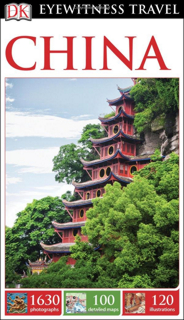
361. DK Eyewitness Travel Guide: ChinaThe 2014 edition is, according to customer reviews, a flawed book that nevertheless has an average rating from 37 reviews of 4.3 out of 5. 660 Pages, with the usual maps and floor-plans that you would expect in a DK Eyewitness Travel Guide, the four complaints of substance that stood out to us are 1. That while it is detailed, it is insufficiently so; 2. that this is particularly true concerning travel within China; 3. that the coverage outside the major cities and tourist attractions ranges from spotty to nonexistent; and 4, at least one reader perceived a strong racial prejudice against the Han Chinese, the largest ethnic group within China – though we looked for evidence of this prejudice without success in the extracts provided by Amazon. Most of these complaints are not replicated in the 2016 edition, which is also 660 pages, though it is reportedly still poor in the logistics and relies on comparatively poor photography. A bonus for our purposes is that most of the new structures created for the Olympics are ignored, leaving more room for the potentially-relevant. Nevertheless, these are the highest-rated travel guides to China, which is only slowly (and somewhat reluctantly it seems) coming to embrace to the tourist trade. Both have different authors cited, making it harder to choose between them; we are recommending the more recent one as the best choice, but also including a link to the older and much cheaper edition. 2016 edition (pictured) ($12-19): http://amzn.to/2e5UBIu 2014 edition ($0.01-$6): http://amzn.to/2e7Jw4n |
|||
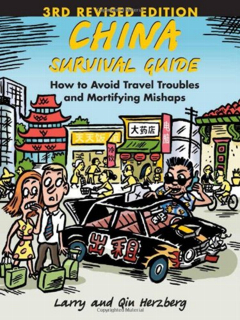
362. China Survival Guide: How to Avoid Travel Troubles and Mortifying Mishaps, 3rd Edition – Larry & Qin HerzbergPocket-sized with 264 pages. Includes “practical strategies for lodging, walking, haggling, medical and bathroom emergencies, etiquette, crowds, and learning the twin arts of patience and persistence”. Tackles its subject with humor and panache. One customer review from 2009 complains that it’s out of date, others from 2012 praise its accuracy, which leads us to suspect that the content may not apply to the entire country. Paperback and Kindle. |
|||
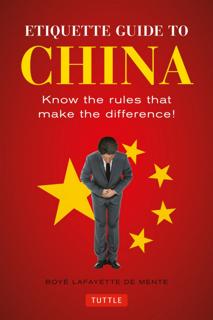
363. Etiquette Guide To China: Know the Rules that Make the Difference! – Boye Lafayette De MenteThis might have topped our list, but it’s been completely revised and brought up-to-date to incorporate the etiquette of the Digital Age and the impact of modern commercialism on China. 192 pages, significantly shorter than the previous offering – though the “China Survival Guide” used an unknown amount of space for personal anecdotes (many of which should make good incidental encounters, properly “massaged” by the GM). |
|||
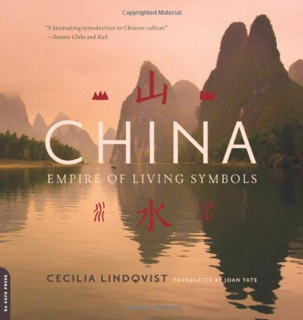
364. China: Empire of Living Symbols – Cecilia LindqvistThere are more than 50,000 Chinese characters in use today, and all of them are ideographs, also known as ideograms – which is to say that each represents a complete and whole idea. Unless you read the Wikipedia page on ideograms, which strongly refutes this as a general principle, then discussing technical concepts generalized to cover the entire field. That, plus the product description and professional reviews, leave room to suggest that while they may have evolved since, the origins of the Chinese characters were ideographic in nature. Because the alternative is that Publisher’s Weekly, the Boston Globe, and London Review of Books are all idiots or armchair experts who got their reviews wrong in exactly the same way. Not impossible, but rather improbable – Occam’s Razor suggests that the more likely explanation is more likely to be the correct one, until further evidence to the contrary is presented. Having thereby argued the expertise and validity of the content of this book, what is that content? “The origins of Chinese ideographs were not known until 1899, when a scholar went to an apothecary for some medicine made of “dragon bone.” To his surprise, the bone, which had not yet been ground into powder, contained a number of carved inscriptions. Thus began the exploration of the 3000-year-old sources of the written characters still used in China today. In this unparalleled and deeply researched book, Cecilia Lindqvist tells the story of these characters and shows how their shapes and concepts have permeated all of Chinese thought, architecture, art, and culture.” In other words, the history of the language provides context for, and shapes, the culture. Which makes perfect sense to us – and justifies including this reference on the subject. Kindle and paperback, with used copies for just one cent. |
|||
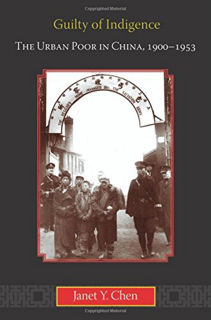
365. Guilty of Indigence: The Urban Poor in China, 1900-1953 – Janet Y ChenWe are always a little wary of books written about areas of strong political control, unsure as to how close the author has had to toe “the party line”. If the publisher or author are from a more liberal nation such as the USA, those concerns are generally alleviated. In this case, we are told nothing about the author but the name, but the publisher is Princeton University Press, so the likelihood is that it is as independent of political interference as you are going to get. In the early 1900s, poverty became the central issue for the future of China. This book studies the lives of the poor in this critical and chaotic period, the policies by which the government attempted to ameliorate the driving force behind growing political instability (and, ultimately, a “people’s revolution”), and the public attitudes toward the poor as they changed over time. Focuses particularly on two of China’s largest cities, Beijing and Shanghai. 320 pages, Kindle and Paperback. Note that at the current time, Used and New copies through third-party vendors were the same exact price. |
|||
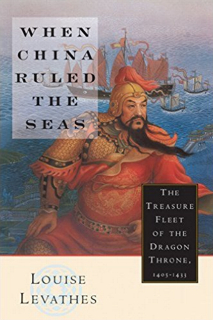
366. When China Ruled the Seas: The Treasure Fleet of the Dragon Throne, 1405-1433 (Revised edition) – Louise Levathes“1405-1433”? You may be wondering what this book is doing here. But lost Chinese treasure ships make a great MacGuffin, and the ‘miraculous’ survival in suspended animation of such a ship is always possible – in a pulp campaign! 256 pages, published by Oxford University Press. Kindle, Hardcover, Softcover, from $5.81. |
|||
Books about Beijing (known in the West as “Peking” in the Pulp Era)
|
|||
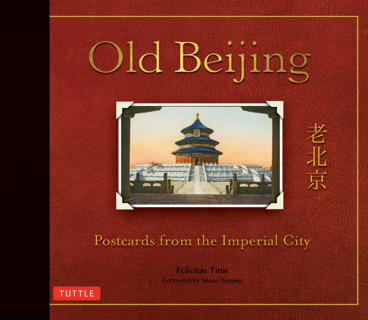
367. Old Beijing: Postcards from the Imperial City – Felicitas TitusThere are two editions of this collection of more than 350 vintage photographs and postcards; we have linked to them both, below. The images are accompanied by “extensive” historical background and commentary, but the images dominate, usually three or four to the page. With that many images on each, page size becomes important: 10.5 x 9 inches is adequate, but we don’t recommend the Kindle edition unless you are very comfortable perpetually zooming in and out. These are the sort of images that you won’t find on the net; you may find similar images from elsewhere but they will lack the authenticity that these provide, a surprising number of which are in color. We were unable to determine what the content differences are between the editions, but suspect that the thawing of relations between China and the outside world over recent years has given the author access to records that were not available at the time of the first edition – a lot has changed in the four-year interval between the two. Pricing is interesting to compare. Both Kindle editions are the same price and may in fact be identical. The older edition costs from $10.31 to $32.50 for the hardcover, and there are 15 used and an unknown number of new copies; the newer edition costs from $12.43 used, with only 13 copies available, and from $10.99 new, with 43 available. Amazon themselves are charging $13.32 for the new edition, but report that they have only 4 left in stock. This is actually the cheapest price, once postage and handling are taken into account. At those prices, we recommend buying from Amazon until copies run out; then new copies of the new edition until they get to about $12.50; then choosing between used copies of the older edition, used copies of the new, or paying a premium for a new copy of the new edition. Between the two, availability should not be a problem. 2012 edition (hardcover with dust-jacket, used): http://amzn.to/2dM238n 2016 edition (hardcover, new and used): http://amzn.to/2e91OSX |
|||
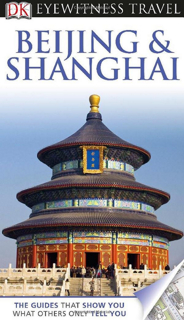
368. DK Eyewitness Travel Guide to Beijing and Shanghai – with photographs by Chen ChaoThe Amazon information on this book is slightly misleading. The 2011 edition is a paperback, the 2016 edition is flexibound. There are no 2016 paperbacks and no 2011 flexibound copies, and clicking on the button to change binding format takes you to the page for the other edition. Page counts differ by only four and the physical dimensions are identical. The unfortunate fact is that there are no highly-rated travel guides to Beijing – Shanghai, we’ll deal with separately. The ratings for this book – 4.4/5 from 62, with Amazon having conflated reviews for both editions – are about as good as it gets, the others are all in the threes. So this is as good as it gets. As usual, it’s the cutaway 3-D drawings and floor plans that elevate the DK guides. The print edition comes with a color pull-out map (may be missing in used copies). Beyond that, the DK guides tend to focus on brief narrative descriptions that do little more than tantalize – but which are an excellent starting point for further research into specific topics. The other great advantage that books like this offer is in the spacial relationships between locations – knowing how far X is from Y on foot can be extremely useful to the GM. Pricing & Links: 2011 edition (Paperback, pictured) 34 used from $0.01; 15 New from $3.00. http://amzn.to/2dLXiLT 2016 edition (Flexibound) 20 used from $7.47, 40 new from $7.49, Amazon price $15.33: http://amzn.to/2d7I2uW |
|||
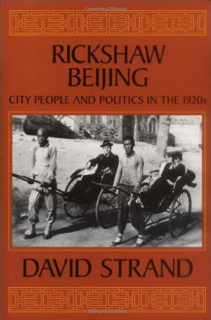
369. Rickshaw Beijing: City People and Politics in the 1920s – David StrandIn the 1920s, China was in turmoil, as revolution, war, and imperialism brought chaos, and China’s cities were at the center of the upheaval. This book examines how the residents of Beijing coped with the multitude of changes wrought by itinerant soldiers, politics, social change, poverty, capital, technology, and ideas, studying the experiences of ordinary citizens including rickshaw pullers, policemen, trade unionists, and Buddhist monks. 388 pages, published by University of California Press. One customer complained that the book was soporific with too much spent on the Rickshaw and not enough on the city, even while conceding that the author’s grasp on the subject matter is unmatched. Everyone else who reviewed the book gave it four stars or better, and several explicitly recommend ignoring the one-star review. We found the text quite readable, though it could have been edited a little more tightly. It’s an aphorism in Australia that if you want to know what’s happening, and what people really think, you talk to a Taxi Driver. I suspect that citizens of New York or London or Berlin would say the same thing. The Rickshaw men were the “Cabbies” of 1920s China, working poor who rubbed shoulders with everyone else in society. If anyone was in a position to give a ground-roots view of the anarchy, it is them. It’s the ‘ordinary people’ stories that make this a compelling choice for this list. There are a surprising number of photographs and the majority are quite large, a value-adding bonus. Amazon want $33.95 for new copies of the paperback, other vendors have 29 copies from only $11.94. There are 40 used copies from just $1.48. There are also hardcovers from just $2.75 and a Kindle edition for $18.47. |
|||
Books about ShanghaiThe one overwhelming impression that we have from the 12 books recommended below is that Blair and Mike seriously undervalued the adventure potential of the place when they took the Adventurer’s Club campaign there. A couple of confrontations with some officials, some hints as to the national political scene, and a little drama at the dockside courtesy of one of a PC’s Rival – they barely glanced at the surface, never mind scratching it. A return visit to China’s Gateway is clearly in order. |
|||
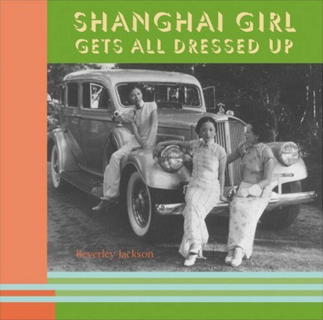
370. Shanghai Girl Gets All Dressed Up – Beverley JacksonIt was in 1930s Shanghai that the look which would become ubiquitously identified as “Chinese” in western cinema for decades – high-collars, body-clinging, slit-to-the-thigh silk gowns, often brightly colored and decorated – first emerged. Known now by various names – cheongsam, qi pao, and Suzy Wong dresses, they paint a strong contrast with the utilitarian drabness many associate with the period immediately after the Chinese Revolution. Art Historian Jackson explores the city that gave birth to this iconic style, and explores the cultural and artistic movements that coalesced to create it, in this photograph-heavy volume. The text is described by one customer as insipid, but it’s not for the text that we recommend it. 160 pages, each 10×10 inches in size; new copies are few and $40, but used copies start at an affordable $4.77. |
|||

371. The Opium War: Drugs, Dreams, and the Making of Modern China – Julia LovellTo understand Shanghai in particular, and Pulp-era China in general, you need to understand the Opium Wars. Arab traders had first brought Opium to China for medicinal purposes during the Middle Ages, but it took hold as a recreational drug; by the early 19th century, 90% of the Emperor’s Court and the majority of the army were addicted. Britain was also addicted, to Chinese-grown tea paid for with the profits from Opium sales; even today, there is an immediate association between Brits and a “Cuppa”. When China tried to ban the drug and bar those who continued to import it illegally, England went to war to keep open China’s ports, and emerged not only victorious but forcing concessions from the Chinese Throne; the resulting perception of the Imperial Government as vulnerable eventually brought about the end of Imperial Power in China, the first domino that ultimately produced modern China. This is the first of two books we are recommending on the Opium Wars; it is described as “exceptionally well-written” by reviewers; presented in a narrative style with extensive footnotes, Lovell’s account draws on both Chinese and British sources and provides “pithy descriptions and accounts of characters on both sides”, making this exceptionally readable. It includes a final chapter based on interviews with young Chinese today which engages the lasting impact of the Opium Wars on Chinese perceptions of the West. The author is a lecturer on modern Chinese History at the University of London, has written for the Guardian, The Times, the Economist, and the Times Literary Supplement, translated a number of Chinese books into English, and is considered an expert on the subject who spends a large part of each year in China with her family. This is as authoritative an account as you will find. At 512 pages (12 of them index), it is the lengthier of the two books, and is almost certainly the more readable of the two. There are limited new copies of the paperback and even fewer used copies, both well within our acceptable price range. There is a Kindle version of an edition by a different publisher to the one featured in Amazon’s preview. Hardcovers are also available, and used copies are currently even cheaper and more plentiful than the paperback. |
|||

372. The Opium Wars: The Addiction of One Empire and the Corruption of Another – W Travis Hanes, Frank SanelloDespite the 12-page index, we aren’t certain of how useful Lovell’s book will be as a reference, so we are also recommending a more traditional and concise (352 page) history. In the interests of adding value to readers of these lists, the history we have chosen represents the wars from China’s perspective and not from the British. It is often said that the winners write the history books; at least in this case, it is untrue. But bear this bias in mind when engaging with this book. Kindle and paperback editions, starting at $4.19 used and $11.48 new. |
|||
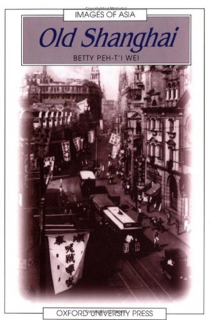
373. Old Shanghai – Betty Peh-T’i WeiThe title of the series of which this book is a member, “Images of Asia”, is misleading. While this book contains photographs, it is not a photographic collection; it is text with accompaniment. This is a popular history of Shanghai from its beginnings as a market town to the modern day, with emphasis on its “golden age” in the late 19th and early 20th centuries (the Opium Wars puts a new spin on the term “golden age” in our view). “Wei tells the story of gangsters, traders, and bankers, as well as the artists, political activists, missionaries, and armies of laborers who made Shanghai one of the world’s foremost business cities, and the flashpoint of political and social change in China”. Only 96 pages in length, but published by Oxford University Press, this is a very general history but must be considered authoritative. New copies are hard to justify given the length and price-tag of $15.93+, but used copies are not only more plentiful but start at just one cent. |
|||
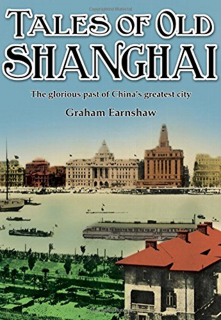
374. Tales of Old Shanghai: The Glorious Past of China’s Greatest City – Graham EarnshawWith copies of the preceding recommendation limited in number, we felt it prudent to include an alternative; in the interests of diversity and adding value to this list, we have chosen a book with a slightly different perspective. This book presents photographs, newspaper clippings, stamps, vintage advertisements, excerpts from travel guides, fliers, and first-hand anecdotes that collectively evoke a sense of the history and tone of the city in a scrapbook format. |
|||
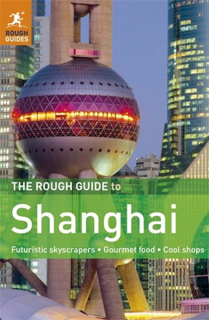
375. The Rough Guide to Shanghai – Simon LewisWe commented that good travel guides seemed to be hard to find for Beijing; that’s not the case for Shanghai, and it’s our sense that this book is a better choice than the Beijing-and-Shanghai guide that seemed the best for the capital. Promising “clear maps of every neighborhood and detailed coverage of city attractions, this fully updated guidebook will help you discover the best Shanghai has to offer. Detailed practical advice … All the major and offbeat sights are covered” and “includes all you need … for great day trips to tranquil canal towns such as Tongli and Suzhou.” There are two editions available through Amazon: a 2014 version and a 2011 version. Simply because they will be cheaper and will exclude some of the more recent changes, we recommend people buy the older edition until prices get to $12 or so; after that, you will need to compare prices for the two and decide for yourself. The current prices are shown below. 2011 Edition (pictured), 208 pages: 12 New from $12.46, 28 used from $0.01. http://amzn.to/2e5RiOt 2014 Edition 200 pages: Kindle $11.40; 40 New from $8.10, 21 used from $8.10. http://amzn.to/2euXgLC |
|||
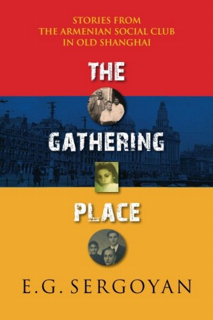
376. The Gathering Place: Stories from the Armenian Social Club in Old ShanghaiThere are always a few who will take a chance during times of trouble and relocate to another nation in hopes of a fresh start, leaving (if necessary) friends, family, and home. The immigrants whose stories appear in this collection of personal histories made their way to exotic Old Shanghai, where they joined the Armenian Social Club. “Their travels coincide with war, economic depression, revolution, banditry, and military occupation during the most turbulent period in modern history … the first half of the twentieth century.” While a number of those accounts will clearly relate to the two World Wars, a plentiful number do not. |
|||
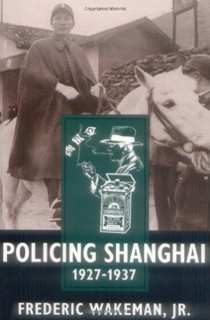
377. Policing Shanghai 1927-1937 – Frederic Wakeman“Pre-war Shanghai: casinos, brothels, Green Gang racketeers, narcotics syndicates, gun-runners, underground Communist assassins, Comitern secret agents. Frederic Wakeman’s masterful study of the most colorful and corrupt city in the world at the time provides a panoramic view of the confrontation and collaboration between the Nationalist secret police and the Shanghai underworld.” Could it sound more Pulp? But, on top of that, it is described as “a great reference book, although … filled with very detailed information, including statistics, that might not be of interest to the general reader” – but which would certainly be valuable to the Pulp GM. 478 pages and academically oriented with splashes of flavor, published by University Of California Press. Kindle ($33.56), Hardcover from $25.86 – but paperback copies start at just $14.99. |
|||
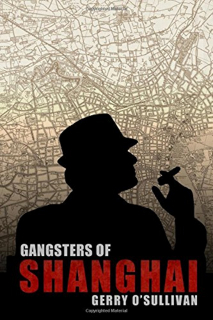
378. Gangsters of Shanghai – Gerry O’SullivanUnusually, we are recommending this piece of historical fiction, and that despite a great number of complaints about the quality of the plot and writing (many of which make it sound very “dime-store-thriller”), and for one very good reason that a great number of reviewers commented on: “This book is worth reading for its historical detail alone …. There’s an extremely well-drawn, accurate picture of just how surreal the International Settlement was. Wealthy Westerners line their balconies and watch vicious fighting just outside their borders as if it was sport” (City Weekend, Shanghai); “Superbly researched” (David Lowther, author and reviewer for Amazon UK); “…puts you there as if you actually lived through this part of history” (an amazon customer); “…impossible to determine the weave where historical reality ends and imagination takes over” (another amazon customer). |
|||
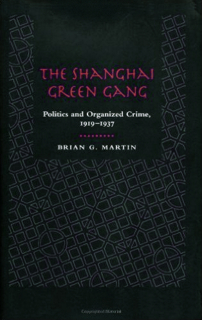
379. The Shanghai Green Gang: Politics and Organized Crime 1919-1937 – Brian G MartinFrom one book that – technically – doesn’t belong in this list to another. The Shanghai Green Gang were both the dominant figures in Shanghai Organized Crime in the 1920s and 30s and the most powerful secret society in China until the Japanese occupation. Like the Mafia and the Yakuza, there is a great deal more to the organization, and its leader, Du Yuesheng. than met the eye of the casual observer at the time. In this book, Martin “sifts through a variety of fragmentary and at times contradictory evidence – from diplomatic dispatches to memoirs to police reports – to produce the most comprehensive account of this chaotic period of Chinese history.” The author is or was a Senior Foreign Policy Analyst for the Australian Parliamentary Research Service and is a Research Associate at the Centre of Asian Studies, University of Hong Kong. 279 pages, published by the University Of California Press. And so to the bad news, and the reason this book shouldn’t be included, having demonstrated clearly why it has been, anyway: Amazon have one new copy for $63. Other vendors have another 25 new copies from $39.15, and 22 used copies for $38.27 or more. Those are almost double our normal limits – but there really is no comparable source. |
|||
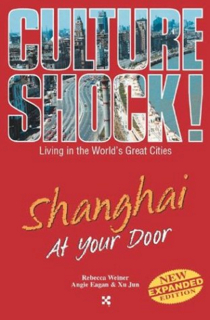
380. Shanghai at your door (Culture Shock Shanghai) – Rebecca WeinerThe product description is canned text about the Culture Shock series. According to the (only) customer review, “It … provides a great overview on Shanghai’s history, Shanghai’s people and doing business in Shanghai. While other books cover all of these subjects in much more detail, I find this book offers a great overview. The major reason why we are recommending this particular local culture guidebook is that it dates from 2003, when China was only beginning to open up, and so it will (we expect) be less tainted by commercialization and tourism. Paperback, 10 new copies from $18.76 and 20 used from one cent. |
|||

381. Cinema and Urban Culture in Shanghai, 1922-1943 – edited by Yingjin ZhangShanghai was also the center of the Chinese film industry until the Communist Revolution. “…Zhen Zhang discusses how the influence of teahouse culture gradually yielded to cinematic and narrative concerns in the early 1920’s. Kristine Harris’s analysis of a costume drama reveals the director’s cultural heritage and a rich psychological subtext created by new film techniques. Leo Ou-fan Lee examines the ways various urban institutions were utilized to promote a certain type of film culture in Shanghai.” – and that’s just in the first of three parts within this 392-page book, published by Stanford University Press in 1999. Hardcover copies are out of reach at $60-70, and new copies of the paperback start at $24.65. But there are 26 used copies starting at $10.14. |
|||
Central Asia |
|||
Books about The HimalayasThere are no shortage of books about hiking the Himalayas, and no shortage of climber’s/hiker’s memoirs and accounts. Books about the mountain range itself tend to be far more obscure and hard to find – and period ones even more so. We have selected one (non-period) Trekker’s Guide and one such climber’s account, and supplemented these with the closest thing we could find to period guides. You will find related works in separate sub-sections on Tibet, Nepal, and Mongolia. |
|||
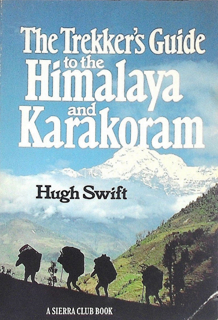
382. The Trekker’s Guide to the Himalaya and Karakorum – Hugh SwiftThousands of trails interconnect through the Himalayas, some thoroughly commercialized and well-traveled by hikers and climbers, others all but unknown. This claims (and we have no reason to doubt him) to be the only guidebook to cover the entire Himalayan system including the hill regions of Pakistan (Chitral, the Gilgit River Valleys, and Baltistan); India (Kashmir, Ladakh, Himachal Pradesh, Garhwal, and Sikkim); all of Nepal; and parts of Bhutan. 351 pages, published by Sierra Book Clubs of San Francisco in 1982. There are 6 new copies for $62.61 but used copies are affordable from 14 cents and reasonably available. |
|||
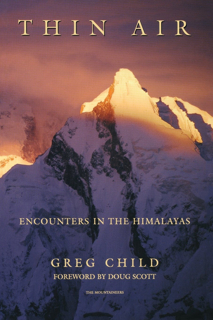
383. Thin Air (2nd edition) – Greg Child“In this spellbinding chronicle, Greg Child takes us step by nerve-shattering step through the world’s most remote regions – as he cracks the “death zone” above 26,000 feet, and attacks ‘by fair means’ the world’s most perilous pinnacles.” This appears to be a typical climber’s story, elevated above the rest by a more poetic turn of phrase. Library Journal state, “Although Thin Air would be improved by the addition of political maps, an index, and more rigorous copy editing, it is a worthwhile contribution to the literature of Himalayan climbs”. Kindle and Paperback. |
|||
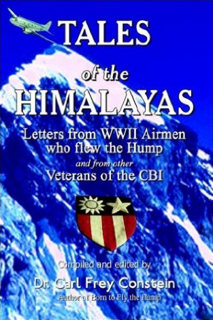
384. Tales of the Himalayas: Letters from WWII Airmen who flew the Hump and from other Veterans of the CBI (Revised edition) – compiled and edited by Dr Carl Frey Constein“This is a book of letters written to Carl Frey Constein, author of the WWII memoir Born to Fly the Hump. Most of the letters are from pilots and crew who also served in the China-Burma-India Theater of Operations. They tell of crashes and bailouts over the Himalayas and Burma, of mammoth thunderstorms and engine failures, of bombing runs out of China, of airdrops behind enemy lines.” With War coming to the China region in 1937, these stories are as close to pulp-contemporary as you can get. |
|||
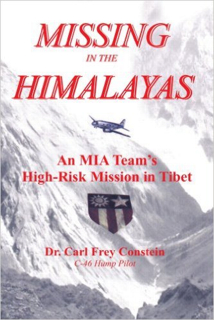
385. Missing In The Himalayas: An MIA Team’s High-Risk Mission in Tibet – Dr Carl Frey ConsteinAmazon uses a subtitle that doesn’t appear on the cover. On December 3, 1444, a C-46 returning after a mission broadcasts a mayday and vanishes. A Tibetan hunter stumbles across the site of the crashed aircraft at 14,000 feet some 60 years later, prompting a high-risk MIA mission to excavate the crash site. This book tells the story of that recovery mission. |
|||
Books about Nepal
|
|||
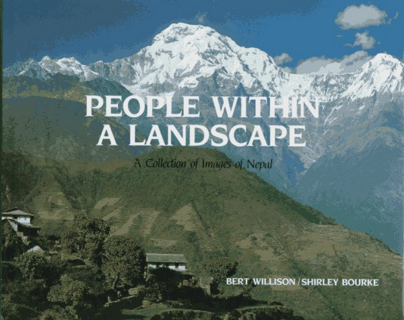
386. People Within A Landscape: A Collection of Images of Nepal – Bert Willison and Shirley BourkePresents 200 color images of Nepal, mostly of people or buildings with very big mountains n the background, on 128 pages. No index. Hardcover; new copies are $56+ but used copies start at one cent. Amazon credits Sir Edmund Hillary with the design, but his name doesn’t appear on the front cover. |
|||
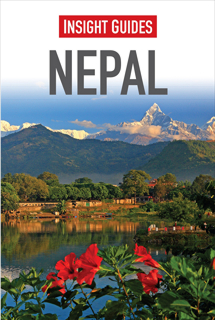
387. Insight Guide NepalEight of the world’s ten tallest mountains are in Nepal. This travel book covers the entire country region-by-region, with detailed maps and travel tips. 374 pages. Written and refers to the region before the devastating earthquakes of April-May 2015. Kindle and Paperback, both new and used are affordable and similar in price. |
|||
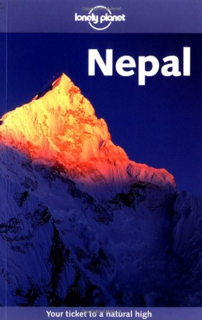
388. Lonely Planet Nepal – Bradley Mayhew, Lindsay Brown, and Wanda Vivequin“Practical, reliable information to get the traveler from peak to valley – comprehensive section on festival dates & highlights to help travel planning – 55 detailed maps”. Contains “extensive background on people and cultures, and essential pre-trip guidance”. Covers only the southern part of Nepal (no information on the Himalayan region, for example). Potentially better than the Insight Guide within its’ areas, but incomplete. Note that there is a more recent edition which post-dates the earthquakes referred to above; for that reason, we are not providing a link to it. 384 pages, 10 new copies from $14.49 (2 collectible from $6.63 – how does that work?) and 38 used copies from one cent. |
|||
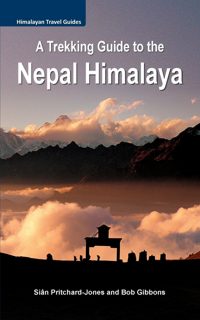
389. A Trekking Guide to the Nepal Himalaya: Everest, Annapurna, Langtang, Ganesh, Manaslu & Tsum, Rolwaling, Dolpo, Kangchenjunga, Makalu, West Nepal – Sian Pritchard-Jones and Bob Gibbons“…the Nepal Himalaya are a fairytale wonderland of picturesque villages, tremendous terraced hillsides, precipitous canyons, forest-filled valleys, pristine nature, quaint Buddhist monasteries and colorful Hindu temples. The hardy, vibrant people could not be more charming as hosts, guides, porters, yak herders and fellow travelers on the myriad of trails. “This comprehensive, indispensable guide to the Nepal Himalaya covers the popular as well as the less well-known trekking trails of Nepal. Including: a) introductory section: country background, religion and festivals, practicalities, trek planning, staying healthy, altitude sickness, mountain safety, and the highlights of Kathmandu b) detailed descriptions of the more popular trekking routes: Everest, Annapurna, Langtang, Ganesh, Manaslu & Tsum, Rolwaling and Dolpo c) outline suggestions for routes where camping is still the only option: Kanchenjunga, Makalu and West Nepal (Simikot, Saipal and Limi Valley).” More than the trekking guide the title suggests, this is a book about the inhabitants of the region and their culture. |
|||
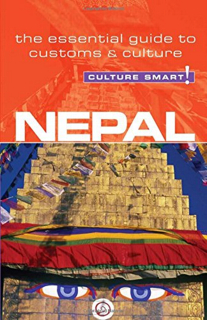
390. Nepal Culture Smart – Tessa Feller“If you only have time to read one book about Nepal-this should be the one! Written by a woman who lived in Nepal for two years … captures everything you need to know.” Another purchaser suggested in 2011 (3 years after publication) that while it is an adequate overview, it’s insufficiently in-depth for someone who wanted to reside in the country, with two specific problems identified: some generalizations applied globally to the country are regional or sub-culture specific, and many are more true of country residents than urban dwellers; and there are suggestions that this is not a completely accurate “warts and all” depiction, for example drug use within the city and larger towns is over-downplayed. At the same time, however, the same reviewer making this complaint added, “there were a lot of little helpful facts in this book, it’s extremely well organized, and is very easy to read.” 168 pages, Kindle and Paperback. |
|||
Books about MongoliaFor most of the 20th century, most of Mongolia was under Soviet domination, and the rest was under at least titular control, though there are some Mongolians living in China. Gorbachev began the withdrawing of Soviet troops from Mongolia, a process that took three years, and they were left to fend for themselves and shape their own destinies as best they could. All of which makes pulp-contemporary information hard to find. The following recommendations are all compromised, then – too old, or too modern. But all contain elements of the people and culture as they were, then; so use them as a starting point and get creative. |
|||
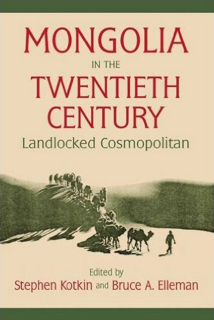
391. Mongolia in the Twentieth Century – edited by Stephen Kotkin and Bruce Allen EllemanYou might hope that 20% of this book would be devoted to the two decades that are spanned by the Pulp Era; but you might be disappointed. The first 79 pages deal with pre-pulp, and that’s fine, because a lot of that material will remain valid. Pages 99-107 concern international diplomacy regarding Outer Mongolia. Pages 107-136 are Pulp-era specific. From page 137 to page 182, the post-war period under the Soviet Union is the focus; and from page 183 onward, the post-soviet (modern) era is the subject. At best, that’s about 10% of the book length; though this total improves if we give the book a half-score for the pre-pulp content, close to that 20% mark in fact. That said, this is the only substantial history book of Mongolia that doesn’t spend most or all of the pages talking about Genghis Khan or dealing exclusively with the modern era. Both of these factors need to be taken into account when you evaluate the value-for-money performance of the book. New copies of the paperback from Amazon will cost you almost $53; they are slightly cheaper from third parties, starting at $38.22. Don’t even think about the still-more-expensive hardcover! There is a Kindle – for almost $47. But 15 used copies of the paperback start at just $11.99. There probably aren’t very many copies at that price, though. |
|||
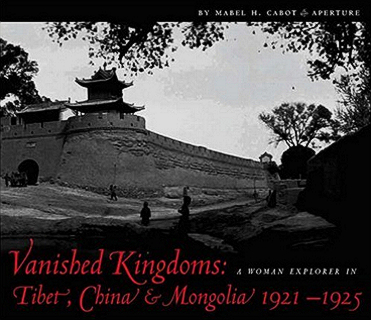
392. Vanished Kingdoms: A woman explorer in Tibet, China and Mongolia 1921-1925 – Mabel H Cabot“Vanished Kingdoms is the story of Frederick and Janet Wulsin’s exploration of central China during the 1920s. This is a fascinating book that is gorgeously illustrated with photographs captured by the Wulsins and is written by Janet Wulsin’s daughter.” – from a review by A Silverstone of Vine Voice. For a change, it’s the paperback that is completely unreasonable in price, and the hardcover that is affordable. |
|||
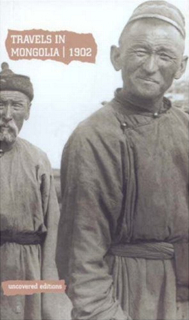
393. Travels in Mongolia 1902: A journey by C.W. Campbell, the British Consul in China – edited by Tim CoatesWe know little about this book beyond the title and a single review which tells us that this describes the first encounter between a Mongolian and a Westerner. But the title is really all we need; while the Soviets had taken over in the years between the journey described and the Pulp period, and ruled for 15 years, much would have remained unchanged. |
|||

394. Lonely Planet Mongolia – Michael KohnThis travel book has two things to recommend it: first, it is the most highly rated with a significant number of reviews; and second, it is the cheapest, mostly because there is a newer (more expensive) edition. Since we are uncertain how much of the content will translate back to the pulp era, and there are plenty of copies, we recommend that you stick with this edition. New copies are not affordable, but used copies are cheap. |
|||
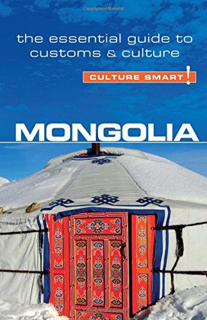
395. Mongolia Culture Smart – Alan Sanders“Mongolia is landlocked between its neighbors China and Russia in the heart of Asia. For centuries after the disintegration of Genghis Khan’s empire it was ruled by one or the other, but in 1990 the Mongols embraced democracy. Now, after two centuries of Manchu stagnation and seventy years of Soviet communism, they are rebuilding their national heritage. Rarely in the news but making progress toward a market economy, this resource-rich but infrastructure-poor country is a land of pioneers, and its greatest asset is the Mongol people, who are friendly, cooperative, ambitious, and well educated.” From which description, we would guess that perhaps a third of this book is certain to apply in the pulp era, and more is quite likely. “Friendly”, and “cooperative”, we can readily believe. “Ambitious”, is a bit more of a stretch, but perhaps it is so; their most famous son was certainly so. “Well-educated” seems improbably back then. The author is considered the leading British authority on Mongolia, and is a former lecturer in the subject at London’s School of Oriental and African Studies. The book is 168 pages in length. It is not a travel guide, it is a guide to the people and culture of the nation, something that some purchasers seem to overlook somehow. |
|||
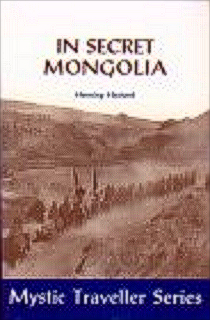
396. In Secret Mongolia – Henning HaslundTrue stories of the exploration of a remote and exotic region of the world in the 1920s and 30s – also available in a bright red cover, but it’s the same book. It was out of print for fifty years. “Haslund’s camel caravan takes him across the Gobi Desert where he meets with renegade generals and warlords, god-kings and shamans. Haslund is captured, held for ransom, thrown into prison, battles black magic and portrays in vivid detail the birth of a new nation. Meet the reincarnated gods: the ‘Mad Baron’ Ungern-Sternberg and Dambin Jansang, the dreaded Tushi Gun Lama of the Black Gobi, trek across the Gobi Desert, and go back in time to Shamanic Mongolia.” |
|||
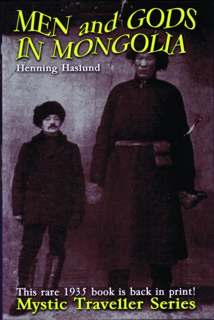
397. Men and Gods in Mongolia – Henning HasslundFirst published in 1935, this book covers similar territory to the previous one, and is by the same author. In this book, Haslund “takes us to the lost city of Karakota in the Gobi desert and meets the Bodgo Gegen, a god-king Mongolia similar to the Dalai Lama of Tibet; Dambin Jansang, the dreaded warlord of the Black Gobi. Most incredibly, he writes about the Hi-mori, an “airhorse” that flies through the sky and carries with it the sacred stone of Chintamani. And there is plenty of just plain adventure: camel caravans; initiation into Shamanic societies; reincarnated warlords; and the violent birth of modern Mongolia.” New copies of the hardcover are out of the question at $85+, but used copies are the most affordable format at the moment at $9.88. In between are the paperbacks, costing about $17.70. |
|||
Books about Tibet
|
|||
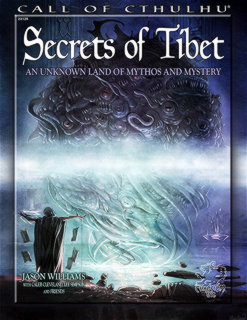
398. Secrets of Tibet: An Unknown Land of Mythos and Mystery – Jason WilliamsThis is a Call Of Cthulhu sourcebook for the 1920s. “The land is populated with malevolent gods and monsters, and deep secrets lie sleeping in ancient tombs and vaults among Tibet s soaring mountains and deep valleys.” Copies are getting extremely scarce and since originally compiling this list, have shrunk noticeably; the 15 remaining copies – about half new and half used – are around the $23-$24 mark. |
|||
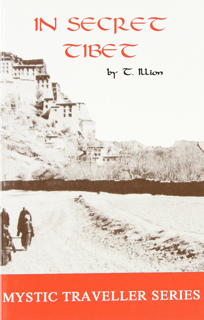
399. In Secret Tibet – Theodore IllionA reprinting of a 1930s travel book. The Author was a German who traveled in disguise through Tibet when it was off-limits to outsiders – fortunately he spoke fluent Tibetan. Includes illustrations of Tibetan monks levitating stones by acoustics. There are some very vicious negative reviews, but for us, that last sentence tells you exactly what to expect. 100 pages, Kindle and Paperback. The Kindle is the most expensive version. |
|||
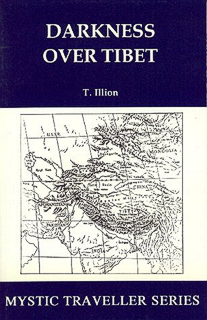
400. Darkness Over Tibet – Theodore IllionA sequel to the previous book, republished as part of the same series. Illion continues through Tibet and is given directions to an underground city. He is, if Illion’s original publisher is to be believed, the only Westerner to ever enter it and escape alive. This just reeks of being pulp-ready. Kindle and Paperback. |
|||

401. Himmler’s Crusade – Christopher HaleAn account of an SS expedition into Tibet in 1938, led by two people – one so rabidly committed to the Nazi cause that he later conducted racial experiments using the skulls of prisoners at Auschwitz, and the other using the Nazis for his own ends. The goal of the mission was to locate the remnants of the Aryan people, the lost Master Race. |
|||
Books about JapanJapan has changed so much since the Second World War that it is very hard to find relevant reference materials. The war itself wrought vast changes, the industrial retooling that followed changed it still further, the global economic success and dominance in electronics and miniaturization that resulted changed it again, the Japanese Management Techniques that swept the world through the late 70s, 80s, and 90s transformed it once more. For all that segments of the West have become fascinated by elements of Japanese culture that didn’t even exist in the Pulp Era, it remains difficult to pin the place down in simple terms. That makes things difficult for the Pulp GM. These references should help. |
|||
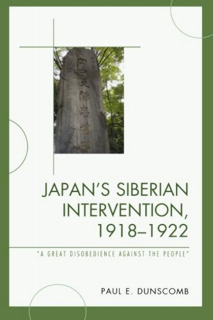
402. Japan’s Siberian Intervention, 1918-1922: ‘A great Disobedience Against The People’ – Paul E DusncombJapan’s role in World War II was all about grabbing resources, just as their success in miniaturization had its roots in achieving the maximum while consuming minimal resources. Their first attempt at acquiring the resources they desired, even as World War I was ending, should have warned the world of what was to come, but it didn’t. The history of this conflict is central to understanding Japan over the subsequent 23 years and beyond. Not to mention that the pulp era fully encompasses this time frame. |
|||

403. Constructing East Asia: Technology, Ideology, and Empire in Japan’s Wartime Era, 1931-1945 – Aaron MooreThis book challenges accepted interpretations of Japanese wartime and pre-war ideology towards technology, which may well have been the most lasting victim of Western wartime propaganda. This is quite academic to judge from the dense language employed in the product description. If your pulp Japan is to be making strides toward giant fighting robots and Godzilla-repelling technologies, you may want to pay close attention to the content. If not, it will still force you to confront the preconceptions that the history we were all taught has fostered. 328 pages, and doesn’t quite sneak completely under our price cap. |
|||

404. Japan 1868-1945: From Isolation to Occupation – Takao Matsumura and John BensonThere’s obviously a gap on the detailed histories selected above. This 292-page book will fill that gap, and supplement the preceding book which is about the interpretation of events during the 1930s and early 40s than about events. |
|||

405. A Concise History Of Japan – Brett L WalkerAnother direction that the Pulp GM may wish to take involves preserving a more feudal approach to parts of the country despite the modernity of the era. That is the approach that Blair and Mike chose in the Adventurer’s Club campaign, in which Japan was a pulp-modern culture with small pockets of feudal and pseudo-feudal power structures, an odd blending of ancient and new that nevertheless resonated quite strongly with the known society, sociology, and wartime behavior of Japan. Fully implementing this approach requires a still broader understanding of the history of the nation, and that is where this history comes into the picture. 359 pages, but with much more history to cover, many events will be discussed in less detail than the histories of narrower scope previously listed. |
|||
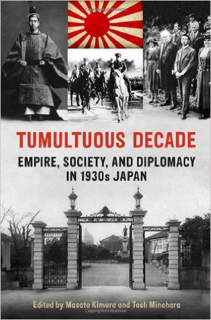
406. Tumultuous Decade: Empire, Society, and Diplomacy in 1930s Japan – Masato Kimura and Tosh Minohara“Featuring an interdisciplinary and international group of scholars, Tumultuous Decade examines Japanese domestic and foreign affairs between 1931 and 1941. It looks at Japan in the context of changing approaches to global governance, the rise of the League of Nations, and attempts to understand the Japanese worldview as it stood in the 1930s, a crucial period for Japan and the wider world. The editors argue that, like many other emerging powers at the time, Japan experienced a national identity crisis during this period and that this crisis is what ultimately precipitated Japan’s role in the Second World War as well as the global order that took shape in its aftermath”. We don’t fully agree with their thesis, feeling that the identity crisis followed the war and the unconditional surrender that was forced on the nation, but that doesn’t mean that this book is bereft of value. Anything that describes the culture of the period is a useful reference to have. 328 pages. Kindle, Hardcover, and Paperback, but most copies and formats are too expensive to consider. |
|||
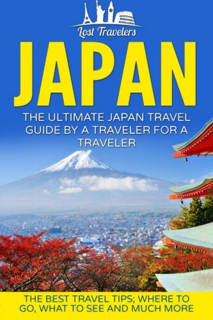
407. The Ultimate Japan Travel Guide By A Traveler For A TravelerWe have eschewed most of the travel guides as dealing with a Japan that is too far removed from the one of the Pulp Era to be relevant. This is one that snuck past that restriction by providing chapters on several of the major cities. 80 pages, which is very short for a travel guide. Kindle and Paperback. |
|||

408. Japan’s World Heritage Sites: Unique Culture, Unique Nature – John DougillThis photographic collection was discovered at the last minute. If it dealt with the urban landscape in the pulp era in addition to the material it does contain, we would have elevated it in the list, as we like to be consistent in format; but it doesn’t, so it is in the specialty travel subsection for Japan. What it does contain are photographs of the temples, gardens, castles, and natural wonders that are now designated UNESCO World Heritage Sites. Each site is described in detail and in photograph. 192 pages, each 9 by 12 inches. At almost an inch thick expect higher P&H than normal. Kindle $16, new hardcover copies from $19.40, used from $10.40, and there is one out-of-reach collectible copy |
|||

409. Gurps Japan (3rd edition) – Lee GoldGame supplement focusing on Feudal Japan. Useful for Samurai, Ninja, Japanese Castles, etc. |
|||
Books about Tokyo
|
|||

410. The World’s Greatest Cities: The History of Tokyo“Chronicles the history of Tokyo over the last several centuries, including accounts of what the city was like across the years, with a bibliography for further reading. At 44 pages, this is a slim volume, but the prices reflect that. Kindle and paperback, limited copies. |
|||

411. Tales Of Old Tokyo: The Remarkable Story of one of the world’s most fascinating cities – John Darwin van Fleet“A breathtaking romp through … Tokyo’s history from the mid 19th to the mid-20th century, using lots of images, writings and clippings to bring back to life those far-off days.” 232 pages, Kindle and Paperback. |
|||
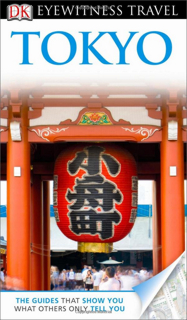
412. DK Eyewitness Travel Guide: TokyoThis 2013 book is the only Tokyo travel guide with more than 3 1/2 stars from a significant number of reviews at Amazon. Not even the newer edition escapes this malaise (so we aren’t linking to it). The usual (for a DK travel guide) cutaways and floor-plans. Criticized by some for not including enough tourist activities, just places to go and things to see – which is a plus for our purposes. Because this is officially an out-of-date edition, used copies are at rock-bottom prices, and if they run out, there are reasonably-priced new copies. |
|||
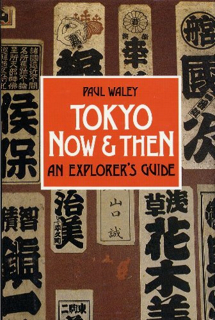
413. Tokyo Now and Then: An Explorer’s Guide – edited by Paul WaleyWhen a 15-year resident of Tokyo describes this as his favorite historical guide to the city, you listen. 502 pages, and even though some of it will be out-of-date, the descriptive passages would remain current; more importantly, many of them would also be applicable in the Pulp era. Hardcover only, and new copies are prohibitively expensive; but there are 25 used copies from $2.49. |
|||

414. Tokyo: City Of Stories – Paul WaleyThese are the stories behind the buildings, as recounted by the same author as the previous volume. Paperback only, both new and used are reasonably priced. 288 pages. |
|||
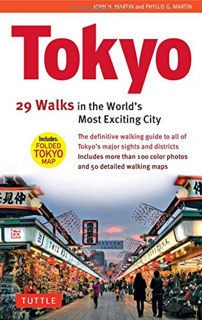
415. Tokyo: 29 Walks in The World’s Most Exciting City – John H Martin and Phylis G Martin“On foot and by train or subway, it takes you through the most fascinating parts of the modern megalopolis, while making the shogun’s city – the Edo of samurai and geishas, merchants and artisans – and the outlines of old Tokyo come alive.” 19 walking tours in Tokyo; 10 day trips including Yokohama, Kamakura, and Mt Fuji; over 100 photos; 50 full-color maps, plus a “large pull-out map” (probably missing from used copies). 288 pages, paperback and Kindle, affordable in both new and used conditions, plentiful copies. |
|||
Other Significant Places in Asia |
|||
Books About SingaporeSingapore is one of the success stories of Asia. Founded in 1819 as a trading post for the East India Company, it was ceded to Britain in 1826. Captured and occupied by Japan in 1942, it was repossessed after the Japanese surrender. It gained independence by Federating with other former British territories to form Malaysia, but was expelled two years later because of ideological differences. A period of instability followed, eventually giving way to prosperity and stability. |
|||
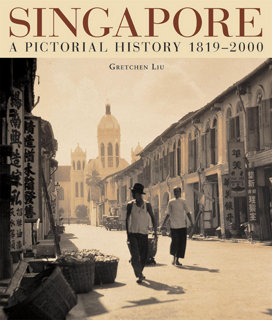
416. Singapore: A Pictorial History – Gretchen LiuOne of the heftiest photographic collections we’ve ever seen, this 400-page volume contains more than 1200 images. The page size of 10.3 x 12 inches is enough that these are of a reasonable size – an average of three a page and the equivalent of a fourth for text would still make the average size larger than 5×6 inches each at a minimum, and potentially much larger. Nearly an inch-and-a-half thick, and weighing in at more than 5 pounds, additional P&H would seem a foregone conclusion. The collection includes the earliest known sketch (1823) and photograph (1843) of Singapore, topographic studies, formal portraits, and street scenes, some sourced from private family albums. The images are in four sections arranged chronologically. No matter how much you would expect to pay for such a collection, you are almost certainly overestimating; prices for new copies are only $25.57 and used copies start at a mere $2.90 – and are in good supply. |
|||
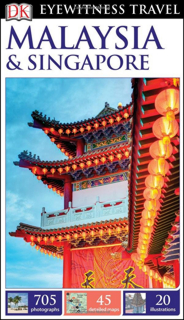
417. DK Eyewitness Guide to Malaysia and SingaporeTravel guides to Singapore all have roughly the same rating, and insufficient populations for those ratings to be deemed significant recommendations. With that in mind, we have opted for one that is usually heavy with additional content of use to the pulp GM. Paperback only, and both used and new are roughly the same price. 356 pages. |
|||

418. The Fatal Fortress: The Guns and Fortifications of Singapore 1819-1953 – Bill ClementsBetween 1923 and 1938, the Singapore naval base had been upgraded with some of the largest coastal guns ever installed. The siting and design of these has since been blamed for the humiliating defeat of the British forces, but flaws in the island’s defenses were inherent in the city’s founding. This book instead argues that it was a failure of Command that ultimately caused the fall of Singapore. The text is accompanied by a number of photographs, drawings, and plans. 232 pages. The price is a little high by the lists’ standards at $23.37, but that’s not surprising – this book won’t actually be released until November 1st. Note that the price will almost certainly go up from that date; Amazon usually include a pre-order discount. |
|||
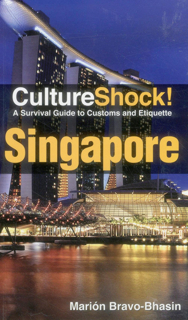
419. Culture Shock Singapore – Marion Bravo-BhasinThis is the first of two cultural reference books to Singapore that we are listing, and it is the one that looks like being the most useful – given how much Singapore is likely to have changed in the intervening years. But it’s the more expensive of the two. 400 pages in length, however, while the alternative is a much briefer 168 pages. Kindle and Paperback.. |
|||
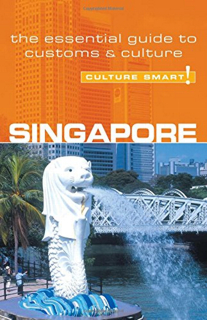
420. Singapore Culture Smart – Angela MilliganThe Culture Smart series has been vying with Culture Shock for most useful cultural guide throughout these lists, and in this case, the latter won out. We are including this book because it’s a lot cheaper (just one, cent used), for the budget conscious. |
|||
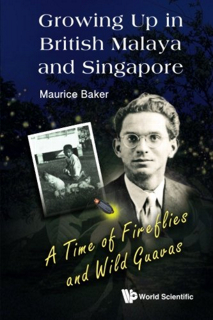
421. Growing up in British Malaya and Singapore: A Time Of Fireflies and Wild Guavas – Maurice BakerThe final book in the Singapore section is the autobiography of Baker’s life in Singapore from the 1920s until the 1940s. This covers most of the Pulp Era like a blanket. |
|||
Books About Hong Kong
|
|||
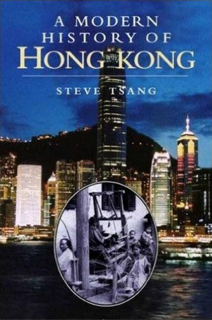
422. A Modern History Of Hong Kong – Steve TsangIn 1841, Hong Kong was a little-known fishing community on the outer periphery of China. Then the British occupied it, and over the next 156 years transformed it into one of the world’s trading powerhouses. And then, as required under the terms of the treaty under which the Chinese ceded control, the British gave it back to China. At the time, there was endless speculation on how the culture shock of a progressive western society encountering the Communist regime of the People’s Republic from a position of subordination would affect the city. Some felt that the Chinese would clamp down, hard, and that it would be an object lesson in repression; others (including Mike) thought that they would leave the city largely alone and milk the cash-cow for as long as the ride lasted. While that forecast was closer to the mark, no-one expected Hong Kong to swallow the Dragon; but whether it was the spur of competition, the enlightenment as to what China could be, or simply taking the success of Hong Kong as a template for the 21st Century, it was the handover in 1997 that seemed to trigger the beginning of the wave of transformation within China. This is the story of Hong Kong from 1841 to the 21st century, as Hong Kong experienced a tumultuous transfigurative experience to rival that of anywhere else in Asia. It draws on documents and memories from both British and Chinese sources in addition to the obvious local knowledge, and is considered by many to be the definitive history – until the next great wave of change. 352 pages, Hardcover $70 near enough, Kindle $7.68, Paperback $34 new from Amazon or $14.24+ from third party vendors, $9.48 used. |
|||

423. An Extraordinary Youth: Growing up in British Hong Kong – Yvonne Blackmore de JongMost modern culture guides would be useless to at least some degree, but Hong Kong is better-served in that respect, in terms of the Pulp Era specifically, than many other places within Asia. These are the memoirs of a woman who was a young girl living in Hong Kong in the 1930s, interned by the Japanese when the “Pearl of the Orient” was occupied in the early 1940s, of her post-war return, and of her travels to Australia and Britain. Invaluable for capturing a glimpse of Hong Kong in that brief period we are calling the Pulp Era. Technically, with only 11 copies – 5 used and 6 new – and the used copies priced at $59 (the new are only $6), this should have been relegated, but it is too on-point to leave out – while the affordable copies last. |
|||
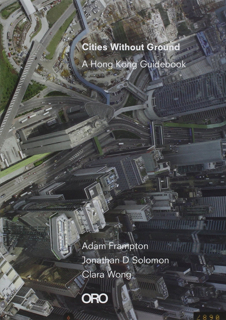
424. Cities Without Ground: A Hong Kong Guidebook – Adam Frampton, Jonathon D. Solomon, and Clara WongHong Kong is essentially built in three concentric semicircular rings, each smaller and higher up the mountain than the last. As you ascend, you are rising in social class and economic status. It can be said, as Frampton does, that this is a city without a ‘ground level’. The unique physical geography on which Hong Kong is built has profound effects on the culture and perceptions of the city; “Density obliterates figure-ground in the city, and in turn re-defines public-private spatial relationships. Perception of distance and time is distorted through compact networks of pedestrian infrastructure, public transport and natural topography in the urban landscape.” This book explores this unique physical and social topography by “mapping three-dimensional circulation networks that join shopping malls, train stations and public transport interchanges, public parks and private lobbies as a series of spatial models and drawings. These networks, though built piecemeal, owned by different public and private stakeholders, and adjacent to different programs and uses, form a continuous space of variegated environments that serves as a fundamental public resource for the city.” While fascinating in its own right, none of this justifies the inclusion of this book in this list; it is far too modern in topic. To do so, it is necessary to point out that none of this was deliberately designed and engineered to function in this way; it was assembled piecemeal, and its earliest roots lie in the fundamental structure of the city itself as it was even in the Pulp Era. As such, this book offers a unique perspective and insight even on that time period. 128 pages, paperback, new and used available for $8.50+ or $17.70 from Amazon direct. |
|||
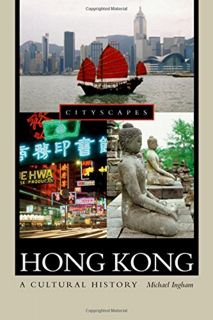
425. Hong Kong: A Cultural History – Michael InghamAlthough a first-glance perception of Hong Kong might be one of gleaming modernity, it has retained deep cultural roots throughout its history. This book strips back that surface (metaphorically speaking) to reveal the hidden culture, history, and myth that underly the modern community. Each region of Hong Kong is examined separately, examining its lifestyle, history, and notable tourist attractions. At its best with a separate map of the city, or you will find yourself perpetually turning back to the one at the front of the book. There are few photographs provided. 256 pages, hardcover (expensive except for a few used copies) and paperback (affordable, even cheap for a used copy). |
|||
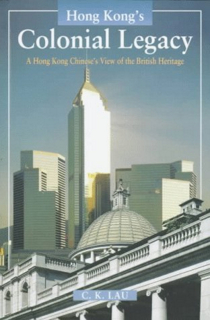
426. Hong Kong’s Colonial Legacy: A Hong Kong Chinese’s View of the British HeritageWhat did the British leave behind as their legacy when Hong Kong was returned to the Chinese at midnight on 30 June 1997? This book offers a Chinese resident’s answer to the question, aimed at the lay person – and, in the process, provides an insight into life during the period of British administration, which encompasses the Pulp Era. 218 pages, paperback. |
|||
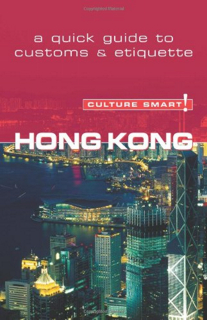
427. Hong Kong Culture Smart: The Essential Guide to Customs and Culture – Clare VickersThere are not many reviews of this book, and one is scathing: “provides the basics but if you really follow it you will be ridiculed by both cultures. The writing lends itself to easy skimming because it is not great. Picked up 1-2 tips but laughed at many of the rest.” The problem with this comment is that the author fails to establish his qualifications for making such a statement; his review title suggests looking elsewhere “like others have said” – except that there are no such suggestions, and Google lists no equivalent book. We are forced to conclude that one of two conditions exists: either the review has to be dismissed from all consideration as malicious, or the GM has to compromise and build his representation of Hong Kong culture and etiquette on a model that is not an accurate representation of the reality. Since this is a guide to modern-day Hong Kong, there would need to be generous liberties taken with the content anyway, so either way, we end with the proposition of ignoring the complaint. Further fueling that perspective are the qualifications of the author – “Clare Vickers is an English writer who lived in Hong Kong for eighteen years, from 1979 to 1997. Her husband was a member of the Hong Kong Government, and collaborated with her on the history and government chapters of this book as well as other historical books and articles on Hong Kong. She has a degree in modern languages, and has written several dictionaries and textbooks for Hong Kong schools, had a column in the educational section of the South China Morning Post, and is the author of Escape, a Story of Wartime Hong Kong, written for Hong Kong teenagers. She last worked in the territory in 2004.” Those qualifications make the complaint sound very hollow and foundation-less. We originally weren’t going to include any modern culture guide, even if we found one, but checked this one because the low rating seemed unusual for this series, which has earned a number of other recommendations on our list. Upon noting the publication date, and the dates of residence – 1997 was, of course, the year of the handover back to China – we felt that this might just hold insights to the colonial period culture, and worth listing. 168 pages, reprinted in 2006, pocket sized. Kindle for $7 but new copies from just 49 cents and used for one, so the convenience definitely comes with a premium. |
|||
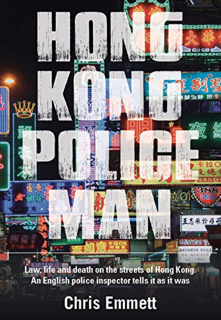
428. Hong Kong Policeman: Law, Life and Death on the streets of Hong Kong: An English Police Inspector tells it as it Was – Chris Emmett“In 1970 Hong Kong was the fastest expanding city in the world, a city that lived on three levels: the expatriates, nearly always British who lived in almost complete isolation; the vast mass of Chinese residents struggling to get by and improve their lot; and, finally, the criminal and corrupt underside which not only fought among itself, but also affected the lives of everyone else in the Crown Colony through fear and corruption.” Opposing the underworld was the Hong Kong police force, and this is a report of the experiences of a young Mersey-side policeman, Chris Emmett. Although set in the 1970s, the city’s nature – as described in that introductory paragraph – hasn’t fundamentally changed since the Pulp Era, making this as valid then as it was at the time it was written. 262 pages, Kindle and Paperback. New copies are currently cheaper than used. |
|||
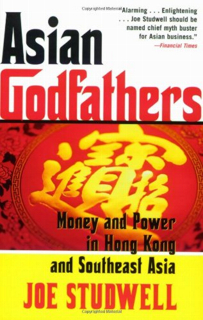
429. Asian Godfathers: Money and Power in Hong Kong and Southeast Asia – Joe StudwellStudwell is also the author of recommendation #351 on our list, “How Asia Works”. In this book, he recounts the personal histories of the fifty families in Southeast Asia and Hong Kong who dominate the lives of five hundred million people. Along the way, he reveals the broader historic, economic, and political influences that have shaped the region over the last 150 years. 368 pages, Kindle and Paperback. |
|||
Books About Taiwan
|
|||
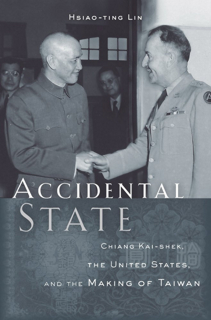
430. Accidental State: Chiange Kai-shek, the United States, and the Making of Taiwan – Hsiao-ting LinSome view the creation of “Two Chinas” as the inevitable outcome of the Chinese Civil War (it is not a position that China has ever accepted). Although the state itself did not exist until the Revolution – refer to our China section – the fact that General Kai-shek would choose this as the place to flee to marks it out as having been somewhat different to mainland China even before that seminal event. Understanding Taiwan in the Pulp Era is therefore an attempt to identify and characterize the points of distinction, and the origins of the Nation are the key. (It’s ironic that the “Two Chinas” are probably more alike now than at any point since then – Mike). Those origins are the subject of this book, which we shouldn’t recommend for price reasons but can’t resist for relevance. 352 pages, published by Harvard University Press. Kindle: $31.84 Hardcover: $39.95 from Amazon, $28.15 new, $26.94 used. First published in March this year and copies are starting to run out, so we would not be surprised to see a paperback edition sometime soon. |
|||
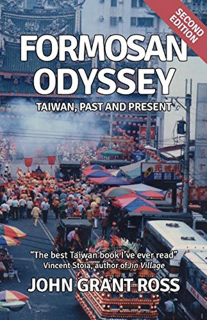
431. Formosan Odyssey: Taiwan, Past and Present – John Grant Ross“Until the early twentieth century, Taiwan was one of the wildest places in Asia. Its coastline was known as a mariners’ graveyard, the mountainous interior was the domain of headhunting tribes, while the lowlands were a frontier area where banditry, feuding, and revolts were a way of life. Formosan Odyssey captures the rich sweep of history through the eyes of Westerners who visited and lived on the island”. These stories appear to cover the Pulp Era, and the years both before and after. Kindle and Paperback, and technically there aren’t quite enough copies available – but once again we will make an exception on the grounds of obvious relevance. |
|||
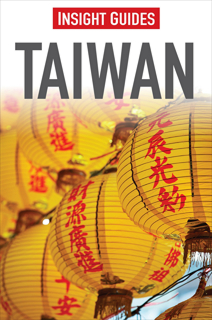
432. Insight Guide to TaiwanThere are a lot of travel guides to Taiwan, and they all seem to have similar ratings – without a great enough review population for an informed perception of those ratings. The few who have significant review counts also seem to decline markedly in rating. The Insight guides, aside from being one of those that we always keep an eye on, are exceptions to those statements. Furthermore, there are more copies available at cheaper prices than most of the other travel guides we saw listed by Amazon. The defining trait of the Insight Guides series – and each series definitely tries to establish its own ‘niche’ within the travel-guide publishing space – is that they tend to contain more cultural and regional information than the others, which may be more detailed in key tourism locations (Lonely Planet) or have a greater emphasis on photographs (national geographic) or maps (DK) or factual details that others lack (Rough Guides). 260 pages, Kindle and Paperback, new from $12.22, used from $2.30. |
|||
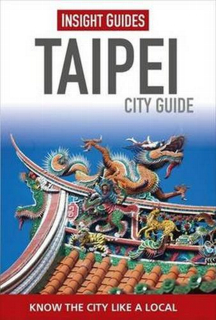
433. Insight Guide to Taipei CityThe previous listing deals with the country as a whole, this recommendation (from the same line) focuses on the capital, Taipei. Kindle and Paperback, new from $8.92, used from $10.01. |
|||

434. Taiwan A to Z: The essential Cultural Guide – Amy C LiuTaiwan preserves traditional cultural elements while accommodating the modern. Many of its practices and traditions will be strange to outsiders. In terms of rating by customers, this book is head-and-shoulders above the other offerings. Written by a Taiwanese local who understands both Western and Traditional cultures, enabling a prioritization of the things that people need to know and that are likely to intrigue and interest readers. The produce description lists four examples: Why it’s a bad idea to give a clock as a gift; why so many (modern) Taiwanese have PhDs; how Taiwanese parents choose children’s names; and why a new mother shouldn’t take a bath for a month after giving birth. Of those, two out of the four would probably translate directly to the pulp era, and one could translate indirectly. That’s a pretty healthy strike rate given that this is a content-relevance test that the description wasn’t designed to satisfy! |
|||
 |
|||
Books about India
|
|||
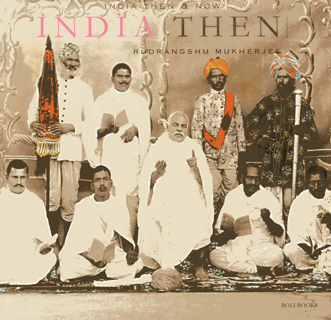
435. India Then and Now – Rudrangshu MukherjeeIndia’s past juxtaposed with India now, as with all of the “Then and Now” series. The “about the author” appears to describe a completely different person. It’s possible that the name on the cover is a pen-name. This is the “third impression edition”, i.e. the third printing of this particular book. 274 pages, and each larger than one foot by one foot make this a very hefty book – expect additional P&H (it weighs 6 pounds). Amazon lists the hardcover at $43.04 but third party vendors will provide it new for $21 or used for $5.44. |
|||
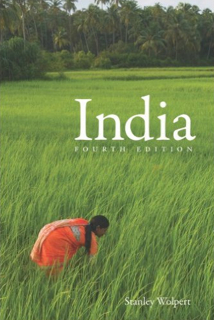
436. India (4th Edition) – Stanley WolpertA general introduction to India. An older edition would have suited our needs better, as this edition has been “updated”. Described as a Comprehensive, Short, and Readable overview by some, and as ‘awkwardly written’ by others. Amazon aren’t offering a preview by which we could judge for ourselves, but editorial reviews support the first and contradict the complaint. 264 pages, new for $15.98 (Amazon $32.88), used from $6.30. |
|||
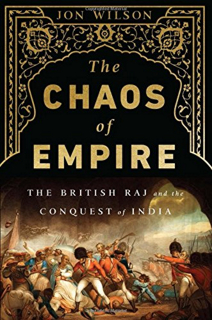
437. The Chaos Of Empire: The British Raj and the Conquest of India – Jon WilsonA book that doesn’t quite live up to pricing standards for this list but that was too relevant to ignore. Until independence was granted to India in 1947, it was ruled by the British Raj – a selected class within Indian society who were elevated to rule by proxy and rubber-stamp whatever the British Government’s representatives decided. It was a system designed to protect British power and not the welfare of those it administered, and it was absolutely in effect during the Pulp Period. Hardcover, new $20.95 (Amazon $25, which is slightly cheaper) and used $21.33. Even combining both, there are only 28 copies left. Remarkably, Amazon list the publication date as 11 days from when this text is being written, and describes it as their #1 New Release in India History. The product details back up the publication date, however, virtually ensuring a reprinting that will bring prices down – this looks like being a best-seller. 584 pages. |
|||
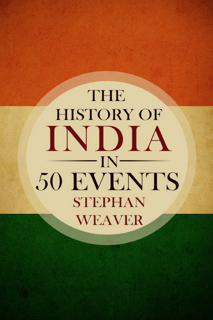
438. The History Of India in 50 Events – Stephan WeaverThe title says it all, really – 50 events critical to the formation of Modern India. Don’t expect page numbers; this is history in bite-sized sequential pieces, good for a quick overview of history and little more than a starting point to anything further. 84 pages, Kindle (3.19), and Paperback (New $8.80, Amazon $12.99, Used $10.89). |
|||
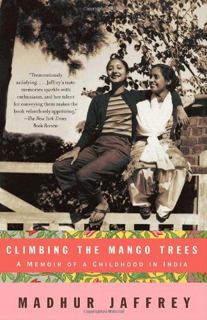
439. Climbing the Mango Trees: A Memoir of a Childhood in India – Madhur JaffreyThe author is an food writer and actress who was born in 1933 as one of six children to a prosperous businessman and with a vast extended family – often 40 people at dinner – under the benign but strict thumb of her grandmother. This is her memoir of that childhood, including 30 recipes that she has recovered from those memories and times. Expect a foody-orientation to this slice of period history, then, but the era is definitely pulp. 324 pages, in Hardcover and paperback; new of either from $4-4.50, used copies of either one cent. |
|||
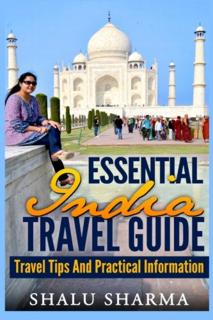
440. Essential India Travel Guide: Travel Tips and Practical Information – Shalu SharmaThe most highly-rated of the India travel guides other than those explicitly targeting ways women can protect themselves while visiting the country. “Covers everything you need from places to visit to dealing with beggars and how to protect yourself”. “India is a great country for holiday but it can be rough at times. Sadly, many incidences and crimes do happen and many of them are directed at foreign travelers. Many foreigners end up being ripped off their hard earned money. Most people in India working in the tourism industry do not realize that even in the West, one has to work hard for their money and do not have surplus to squander around.” The product description actually lists all 37 chapters, and many of them would be just as relevant in the pulp era as they are now. 176 pages, Kindle ($4.11) and Paperback (Amazon $10.80, New 3rd Party $7.44, used $0.71). |
|||
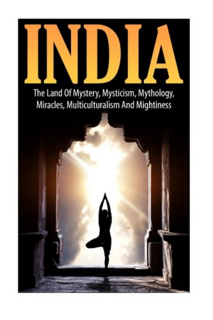
441. India: The Land of Mystery, Mysticism, Mythology, Miracles, Multiculturalism, and Mightiness – John KPart travel guide, part review of Indian religious beliefs and mysticism, the compound produces a strangely pulp flavor. See if you agree: the first four chapters are entitled “Mysterious Spots in India”, “Mysticism in India”, “Religious Myths in India”, and “Miracle Healing and Powerful Manifestation of Supernatural in India” (sic). Then again, there is the conundrum of what to make of an author who uses an initial for his surname and who’s bio makes him sound like a self-help guru. Judging from both that description and the chapter titles, he also seems to have problems with plurals and the word “the”. Even with these faults, this is too pulp-like to ignore. 84 pages, Kindle ($4.11) and Paperback (Amazon $9.99, 3rd parties new $7.31, used $6.40 – making Amazon the better choice by about $1). |
|||
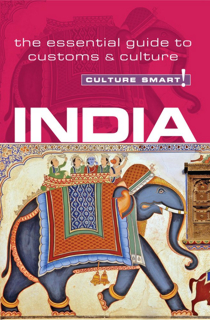
442. India Culture Smart: The Essential Guide to Customs & Culture – Becky StephenIndia has been changing rapidly since 2003, when it entered an economic boom – which was followed more recently by the GFC of 2007-08. The 2010 version of the guide emphasizes that it has been completely revised to highlight “the many subtle and not-so-subtle changes that are taking place in Indian society, describes and explains those areas of life where traditional attitudes and practices continue to prevail, and offers original insights, practical tips, and vital human information to guide you through the pitfalls and delights of this complex, vibrant, and increasingly important country.” The review most customers rely on is critical: “I had hoped for a book with a lot of cultural insights. Instead most of the book is written in ‘Wikipedia style’. It mainly consists of facts.” A more positive interpretation follows – “The chapters are broken up into bite sized chunks which makes this easy to read and dip in and out of. It also had various photos throughout, although rather frustratingly these aren’t labeled so you know what you are looking at! This offers plenty of advice to dodge the most obvious social faux pas and should help you get the most out of your time in the country and in your relationships with its citizens.” The 2016 edition is positively ebullient about the country in comparison; it reads like it was written by the Indian Tourist Board, or whatever the equivalent is called. It gushes so much that we felt in the presence of a used car salesman – it was trying too hard. Both are 168 pages in length. The 2010 edition is free as an Amazon audio book with their Audible trial offer, and the paperback is $0.49 new, $0.01 used, or $9.95 through Amazon. The 2016 edition is available in Kindle ($7.49) and Paperback (Amazon $7.94, New $5.67, and Used $6.86). Based on the product descriptions, we would recommend the older edition over the newer, and not just because they are cheaper. 2010 edition (pictured): http://amzn.to/2doBC93 2016 edition: http://amzn.to/2dOW56y |
|||
Books about Delhi
|
|||
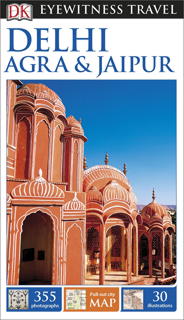
443. DK Eyewitness Travel Guide: Delhi, Agra, and JaipurAs usual, maps, floor-plans, and 3-D cutaway diagrams are prominent features of the DK guides. This covers everything from the Taj Mahal to the local wildlife, temples, bazaars, museums, and other attractions. 312 pages, paperback and flexibound; the latter are cheaper at the moment (especially buying direct from Amazon), but look carefully when you go to purchase as all the prices are close. |
|||
Books about Bombay/MumbaiThe city known as “Bombay” and often referred to as the gateway to India was renamed Mumbai in 1995, a consequence of power shifting between ethnic groups and a rise in nationalism that occurred throughout India at the time; many places were renamed to shed unwanted ‘legacies’ of British rule. |
|||
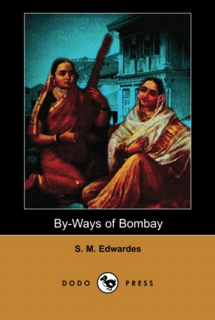
444. By-Ways of Bombay – S M EdwardesOriginally published in 1912 and now free of copyright, this book is floating around in two forms – kindle/scanned (which excludes the photographs and cuts the length to 44 pages) or printed paperback which comes in a variety of page counts: 44 pages (1 copy, generic cover), 88 pages (23 copies, proper cover), 104 pages (14 copies, generic cover), 118 pages (1 new at $89, 2 used at $2000, generic cover), and 156 pages (1 new at 22.99, and one used at $2,101.99, generic cover). According to a customer review, the 96-page version (!) includes photographs; we therefore suspect that all printed versions except the 44-page one may have photographs. Although Amazon offers to let you “look inside” a number of these, this simply previews the (picture-less) Kindle version, so it’s no help. (One reason for the proliferation of copies is that Project Gutenberg scanned it once its copyright expired, removing the images as is that project’s usual practice; many of these copies are simply rehashing this digital version). But it’s not for the images that we recommend this book; they are just a bonus if you get them. This is the anecdote recollections of a Government Official in Bombay and wrote about the people that he encountered. Edwards died in 1927 on January 1; 19 of the stories within this book were originally published in the “Times Of India”, the 20th was added in the second edition and was first published in the “Bombay Gazette”. These local encounters may date from 1912 to 1927, but they should be readily transferable to any point in the Pulp Era to give the GM a shot of instant color for his campaign. We are linking to the Dodo Press 88-page version because it’s the only one with enough copies available at a reasonable price. The Kindle version is free, new copies of this paperback are $4.05 and used copies are $7.32. |
|||
 |
|||
Books about Africa (excluding Egypt)
|
|||
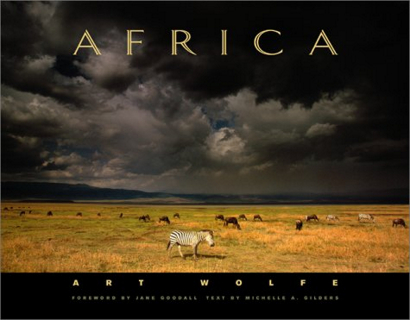
445. Africa – Photographs By Art Wolfe, with text by Michelle A GildersA photographic collection that covers five ecosystems and represents 20 trips to Africa over a twenty-year period. Gilders provides five essays. This shouldn’t be in the list but is so comprehensive that we couldn’t refuse it. 240 pages, 11.3 inches x 14.9 inches – this is a big book. Increased P&H will certainly apply. Ignore the collectible and new versions of this hardcover, they are out of reach. There are used copies starting at $21.92, and Amazon has the cheapest of them right now. |
|||

446. Serengeti: Natural Order On The African Plain – Mitsuaki IwagoA second photo-book, this one focusing on the Serengeti Plain. Higher page count (327), smaller page size (10.2 inches x 8.1 inches), and – despite that higher page count, a thinner book (0.9 inches vs 1.1 inches). That tells us that this is printed on lower quality paper than the Wolfe collection. Total weight is about half of the previous book, further supporting this impression. There are only 21 copies of this book, all are used, and the cheapest is one cent. |
|||
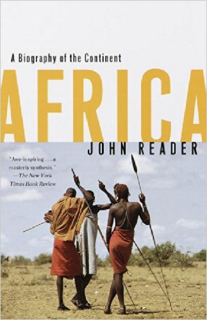
447. Africa: A Biography Of The Continent – John ReaderAt 816 pages, this is probably more African history than any GM needs, pulp or otherwise. This is the complete story from the dawn of man to the modern day. But the prices for such a comprehensive book are unbelievable, and we could not refuse it. Fortunately, it is well-indexed and with a comprehensive bibliography. The Kindle edition is $12.92. The book is new from Amazon for $13.88. There are 61 new copies from other vendors for $4.98, and 111 used copies from $3. |
|||
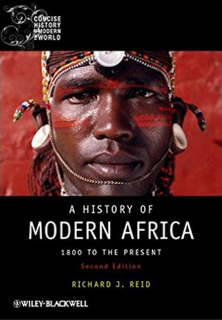
448. A History Of Modern Africa: 1800 To The Present (2nd Edition) – Richard J ReidThis is a more focused history, dealing with the continent from the time Europeans started getting involved. Unlike most such histories that are written in English, this book places a greater focus on the story from an African point of view, especially during the colonial period, and includes in-depth coverage of non-Anglophone Africa. This history is current to 2011. It is 408 pages in length, so there is room for a great deal more detail than the comprehensive history offered previously allows but we’re dealing with an entire continent here; a little under two pages a year average seems barely adequate for such a vast topic. Amazon list it for $18.99 (+P&H) used and $41.83 new; third-party vendors offer it for $22.97 new. Amazon have the low price for a used copy. It is also available in “e-textbook” format. Clearly, we are recommending used copies. |
|||

449. Beyond Empire And Nation: The Decolonization Of African And Asian Societies 1930s-1970sThis was almost relegated to the honorable mentions; it’s too expensive, and there are not enough copies (neither of which was the case when it was first considered. This 304-page history focuses specifically on the rise of independent nations within Africa as the Colonial powers relinquished their hold, sometimes with great reluctance. But more than just the events, this book looks at the consequences for each on the people, the society, and the economies, and that was what convinced Mike to convince the rest of us that it should stay. Amazon list new copies at $32, and used copies at $21.41. Third party vendors offer 11 new copies for $22.75; Amazon has the low price on used copies, of which there are also only 11. |
|||
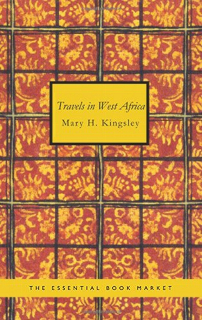
450. Travels In West Africa – Mary H KingsleyThere are lots of reprints of this out-of-copyright book but in most cases they are too expensive or too few in numbers. In 1893, Kingsley found herself at loose ends for the coming five or six months and decided to spend them exploring Africa. This 458-page book is her report of the expedition. Much of what she found would remain relevant until, piece-by-piece, the path of her journey intersects a newly-created nation (or one in a state of unrest). There are 28 new at $24.99 (but Amazon is cheaper at $28.99 once P&H is taken into account), and there are 18 used copies at $2.72. |
|||
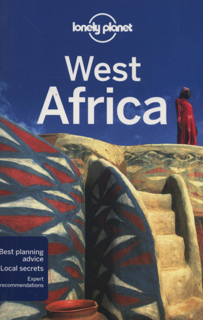
451. Lonely Planet West Africa – Anthony Ham, Jean-Bernard Carillet, Paul Clammer, Emilie Filou, Tom Masters, Anja Mutic, Caroline Sieg, Kate Thomas, And Vanessa WrubleRather than trying to list travel guides for each individual state, we wanted to address the problem geographically. It turns out that Lonely Planet had the same idea, and that copies were both acceptable and numerous. The ‘West Africa’ book is 520 pages. Kindle $19.25, Paperback from Amazon $25.32, third parties list 56 new from $13.20 and 29 used from $5.44. |
|||

452. Lonely Planet Southern Africa – Alan Murphy, Kate Armstrong, Lucy Corne, Mary Fitzpatrick, Michael Grosberg, Anthony Ham, Trent Holden, Kate Morgan, And Richard WatersIt’s important to note that this is Southern Africa and not South Africa – the latter being the name of one particular nation within this broader region. 760 pages. Amazon want $25.73 for a new copy (and have only 20 left) or $17.98 for the Kindle edition. Third parties offer 72 new starting at $15.47 and 33 used from $7.48. | |||
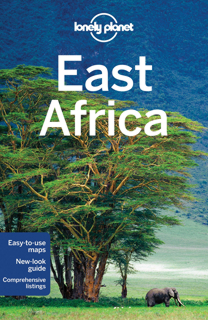
453. Lonely Planet East Africa – Anthony Ham, Stuart Butler, Mary Fitzpatrick, And Trent HoldenFor some reason, there aren’t as many reviews of the East Africa book. 664 pages. Amazon have new copies for $23.32 and a Kindle edition for $19.17. Third parties offer 65 new at $15.24 or more and 23 used at $17.23 up. So, for now at least, new copies are cheaper than used. | |||
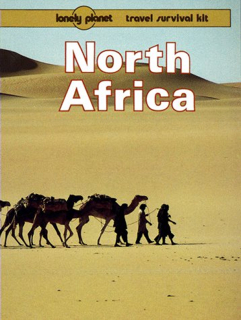
454. Lonely Planet North Africa – Damien Simonis, David Willett And Ann JousiffeThe North Africa part of the coverage dates back to 1995 and is almost certainly out-of-date with respect to the modern world, unlike most of the earlier listings. That affects the price of this 800-page volume: there are 7 new at $36.86 and climbing, and 27 used at one cent. | |||

455. Lonely Planet Central Africa – Alex NewtonCompleting the quintet is this 564-page volume from 1994. There are 6 new copies at $10.39 or more and 26 used copies at one cent plus. |
|||
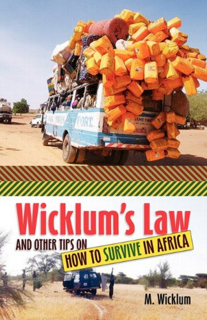
456. Wicklum’s Law and other tips on How To Survive In Africa – Michael Wicklum“Invaluable information” and “anecdotal commentary” that documents seven trips across a combined total of 14 countries. We’re worried that some of the content will refer to SUVs and mobile phones, but most of it should be applicable either as a casual encounter for the PCs or as genuinely useful advice / instruction to them. Be warned that this book also lists in Amazon’s humor section. Kindle for $4, Paperback from $11.64 new or $2.01 used; Amazon have one copy at $19.99. |
|||
Books About The Sahara
|
|||
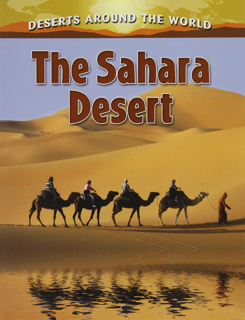
457. The Sahara Desert – Molly AloainThe Sahara desert reaches into 12 countries and occupies a greater land area than the entire United States. This book is about the Geological makeup of the desert. A 32-page book aimed at children, and a little expensive on that basis – Paperback $9.95 from Amazon, 30 new at $5.10 from third parties, who also have 14 used at $3.98. There is also a library binding available; Amazon want $27.60 for theirs, there are 13 new at $6.80 and 8 used at $3.98. |
|||
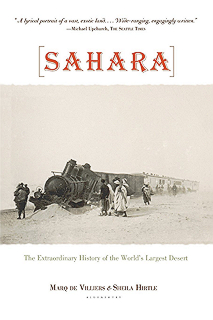
458. Sahara: The Extraordinary History of the World’s Largest Desert – Marq de Villiers and Sheila Hirtle“In the parched and seemingly lifeless heart of the Sahara desert, earthworms find enough moisture to survive. Four major mountain ranges interrupt the flow of dunes and gravel plains, and at certain times waterfalls cascade from their peaks. Even the sand amazes: massive dunes can appear almost overnight, and be gone just as quickly.” The Sahara is full of unexpected twists, as this book, which focuses on the desert and its people, reveals. 320 pages Paperback, Amazon $14, third parties have 22 copies new at $9.83 and 39 used at one cent. There is also a collectible copy at $15. |
|||
Books About “Darkest Africa” not listed elsewhere
|
|||
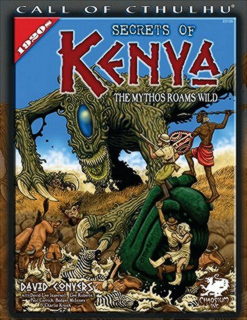
459. Secrets of Kenya: The Mythos Roams Wild – David Conyers“Africa strikes fear in the hearts of civilized Westerners for its savage tribes, fierce animals, impenetrable jungles, vast deserts, lost civilizations, slave traders, contagious diseases–and the unknown.” The ‘Dark Continent’ is a mystery, the least understood, most dangerous, least explored of all the six habitable continents. Diseases, beasts, and savages pose effective barriers to exploration. And that means that if you get past them, strange things may wait to be discovered – dangerous things, things man was not meant to know… |
|||
Books About Morocco
|
|||
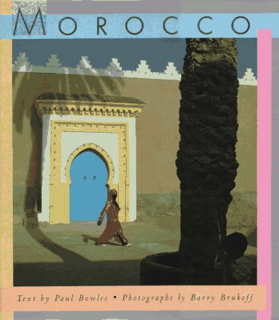
460. Morocco – Photographs by Barry Brukoff with text by Paul BowlesSecond only to Egypt, during the Pulp Era, Morocco was perhaps the most exotic and mysterious “known” location in Africa. It is, perhaps, no coincidence that the two are both bordered by the Mediterranean Sea to the north, and of course, the Iberian Peninsula is only 7.7 nautical miles (14.3 km) away at the narrowest point in the Strait Of Gibraltar. Just far enough to entice the imagination, just strange enough to be mysterious, just close enough to tease with that mystery. No American writer is more closely associated with Morocco than Paul Bowles who traveled there in the 1930s and remained for many years. In 1991, Barry Brukoff went to Morocco to meet Bowles and persuaded him to provide text to accompany his photographs of the country. This collection is the result. 128 pages, new at $137.75 but there are 24 used copies that start at $17.48. |
|||
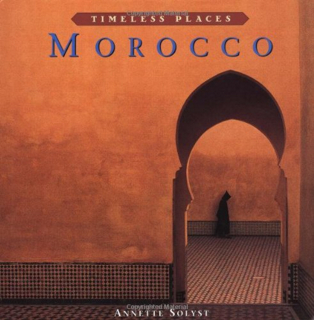
461. Morocco – Annette SolystA second photographic collection simply because this one is so affordable. 96 pages, 8 new copies out of reach at $43.80 but 45 used starting at just one cent. |
|||
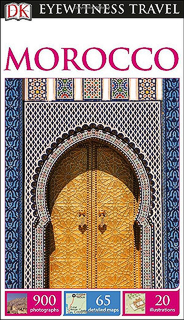
462. DK Eyewitness Travel Guide to MoroccoThis travel guide has 26 reviews and an average rating from them of 4.9 on the 2012 edition. The 2015 edition doesn’t fare quite as well – 16 reviews at an average of 4.6. Combining both, there has been only one negative review, who was complaining about readability and tiny type more than anything else. Everyone else loves it, emphasizing comprehensiveness and accuracy and value-adding to their trips. Well, we don’t expect to be visiting Morocco anytime soon, but our PCs might do so anytime. The older edition is slightly larger (408 pages plays 396), and is cheaper, so that would be our first choice, but the newer one is close enough in price that this ratio could flip after a single sale, so make sure to check both before committing. 2012 edition: http://amzn.to/2e2YSZC 2015 edition (pictured): http://amzn.to/2e2Zb6I |
|||
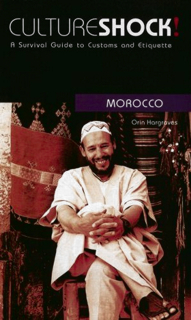
463. Culture Shock Morocco: A Survival Guide to customs and Etiquette – Orin HargravesThe author served as a Peace Corps volunteer in Morocco in the 1980s and is an accomplished writer. Customer reviews indicate that the content has not dated at all. 296 pages, Kindle ($4.82), Paperbacks 6 New from $19.97 and 23 used from $2.38. |
|||
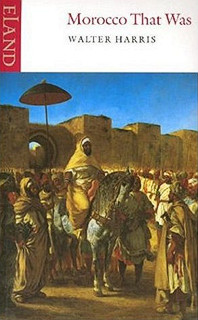
464. Morocco That Was – Walter Harris“Until 1912 Morocco never suffered foreign domination, and its mountainous interior was as closed to foreigners as Tibet. Walter Harris (1866-1933), though, was the exception. He first visited in 1887 and lived in the country for more than thirty-five years, and as the Times correspondent had observed every aspect of its life. He was an intimate of at least three of the ruling Sultans (as well as King Edward VII) and a man capable even of befriending his kidnapper. It was said that only three Christians had ever visited the walled city of Chechaouen: one was poisoned, one came for an hour disguised as a rabbi, and the other was Harris.” The content predates the Pulp Era – but it might be fun to extend the era of the Sultanate into that period, or perhaps have a warlord install himself in that position. Either would be Very Pulp, and worth considering. If you choose to go that route, this book could be indispensable. Kindle ($6.08), Paperback (Amazon $24.48, 21 New $9.03, 13 used $9.05). |
|||
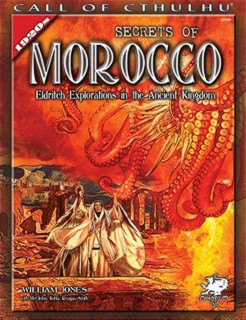
465. Secrets Of Morocco – William JonesCall of Cthulhu 1920s sourcebook. “Learn of the ancient traditions of Morocco, of its war torn cities, and its rebels. Venture through the land as it was in the 1920s and 1930s. This Call of Cthulhu roleplaying sourcebook contains the historical information and the Lovecraftian Mythos details to adventure in one of the world’s most exotic lands.” |
|||
 |
|||
Books about The Middle East
|
|||
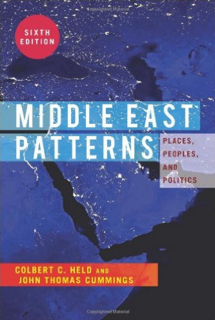
466. Middle East Patterns: Places, People, and Politics (6th Edition) Colbert C Held and John Thomas Cummings“…the most comprehensive and authoritative geographical study of the region. Colbert C. Held and John Thomas Cummings introduce the Middle East from a topical perspective and then provide in-depth country-by-country coverage.” Comparative information on resources, human, and social development; analysis of ethnographic, economic, and political patterns; sections on health issues, business environments, and the historic US presence in the region. 728 pages, new $41.08 (from Amazon) or from $14.22 (third parties), used from $7.95, also available in eTextbook format and Amazon also have a ‘rent’ option. |
|||

467. The Complete Idiot’s Guide To The Crusades – Paul L Williams PhDWhile some European History books might touch on this subject, as might some of the “Nazis & The Occult” books, this is one of the few books on the Middle East that seems useful in a Pulp Context, however indirectly. Plots dealing with the consequences of the past are the obvious point of relevance (Indiana Jones & The Last Crusade), but some of the fortifications erected in consequence can make great locations for a pulp adventure, treasures that might have been lost or abandoned can make great starting points for adventures, and parts of the Middle East are international crossroads of renown in the Pulp “now” just as much as they were then. |
|||
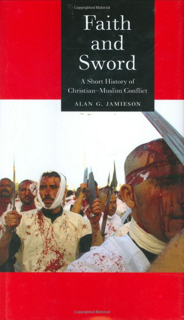
468. Faith and Sword: A short history of Christian-Muslim Conflict – Alan G JamiesonThe product description raised a few hackles amongst us very quickly by implying that the most extreme elements of the modern-day Middle East are representative of Muslims as a whole. That sort of generalization is both lazy and gives fuel to anti-Islamic extremism that is just as pernicious, vile, and evil as the terrorism that it claims to want to defend against. This is a sore spot for us, even though we are neither Muslim nor Islamic ourselves, and are just as scathing of excessive political correctness, and this rubbed us the wrong way immediately. Deciding to put the best possible face on it, dismissing it as a misguided attempt to make this book appealing to a specific target market or a naive attempt to justify the point that the reviewer was making, we moved on to the rest of the paragraph, which discusses the actual content of the book: “Alan G. Jamieson explores here the long and bloody history of the Christian-Muslim conflict, revealing in his concise yet comprehensive study how deeply this ancient divide is interwoven with crucial events in world history.” There is no doubt that these are divisive issues, not least because because of the baggage that arises as a result of the long history of the conflict, and the polarized views that are fueled by acts of extremism and over-generalization. Hate crimes are condemned when a member of our society commits them; why are the same standards not applied to differentiate between those of Islamic faith and extremists? This led us to the serious question of whether or not inclusion of this book was pandering to the extremist counter-reaction, or risked doing so. Ultimately, the customer comments convinced us that the book itself was neutral and unbiased, neither pro-Christian or pro-Muslim, and our own values mandate that an informed debate is more successful than an uninformed one. So it makes the list because, undeniably, these events occurred and were instrumental in shaping the Middle East that we see today. All that said, why should you consider buying it? Even though it is short at 256 pages, it appears to be inclusive and comprehensive without oversimplifying or accepting any bias one way or the other. That makes it an excellent reference resource on the subject. |
|||

469. Ploughing Sand: British Rule in Palestine 1917-1948 – Naomi Shepherd“After the First World War the British in Palestine were handed an ambiguous” – some would say ‘impossible’ – “brief: to encourage the formation of a “national home” for the Jews and to protect the “civil and religious rights” of the local Arabs. Colonial officials … attempted to legislate for the benefit of Arabs and Jews alike, but saw many of their laws on immigration and land evaded by both, often in collusion. Trying at first to settle political” (and social and religious) conflict by persuasion and conciliation, in the end they turned disastrously to force. This study is the first to reconstruct in detail the workings of the troubled Mandate administration, and the influence of its chief personalities.” The title is based on a quote on the situation by a leading official who expressed his frustration that all their constructive efforts in Palestine had been like “ploughing sand”. 304 pages, 27 used copies from $3. |
|||
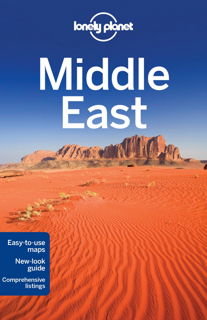
470. Lonely Planet Middle East – Anthony Ham, Sofia Barbarani, Jessica Lee, Virginia Maxwell, Daniel Robinson, Anthony Sattin, Andy Symington, and Jenny WalkerAs with Africa, the only travel guide that has adopted a broad, regional approach is Lonely Planet; the others focus on specific countries or even specific cities. Lonely planet have those, too, but they also provide these broad overviews, which are excellent for the GM who only needs a general introduction. |
|||
Books About Arabia
|
|||

471. The Complete Idiot’s Guide to Understanding Saudi Arabia – Colin WellsThere aren’t many affordable general introductions to Saudi Arabia, so this book caught our eye. If we were relying on the product description alone, we would have passed on including it, but there are a number of substantial reader review that sold us – “the ultimate primer on this subject” is the tag-line of the first, and “make this your first stop on learning about Saudi Arabia” headlines the second. “The Complete Idiot’s Guide to Understanding Saudi Arabia is in four parts. Historical background, the Gulf War and its aftermath, Saudi society, and the terrorism issue. It includes an FAQ, a timeline, a bibliography, a glossary, and an index. Definitions, notes, and cross references abound. The book also benefits from lively prose and juicy humor. And the author shares his opinions and predictions liberally.” – excerpted from the first review mentioned. This book fills the brief perfectly, and nothing else we found did so within our budget (or even two-three times our budgetary limits). 336 pages, 10 new from $18.80, 1 collectible from $14.90, and 47 used from one cent. |
|||
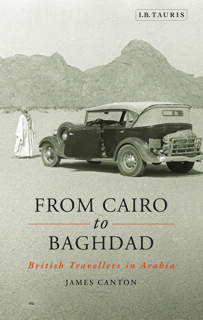
472. From Cairo to Baghdad: British Travelers in Arabia – James CantonBritish travelers to Arabia were, until the 1880s, mostly wealthy dilettantes who could fund their travel privately, or diplomats and envoys. When the British seized power in Egypt, it opened the door for ordinary people to visit the region. “Missionaries, soldiers and spies as well as tourists and explorers started to visit the area, creating an ever bigger supply of writers, and market for their books.” – but as British power faded after World War II, so did both the demand for and providers of these traveler’s tales. In this book, James Canton studies “over one hundred primary sources, from forgotten gems to the classics of T E Lawrence, Thesiger and Philby.” in order to understand the Middle East Travel-Writing phenomenon and how it relates to Imperial Britain. More importantly, there are numerous excerpts from the source material, providing the reader/GM with ample flavor encounters for the region. New Hardcover copies are out of reach at $52.66 ($110 from Amazon), but there are 16 used copies at $6.29. On top of that, Amazon have the Paperback at $24 – but third parties have 29 new copies at $11.58 and 12 used at $12.56. |
|||
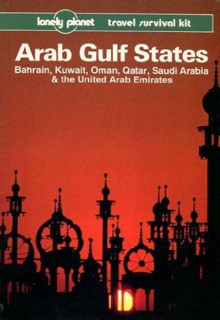
473. Lonely Planet Arab Gulf States: Bahrain, Kuwait, Oman, Qatar, Saudi Arabia & the United Arab Emirates – Gordon RobisonAs with the travel guides to Africa, the only one that takes a regional approach is Lonely Planet. There is a newer edition of the guide but changes happen so quickly and substantially in the Middle East that the space devoted to recent developments is wasted for our purposes, so the older one is fine – so long as cheap copies last. This edition dates back to 1993 and is 300 pages in length. There are 8 new copies starting at $15.68 and 33 used copies costing at least one cent. |
|||
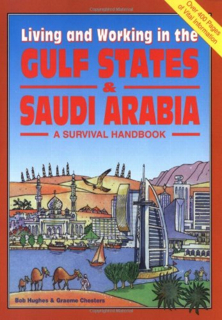
474. Living and Working in Saudi Arabia: A Survival Handbook – Robert HughesCustomer comments make clear that this 2004 guide is nowhere near adequate for actually going to work in the Gulf region for an extended period, but as a quick introduction suitable for keeping brief visitors with a modicum of common sense out of trouble for a few days, this does the job, and does it far better than any of the other culture guides which contain information that has been branded not only incorrect but potentially dangerous, incomplete, or out of date long before they actually saw print. So this 420-page effort gets our tick of approval. There are 6 new from $17.28 and 28 used starting at one cent. |
|||

475. Gurps Arabian Nights – Phil Masters (Steve Jackson Games)While this setting predates the pulp era, it is easily transferable and full of pulp-era possibilities. |
|||
Books about Persia/Iran
|
|||
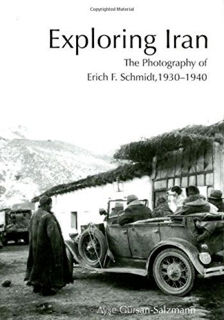
476. Exploring Iran: The Photography of Erich F Schmidt 1930-1940 – Ayse Gursan-SalzmannIn 1931, the Penn Museum sponsored an archaeological expedition to Iran for the first time. Erich F Schmidt excavated the “Bronze Age site of Tipe Hissar near the town of Dmghan and the monumental buildings of the pre-Islamic Sasanian Palace.” In the course of the dig, Schmidt “documented the project with nearly 2,600 … photos” of “desert and mountain tribes, the sites, government administrators, and a full panoply of the people he encountered.” In this book, the author has selected “64 memorable and instructive prints from the Museum’s archives” and “assembled dozens more from the Schmidt Collection, Chicago’s Oriental Institute, and from family members for an accompanying CD-ROM.” A second supplemental package was assembled in 2007. Both these archives of additional material may be downloaded in PDF form by going to http://core.tdar.org/project/376583; the links to each archive are near the bottom of the page. Opening an archive page and scrolling to the bottom will take you to the PDFs, which contain the additional photographs. This hardcover book is 112 pages and published by the University of Pennsylvania Museum of Archeology and Anthropology. Amazon list it for $29.95 (adding that it is ‘temporarily out of stock’) but third party vendors have 19 new at $17.52 and 14 used at $19.97. |
|||
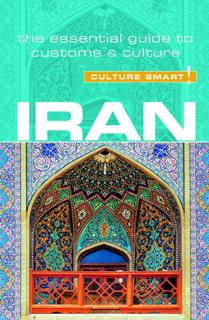
477. Iran Culture Smart: The essential guide to Customs and Culture – Stuart WilliamsThis is the best-rated travel guide with a substantial review total. “Travelers have long been seduced by the echoes of the extraordinary ancient history contained in the word “Persia.” But Iran is also a modern society that is experiencing great change. Although it is still feeling the effects of the Islamic Revolution of 1979, social restrictions have loosened considerably in recent years. Strict Islamic rules coexist with an increasingly dynamic society driven by an overwhelmingly young population. Animosity toward the West at a political level sits side-by-side with a wholehearted welcome for foreigners as individuals.” One customer claims to have put it down as worthless after reading only a few pages, with no indication of any first-hand experience before or after, but many others report that its content exactly matched their experiences when visiting Iran. Which is good enough for us. During the Pulp period, there had, as yet, been no US intervention and a Shah still reigned; but if you replace “American” (or similar terms) with “British” or “Catholic”, you won’t be too far off the mark, as the major cause of official friction with Iran at the time was the Crusades, and the evidence is that their reaction was exactly the same: welcoming of individuals, hostile toward the government and institutions. Kindle and Paperback, new copies are currently cheaper and more plentiful than used. |
|||
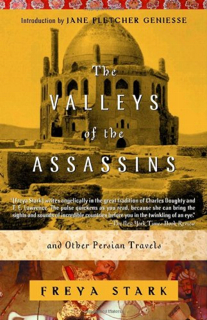
478. The Valleys of the Assassins and other Persian Travels – Freya StarkFirst published in 1934, “The Valleys of the Assassins” established Stark as “one of her generation’s most intrepid explorers”. The book “chronicles her travels into Luristan, the mountainous terrain nestled between Iraq and present-day Iran, often with only a single guide and on a shoestring budget” – and, of course, she wrote about what she found and who she met. 320 pages of real-life pulp-era encounters and scenes for the GM to plunder. Hardcover: $45 used, $59.95 collectible, no other new copies. Paperback: $13.59 new from Amazon, 57 new through others starting at $8.40, and 45 used copies for $2.97. |
|||
Books about Turkey
|
|||
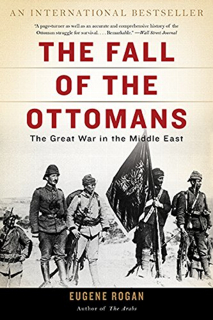
479. The Fall of the Ottomans: The Great War in the Middle East – Eugene RoganThe most significant event to occur in Turkey prior to the Pulp Era was the defeat of the Ottoman Empire in the First World War. Arguably more catastrophic than the Great Depression, the aftermath saw the partition of Ottoman lands, laying the foundation for the conflicts that trouble the Arab world to this day. This book studies not only the course of the war within the Middle East but the aftermath. This book received rave reviews from a number of high-profile sources – everyone from the Guardian (UK) to the Wall Street Journal and the New York Times. 331 Customer Reviews at Amazon give it 4.5 out of 5 stars. The most common complaint is that the map is missing from the Kindle Edition and it’s impossible to follow the situation as it develops without one. The second most common complaint is that the writing style is dry, factual, and non-narrative. Which is what we generally expect from a scholarly analysis, though we can’t speak for anyone else. 512 pages. Kindle (not recommended) $11.40, Hardcover $19.75 (Amazon) plus third-party 67 new from $15.57 and used from $12.02; Paperback $11.48 (Amazon) plus from third parties, 39 new from $11.29 and 13 used starting at $13.36. Hardcover: http://amzn.to/2ebdWYO Paperback: http://amzn.to/2e4prxB |
|||
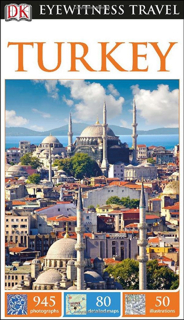
480. DK Eyewitness Travel Guide to TurkeyCustomer ratings and reviews establish this as currently the best available travel guide to Turkey, which is probably why Amazon has run out of copies – but if they had them, they would charge $30 for one. Other vendors still have some – 16 new starting at $7.99 and 27 used starting at one cent. Given that this is a 2014 edition, we would expect a new edition soon (if there isn’t one already that is not so highly rated). |
|||
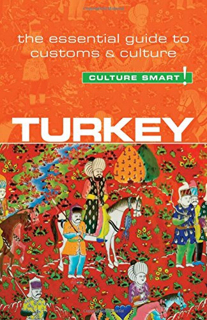
481. Turkey Culture Smart: The essential guide to customs and culture (2nd edition) – Charlotte McPhersonAll the Culture Guides to Turkey had similar (excellent) ratings, but this is the most affordable. That said, the most serious objection is a substantial one: omissions of significant content that should be there – IF this was a travel guide and not a Cultural reference. Honestly, some people… 168 pages; Kindle and paperback. Amazon’s stocks are beginning to get low, but it’s so much cheaper (either new or used) that this shouldn’t bother anyone for a fair while. |
|||
Books about Istanbul
|
|||
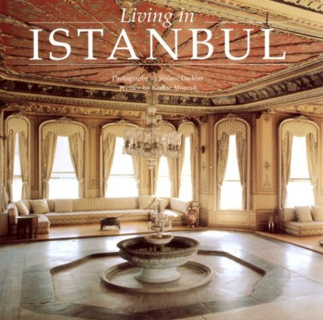
482. Living In Istanbul – Jerome DarblayThe diverse cultures – Greek, Roman, Byzantine, Turkish, and more – that have resided in Istanbul have left their marks on the architectural style of the city, producing in the most elegant of buildings a stylistic fusion that cannot be found anywhere else. This specially-commissioned photographic collection unveils the secrets of the city and its many wonders. Incorporates a visitor’s guide to “hotels, restaurants, traditional shops, museums and other attractions” – at least some of which will be useful to the Pulp GM. |
|||
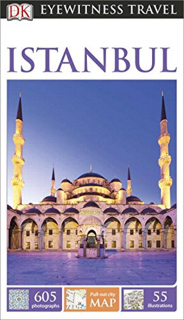
483. DK Eyewitness Travel Guide to IstanbulThis 280-page guide has all the usual features of a DK Travel Guide – cutaway 3D diagrams, floor plans, maps, etc – and comes with a pull out map (possibly missing in used copies). Paperback, $19.06 from Amazon (only 17 in stock); third party vendors have 17 new starting at $6.99 and 33 used starting at one cent. This travel guide received ratings a full star or more (out of five) higher than the others we looked at. |
|||

|
|||
For DummiesIn most cases, we haven’t read any of these, and are recommending them for consideration based purely upon the publisher’s descriptions and on general principles except where otherwise noted. This also shifts the content of each review from one of “this book is recommended and here’s why” to “this book might be useful and here’s why”. We have made the assumption that availability and price would fall within our parameters, or close enough to them; we have rarely found this not to be the case. Selected works were so promising and so relevant, that they have been promoted to the main list of recommendations, excluding them from the above caveats. A notes about Complete Idiot’s GuidesWhile the “For Dummies” series has a website that lists all the books currently available in the series, there is no equivalent for the “Complete Idiot’s Guides”. Our blanket advice is that if Amazon lists a “Complete Idiot’s Guide” that matches the subject of one of our “For Dummies” recommendations, you should buy both. |
|||
Dummies Books about the Middle East:
|
|||
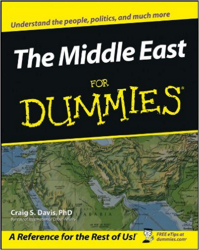
484. The Middle East For Dummies – Craig S. DavisThis is one of those books whose relevance is uncertain. An awful lot has changed, politically, since the pulp era, and our concern is that this will focus on the modern-day and not the historical periods that are Pulp-relevant. One thing that emerged from the Gulf Wars and the hunt for Osama Bin-Laden is that Americans don’t know enough about the Middle East, and at least half of what they think they know is incorrect in some degree. This is largely confirmed by the lengths that NCIS: Los Angeles has to go to in order to explain and provide context for, many of the middle-eastern oriented episodes. About 50 pages of this book seem to be at least semi-relevant but most of it is questionable in terms of a Pulp context. Worth buying a very cheap copy. |
|||

|
|||
Books about Egypt & Egyptology
|
|||
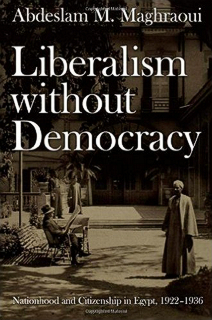
485. Liberalism Without Democracy: Nationhood and Citizenship in Egypt 1922-1936“The history of Western intervention in the Middle East stretches from the late eighteenth century to the present day. All too often, the Western rationale for invading and occupying a country to liberate its people has produced new forms of domination that have hindered rather than encouraged the emergence of democratic politics. Following Egypt’s independence of Great Britain in 1922, “Egypt’s reformers equated liberal notions of nationhood and citizenship with European civilization and culture. … in their efforts to achieve liberalization, they sought to align Egypt with the West and to dissociate it from the Arab and Islamic worlds, but this was a period of turbulent politics and resentment towards the remaining influence of the British, so their efforts were largely in vain in terms of legislated reform; but had a great impact on the attitudes of the people. That Political, Social, and Cultural influence and its consequences are the subject of this 216 page book from Duke University Press. Amazon want $22.95 for a new copy, but will send you a used one for $8.50. You can get a Kindle edition for $13.68. Or you can buy through a third party vendor – 27 new copies starting at $6.98 and 25 used starting from $2.77. |
|||

486. DK Eyewitness Travel Guide to EgyptThere are a lot of Egypt travel guides, as you can imaging, but this one with 4.5 stars out of five from 152 reviews, is the most popular. The customary DK features are included. 360 pages, new from Amazon for $17 or from third party vendors for $11.48; used copies are from $12.88. |
|||
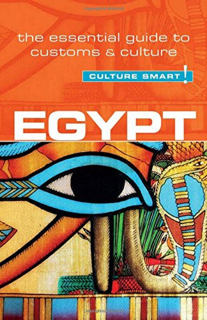
487. Egypt Culture Smart (2nd edition) – Jailan ZayanIt was difficult to predict how useful this guide would be since it has been updated to incorporate the Secular Revolution of January 2011. This event clearly changed the country, but how much did it change the culture, and how much had the culture already changed since the Pulp Era? Were the people completely different? We got the answers to these questions towards the end of the product description of this book, just as it had raised the questions: “this new edition of Culture Smart! Egypt explores the codes and paradoxes of Egyptian life. It outlines the countries’ history and shows the forces that have shaped its sensibility. It explains values and attitudes, and guides you through local customs and traditions. It opens a window into the private lives of Egyptians, how they behave at home, and how they interact with foreign visitors.” Clearly, cultural patterns were more robust than any mere political changes that had taken place; in fact, it was more likely that the political change was a consequence of a cultural shift, the long-term impact of the liberalism movement, perhaps? 168 pages, Kindle $7.14, Paperback $8.83 from Amazon, 22 new from $3.23, 19 used from $3.22. |
|||
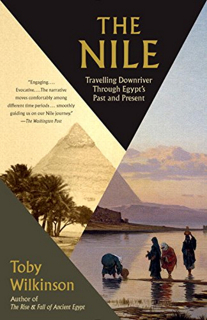
488. The Nile: Traveling Downriver Through Egypt’s Past and Present – Tony WilkinsonIt’s one thing to be taken on a tour by a tour guide, and quite another to be escorted by a renowned expert in the field of the sights that you will be seeing. This book is the next best thing – a virtual tour down the Nile by noted Egyptologist Toby Wilkinson, starting near the city of Aswan and end in Cairo, stopping off at the Valley Of the Kings and other points of interest along the way. 336 pages, Hardcover, Paperback, and Audible versions. |
|||
Books about Cairo
|
|||
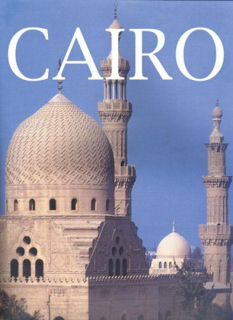
489. Cairo – Andre RaymondThe first thing to note about this book is the dimensions – almost ten inches by almost twelve-and-a-half, and more than an inch-and-a-half thick. In fact, the page count is 496 pages. When you see those stats, you should immediately think photographs, and you would be correct in doing so. This book covers, in images, the Cairo region’s history from before the city was founded in 969AD all the way to the 21st century. In that time, Cairo has been conquered many times, and each of the reigns are represented in the more than 600 photographs, reproductions and maps. A full bibliography, glossary, timeline, and index means that this book is the foundation for a researcher to investigate whatever takes his fancy more fully. Available affordably in both used hardcover and used or new paperback. |
|||
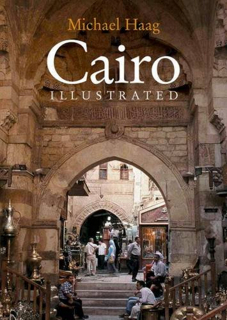
490. Cairo Illustrated – Michael HaagThis is also a photographic collection, but a considerably smaller one – 96 pages, 10.9 by 7.8 inches. Of particular interest amongst the 150+ photographs are exhibits from the Islamic, Coptic, and Egyptian Antiquities museums, but the remainder of the city is also explored. New copies cost $20 from Amazon, but third party vendors have 20 new copies from $11.52 and 13 used for $5.01. |
|||
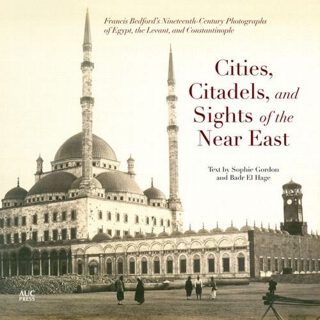
491. Cities, Citadels, and Sights of the Near East: Francis Bedford’s Nineteenth-Century Photographs of Egypt, the Levant, and Constantinople – Sophie Gordon and Bard El HageArguably, the only thing that might be more evocative than modern photographs might be images of the period. These proved hard to track down – there might be one collection in the honorable mentions if copies are still available when it gets revealed to the public late in the series – but even older photographs might be the next best thing. In 1862, the Prince of Wales, eldest son of Queen Victoria, embarked on a grand tour of the Middle East. Accompanying the royal party was a practitioner of the new art of photography, Francis Bedford; his mission was to capture images of the places visited by the young Prince. “The result is an extraordinary collection of some of the best early photographs of Cairo and the temples of Upper Egypt, Jerusalem and the Holy Land, Lebanon and Damascus, Izmir and Constantinople. From timeless views of the Pyramids, the Dome of the Rock, Baalbek, and Hagia Sophia to scenes from another age of the streets of Cairo or tall ships on the Bosphorus, 120 of Bedford’s most outstanding photographs are showcased”. We don’t think these locations would have changed all that much in the 50-odd years that separates this journey from the Pulp Era – the world moved at a more stately pace back then – aside from the differences in fashion, of course. The paperback is not at an agreeable price – 2 copies at $91 or more – but the Flexibound edition is more accessible; 28 new from $20.14 and 12 used from $10.80. |
|||
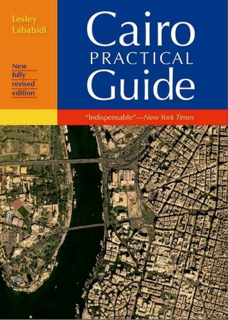
492. Cairo: The Practical GuideWith the visuals sorted, let’s turn to practical knowledge of the city and its contents. We usually employ travel guides in that capacity, and the older the better in most cases – at least up to a point. But for Cairo, we uncovered a series of gems – books that aren’t so much interested in the tourist attractions or even the culture, but in the practicalities of living in Cairo either briefly or for a longer period as the locals do. “The basics of daily life – finding a flat, transporting personal goods, investigating school options for children, navigating Egypt’s famous bureaucracy, and the intricacies of feeding and clothing oneself and one’s family from the local market – are all detailed here. Advice gathered from a wide range of Cairo insiders, both native and foreign, gives the reader a cornucopia of current facts on prices, neighborhoods, product availability, work and business opportunities, and the dizzying range of cultural and leisure pursuits that Cairo is famous for.” In addition, there are an “A-to-Z directory of goods, services, and interests subdivided by neighborhood; a language section on the basics of Cairene Arabic; and details on shopping and sightseeing from a resident’s perspective.” Nothing there that a GM can use, then. And if you believe that, there’s a bridge for sale in Brooklyn… 2008 (16th) Edition by Lesley Labahidi – Paperback, 256 pages; New from Amazon $10.95 or 12 from third-party vendors starting at $6 or 17 used from $0.36. http://amzn.to/2ehtCG4 2010 (17th) Edition by Claire E Francy and Lesley Labahidi – Paperback, 225 pages; New from Amazon $18.95 (but we don’t trust this to refer to this edition) or 11 from third-parties from $11.08 or 18 used at one cent. http://amzn.to/2dDxZdr 2011 (18th) Edition by Lesley Labahidi (pictured) – Paperback, 256 pages; Amazon quote $18.08 but state that it’s out of stock; 26 new from third parties from $11.33 or 15 used from $1.49. http://amzn.to/2dqIjYr |
|||
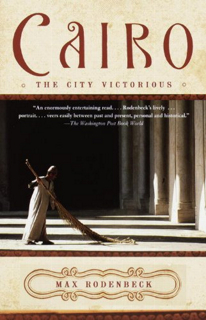
493. Cairo: The City Victorious – Max Rodebbeck“With intimate knowledge, humor, and affection, Rodenbeck [the author] takes us on an insider’s tour of the magnificent city: its back-streets and bazaars, its belly-dance theaters and hashish dens, its crowded slums and fashionable salons, its incomparably rich past and its challenging future.” 320 pages, paperback or hardcover, 165 new and used copies all told, and all quite affordable. |
|||
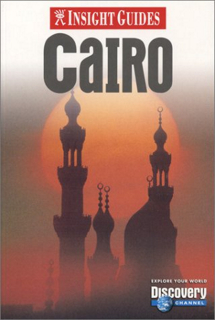
494. Insight Guide to CairoGiven the number of guides we’ve offered so far, and the list of books to come, we had to choose this as our city guide-book due to the emphasis that the Insight Guides place on the local culture and despite a general lack of information about this specific title in the series. 281 pages, 2003 edition, 9 new from $47.16 (too much for our standards) and 20 used from $0.13. |
|||

495. Cairo: City Of Sand – Maria Golia“Cairo is a 1,400-year-old metropolis whose streets are inscribed with sagas, a place where the pressures of life test people’s equanimity to the very limit. Virtually surrounded by desert, sixteen million Cairenes cling to the Nile and each other, proximities that color and shape lives. Packed with incident and anecdote Cairo: City of Sand describes the city’s given circumstances and people’s attitudes of response. Apart from a brisk historical overview, this book focuses on the present moment of one of the world’s most illustrious and irreducible cities.” It’s those incidents and anecdotes that are of interest here, and how many of them might be translatable backward in time to the 20s and 30s, when the city was far smaller in both population and capacity. In addition, “Cairo steps inside the interactions between Cairenes, examining the roles of family, tradition and bureaucracy in everyday life. The book explores Cairo’s relationship with its “others”, from the French and British occupations to modern influences like tourism and consumerism. Cairo also discusses characteristic styles of communication, and linguistic memes, including slang, grandiloquence, curses and jokes.” And parts of that – the British Occupation and the communications information – are either directly relevant or easily transferable. Kindle and Paperback, 224 pages; 11 new from $7.64 and 25 used from $0.01. http://amzn.to/2dit8Ny |
|||
Ancient Egypt
|
|||
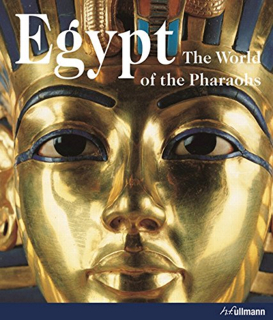
496. Egypt: The World Of The Pharaohs – Matthias Seidel and Regin SchulzThis 480 page book is a treasure trove for understanding ancient egypt – even though the product description text claims “over 500 pages”. It covers everything from architecture, sculpture, and painting to everyday life, statecraft, society, and – of course – religion. The paperback is way out of reach – one new copy at $94.66 and one used at $79.73 – but the hardcover still has copies at reasonable prices: Amazon $20.39 (only 11 in stock), third-party 36 new starting at $15.55 (slightly more expensive than Amazon with P&H) and 14 used starting at $16.54 (slightly more expensive again). |
|||
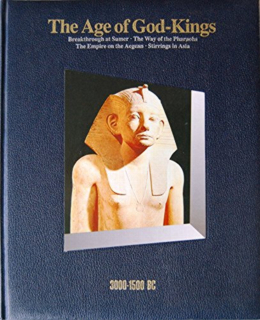
497. The Age Of God-Kings – Time-LifeThe Age Of The God-Kings – volume I of the Time-Life History of The World – a great reference for Egyptian stuff. Also covers Crete, Mesopotamia, the Indus Valley, and early China as bonuses. |
|||
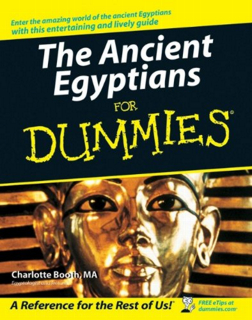
498. The Ancient Egyptians For Dummies – Charlotte BoothAncient Egypt has a fascination that can be hard to explain, but that is undeniable, and is a major resource for Pulp GMs to tap into. But most modern people will think of it as a whole, indivisible unit, building pyramids from start to finish, and worshiping a strange pantheon of deities throughout, just as many people think dinosaurs and stone-age humans coincided. Just as Walking With Dinosaurs should have corrected that misinterpretation (which might be entirely correct in a pulp world if you just replace “stone-age” with “modern-day” and look in the right place), this book should correct a lot of misinterpretations about Ancient Egypt and its cultures. 354 pages; Kindle $15.04, Paperback $16.69 (Amazon, only 5 copies left), from $12.69 (19 New), $1.144 (27 Used). |
|||
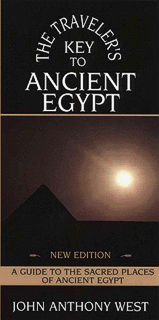
499. The Traveler’s Key to Ancient Egypt: A Guide to Sacred Places – John Anthony West“This book explains he deeper meaning and spiritual significance of Egypt’s art and architecture. This revised and updated edition includes ‘startling evidence’ for the need to re-date the sphinx. Which kinda makes him sound like He’s out with the pixies, but the customer comments suggest otherwise. The missing phrase is, “that the ancient Egyptians attached to this art and architecture. The page-count is 512 and it’s available in both hardcover and softcover. New copies in either form are expensive – $68.57 and $43.22, respectively; but used copies of th paperback start at $4.08 and there are 34 of them available. |
|||
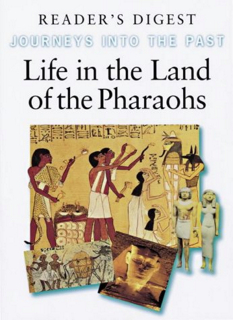
500. Life In The Land Of The PharaohsThis is part of the Journeys Into The Past series by Reader’s Digest. It is more about the way things were than about the way they are, but that can be incredibly useful in working out what would be where when tombs etc are discovered. Which doesn’t happen every other week, even in a pulp campaign, but does occasionally occur – or should. Bizarrely, our reference copy is bound back-to-front. |
|||
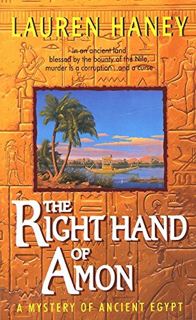
501. The Right Hand Of Amon – Lauren HaneyThis is a most unusual recommendation in light of our terms of reference, but Mike has convinced us. The Right Hand Of Amon is historical crime-fiction set in ancient Egypt and, according to him, does “an unbelievably good job of bringing the time to life on the page”. He also wanted to mention the sequel, A Face Turned Backward, which – from the back-cover – sounds even better, but which he found almost unreadable, especially in comparison to the first – but that may have been because he could never just sit and read for an hour or so to get into it; by the time he got to each piece of the story, he had forgotten who was who. He does think that the gap in between reading the first and the second might also be part of the problem, so your experience might be completely different. There have been many more sequels since, but he hasn’t read any of them. But this is on top of his go-to list for Ancient Egyptian flavor text. 15 new from $3.47, 47 used from $0.01 http://amzn.to/2e5zLHr and there are more copies in other formats. |
|||
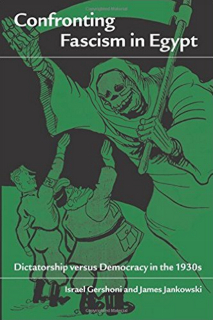
502. Confronting Fascism in Egypt: Dictatorship vs Democracy in the 1930s – Israel Gershoni and James Jankowski“Offers a new reading of the political and intellectual culture of Egypt during the inter-war era. Though scholarship has commonly emphasized Arab political and military support of Axis powers, this work reveals that the shapers of Egyptian public opinion were largely unreceptive to fascism, openly rejecting totalitarian ideas and practices, Nazi racism, and Italy’s and Germany’s expansionist and imperialist agendas. The majority (although not all) of Egyptian voices supported liberal democracy against the fascist challenge, and most Egyptians sought to improve and reform, rather than to replace and destroy, the existing constitutional and parliamentary system.” Is this rewriting history? Or is it discovering the truth? Reality may decide for itself, one way or another; when it comes to the Pulp world, the GM has the call. Before being able to make his ruling, though, he needs to know the story as presented in this interpretation of historic record – and can then decide whether his campaign world is better off with a Pro-fascist Egypt, or an Egypt trying to steer a safe course through troubled diplomatic waters – perhaps while dealing with other, more dangerous, threats from the past… |
|||
 |
|||
Books about The AtlanticThe Atlantic Ocean is a turbulent body of water that contrasts starkly with the relatively placid Mediterranean. Consequently, the Atlantic has always fascinated artists and poets, and challenged explorers and fishermen. Constantly changing shape and size, always traveling, pulled by tides and pushed by storms, powerful and threatening. Strangely, there don’t seem to be any books about it specifically. |
|||

503. Lightships: Floating Lighthouses of the Mid-Atlantic – Wayne KirklinWe had a bunch of books listed here, when the list was in draft form, about Lighthouses. Ultimately, none of them were deemed important enough, in a pulp context, to be included. But at the bottom of that list was this book, about something none of us – not being from that part of the world – had known about, and it seemed to have potential simply because of that quality of eyebrow-raising “I never knew that”, and because the isolation factor that is a normal element to lighthouse stories is doubled and squared when you’re talking about a lightship. So, if you don’t know, what is a Lightship? Before radar, depth-finders, and GPS, they were vessels that lingered off-shore in perilous waters to warn other vessels of the danger. A Lighthouse actually on the sea. They stayed out there in all weather, and from 1820 to 1985, these 85 ships protected the mid-Atlantic seacoast of the United States, undoubtedly saving thousands of lives and millions of dollars worth of cargo from a disastrous end somewhere between New York Harbor and the infamous Cape Fear in North Carolina. This book tells the individual stories of each of those eighty-five vessels, a forgotten but vital element of maritime history that was in full flower during the Pulp Period. 128 pages, Kindle and Paperback, considerably cheaper through Amazon’s third-party vendors. |
|||
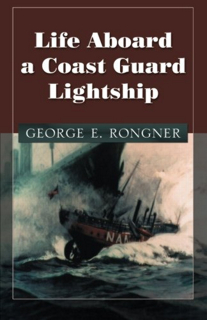
504. Life Aboard a Coast Guard Lightship – Rongner E GeorgeThe value of this book should be obvious after the introduction to the previous one. |
|||
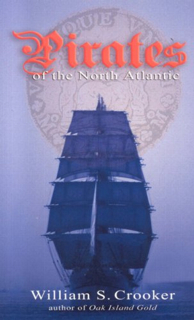
505. Pirates of the North AtlanticIn the 17th, 18th, and 19th century, the Northern Atlantic was an extremely attractive location for piracy. This book collects stories of acts of greed and murder tied mostly to the frigid waters of the North Atlantic. There has been some romanticization of the stories, some myths perpetuated – but for pulp purposes, in which the legacies of some of these acts might form part of a plotline, we’re fine with that. 128 pages, Kindle and paperback. |
|||
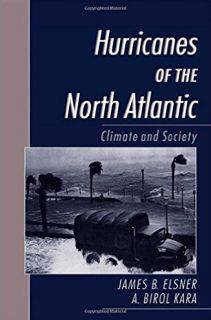
506. Hurricanes of the North Atlantic: Climate and SocietyMike will never forget the description of the North Atlantic in the Clive Cussler novel “Raise The Titanic” (ignore the movie, which is nowhere near as good). He insisted that this list had to contain some sort of reference to the storms and climate for which the winter Ocean is notorious, but a protracted search found only this book (and one other, below) to reference the meteorology of the Atlantic – or, at least, that did so within our tolerance parameters. This book is a comprehensive analysis of these storms, their meteorology, and their impacts on both human and property scales, as of the end of the 20th century. 512 pages from Oxford University Press, new copies cost $35.80 or more, 25 used copies are available from $12.01.
|
|||
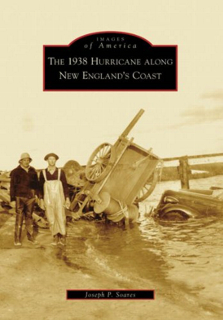
507. The 1938 Hurricane Along New England’s CoastHe also came across this book documenting such a storm in the late Pulp Period that struck the coast of New England, one of the most potent weather systems to affect the region since records began. There are a series of similar books, but this is the only one that Mike spotted relating to the Pulp Era – he probably missed some, he admits. Paperback only, 29 new from $12.43, 17 used from $7.98. |
|||
Books About Shipwrecks
|
|||
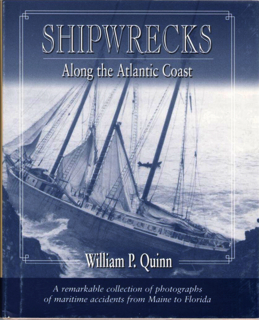
508. Shipwrecks Along the Atlantic Coast: A Remarkable Collection Of Photographs of Maritime Accidents from Maine to Florida – William QuinnA collection of Atlantic Coast shipwrecks featuring more than 300 photos ranging from the earliest days of photography to modern days. 1988 edition (232 pages, hardcover): 1 collectible copy at $16, 8 New from $17.94, 32 used from $1.79. http://amzn.to/2ecAY1q 2004 edition (pictured, 240 pages, reissued hardcover with slightly smaller page dimensions): 3 collectible at $18, 7 new from $42.37, 21 used from $5.12. http://amzn.to/2dVwHQq |
|||
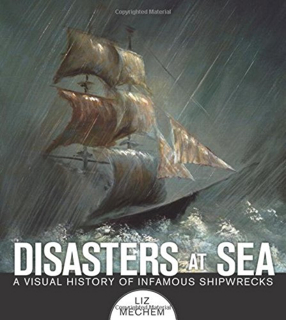
509. Disasters at Sea: A Visual History of Infamous Shipwrecks – Liz MechemMore than sixty accounts of the most notorious shipwrecks of history, accompanied by maps and details both factual and speculative. 192 pages, Kindle and paperback. |
|||
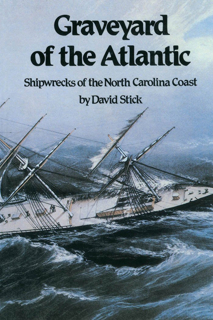
510. Graveyard of the Atlantic: Shipwrecks of the North Carolina Coast – David StickA completely factual account of dramatic shipwrecks, heroic rescues, and violent adventures off the Outer Banks of North Carolina. There is a reason why the place is known as Cape Fear… 287 pages, published by the University of North Carolina Press, reprint edition. Kindle and paperback. |
|||
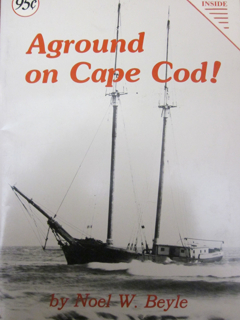
511. Aground on Cape Cod!: A treasure-trove of beachcomber booty & sunken ships buried beneath the shores of olde Cape Cod, ‘The graveyard of the Atlantic’ – Noel W BeyleThat rather lengthy subtitle is almost all that is known about this 48-page book. Paperback, 10 used copies available, so it normally wouldn’t make our criteria, but the pulp potential of a shipwreck is too great to ignore. |
|||
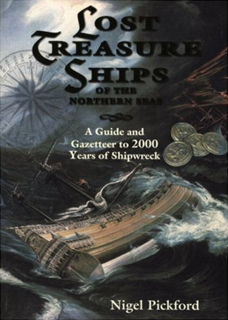
512. Lost Treasure Ships of the Northern Seas: A Guide and Gazetteer to 2000 Years of ShipwrecksUnlike most of the books listed so far, which have been America-focused, this book deals with the Northern European side of the Atlantic (actually the North Sea and the Baltic, so this is a bit of a ringer), where hundreds of wrecks lie in relatively shallow waters. A significant portion can be considered high-value either historically or financial reward, but few have ever been precisely located – the term ‘few’ being a relative one, of course. This book lists 500 of them, giving precise details of vessel, voyage, cargo, and current state of knowledge. An introductory section provides twenty case studies chosen to “illustrate the range of problems – and rewards – likely to be encountered by anyone diving on the sites”. “Heavily Illustrated”. 224 pages, hardcover, from $3.43. |
|||
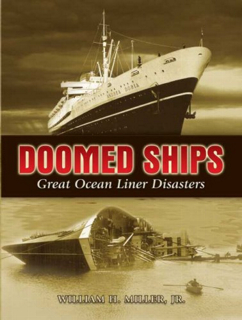
513. Doomed Ships: Great Ocean Liner Disasters – William H Miller JrNaval historian William H. Miller, Jr. recounts the dramatic stories behind a host of ill-fated passenger ships, going beyond newspaper headlines and formal inquiries to offer firsthand accounts of heroic rescues, daring escapes, and tragic losses. Starting with the torpedoing of the Lusitania in 1915 and concluding in 2005 with the capsize of the Oriana during a Chinese typhoon, these are the world’s most ill-starred vessels: The Titanic has been deliberately excluded because it is so well documented elsewhere. “Almost 200 photographs, many from private collections” provide graphic punctuation to this combination of personal anecdote and historical record. |
|||
Books About Ghost Ships
|
|||
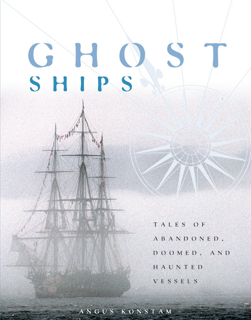
514. Ghost Ships: Tales of Abandoned, Doomed, and Haunted Vessels – Dr Angus KonstamAn anthology of the best true-life accounts of vessels that for one reason or another, never got to where they were going. 144 pages. Amazon has multiple listings for this book but only this one had the copies and price to meet our standards – one optimist wants over $1000 for his copy! Paperback: 7 new from $64.60, 25 used from $3.86. |
|||
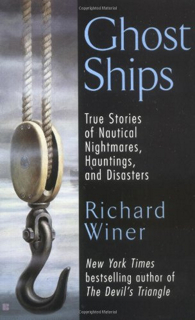
515. Ghost Ships: True Stories of Nautical Nightmares, Hauntings, and Disasters – Richard WinerThere are also multiple listings for this book, with two priced acceptably within our standards. The author also appears in our Bermuda Triangle section, a history that led some reviewers to question the authenticity of this collection. Unlike the Konstam, this collection actually tries to be scary. It is likely that accounts have been dressed up somewhat (and some may be entirely fictional despite the subtitle), but that can only make them more useful to the Pulp GM because they would require less work to adapt. 288 pages, Mass-market paperback. First Listing: 7 new from $57.43, 31 used from 1 cent. http://amzn.to/2egJkQj Second Listing: 5 new from $124.18, 7 used from $3.86. http://amzn.to/2egK4Fg |
|||

516. Haunted Ships of the North Atlantic – Robert Ellis CahillMore of the same in this 88-page book. The only customer review is a pertinent warning: “The book is easy to read and a short read. But I’m not sure of the veracity of some of these stories. “The author relates the (since disproven) story of the wreck of the ‘Palatine’ on Block Island, and how the islanders robbed and murdered the survivors. The ship that wrecked on Block Island was actually the ‘Princess Augusta’ carrying people from a part of Germany called something like ‘Palatine’. The islanders actually helped the survivors and for many years have been trying to set the record straight. “He also relates the (also disproven) story of crewman Frank ‘Lucky’ Towers. Towers supposedly survived the ‘Titanic’, the ‘Empress of Ireland’, and the ‘Lusitania’. There is no evidence of such a person. I don’t know where the story came from.” – F S Frederick. |
|||
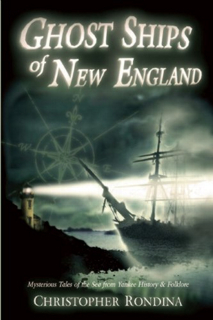
517. Ghost Ships of New England – Christopher Rondina“A ghostly schooner glides through the mist off the coast of Maine. A Connecticut lighthouse keeper continues to guide ships to safe harbor nearly a century after his death. Pirate ghosts wander the Rhode Island shoreline in search of salvation. These are only a few of the strange but true stories of New England’s phantom ships and the spectral seafarers who haunt the shadowy cliffs and moonlit coves of the Northeast.” Well, they are allegedly true in our book, but that hasn’t stopped us from using such material in our Pulp Campaign and it won’t keep us from listing this book. 174 page paperback; 1 collectible at $15.80, 16 new from $7 and 17 used from $4.34. |
|||
|
‘Buried Treasure’ will be found on the ‘Games, Odds & Sods’ Shelf. |
|||
Books About The Bermuda Triangle
|
|||
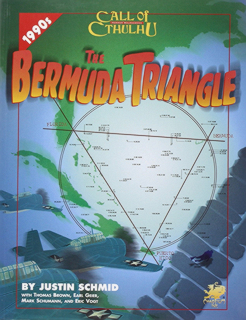
518. The Bermuda Triangle (Call Of Cthulhu Sourcebook) – Justin SchmidHas street maps of some of the major cities of the region, worth it for those if nothing else. |
|||
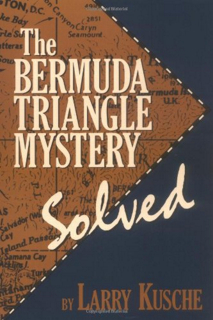
519. The Bermuda Triangle Mystery Solved – Larry KuscheIn 1972, Larry Kusche, a reference librarian who was fascinated by the Bermuda Triangle mystery, decided to collect all the first-hand information that he could find from the original records. Obtaining information from sources as diverse as the US Coast Guard, US Air Force, and Lloyd’s Of London, and obtaining microfilm copies of the newspapers containing the original reports of the various incidents. By the time his research was complete, he found that every incident could be explained if not dismissed completely, and concluded that the only reason that this had not been discovered sooner was that hyperbole, superstition, and exaggeration had become a self-propelling cultural phenomenon that viewed every event through a distorted perspective that reinforced the myth. This book pretty much debunks the entire concept of the Bermuda Triangle, reducing it to the status of myth. We actually find his explanations slightly too pat, trying too hard to be complete – the North Atlantic in winter has more than enough extreme weather to cause a few maritime losses, and the absence of them seems improbable. If you decide that in your campaign the Bermuda Triangle is a myth, this is the reference book that you need to devour. If you decide otherwise, this is the book that you need to debunk. Either way, this is a book that you need. |
|||
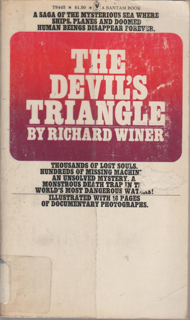
520. The Devil’s Triangle – Richard WinerDespite the lurid title, this is a fairly balanced examination of the Bermuda Triangle that neither denies the strangeness of some of the reported events in that body of water nor resorts to an occult/weirdness explanation as a first resort. Unfortunately, according to other reviewers, the book is riddled with historical inaccuracies. Perhaps most interesting and illuminating are the near misses, events in which only a slight turn of luck to the worse would have been need to add to the roster of disappearances. Better still, the author is himself a sailor familiar with that part of the world and gives great descriptions of the appearances of various weather and maritime phenomena. There is also a sequel but there weren’t enough copies available for that to be listed; you will find it in the honorable mentions. |
|||

521. From The Devil’s Triangle to the Devil’s Jaw – Richard WinerThe sequel to “The Devil’s Triangle 2” which is the sequel to “The Devil’s Triangle.” Disturbingly, this book has exactly the same reader’s comments as those for “The Devil’s Triangle”- verbatim. That, coupled with the fact that clicking on the “see all editions” for “The Devil’s Triangle 2” takes you to copies of “The Devil’s Triangle” leaves all information and reviews of this book suspect, at the very least. According to the front cover, this book provides “New startling evidence of mysterious disappearances around the world – phantom ships, bizarre sinkings, lost souls, [and] unexplained disasters” being “published for the first time”. That, plus a review on Goodreads, which describes it as, “A bunch of maritime accidents strung together with unsupported speculation regarding supernatural, paranormal, extraterrestrial and inter-dimensional influences. Silly if taken at face value, but a degree of interest if considered as a kind of modern folklore” tends to reinforce those opinions which suggest a less than objective positioning on the subject – and a trend toward even more extreme perspective with subsequent books. This book includes many events outside the Bermuda Triangle. |
|||
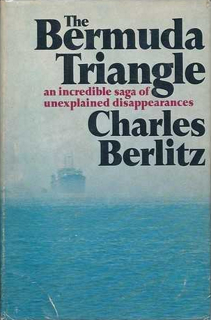
522. The Bermuda Triangle – Charles BerlitzFor an awful lot of people, this is the first book that they ever read about the Bermuda Triangle. A lot of reviews are extremely critical – “If you are a totally uncritical thinker… you’ll love this book”. There are also reports of factual discrepancies and suggestions that these are deliberate acts by Berlitz – or by the people Berlitz is lifting his information from, to offer another criticism we’ve heard – to make the disappearances tell a better story. All that said, it’s fine to revise history in order to create a better campaign – so if you decide to make the Triangle real, this book might just be your bible, or one of them, anyway. Available in cheap copies in two formats – hardcover http://amzn.to/2ctkkZ3 and paperback http://amzn.to/2c8n7J0, both starting at just one cent. Postage and Handling will probably be higher for the hardcover, but you might feel it’s worth it for the more durable volume. |
|||

523. Limbo Of The Lost – John Wallace SpencerThere are two editions of this book; the second edition, which is the one we have linked to, is “revised and expanded with 16 pages of illustrations” according to the title on Amazon.. This suffers from many of the problems ascribed to Berlitz’ book (above); in fact, it mentions so many things in passing and without depth of analysis that it is arguably more superficial, and even plays faster-and-looser with the facts than that. But if you’ve ever heard the theory that there’s a portal into some sort of other dimension that sucks up ships and aircraft when the weather is foul in the Triangle, this is the book that popularized the notion (even generated it, according to some). |
|||
 |
|||
Books about Antarctica
|
|||
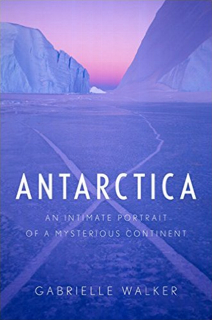
524 Antarctica: An Intimate Portrait of a Mysterious Continent – Gabrielle Walker“Antarctica is the most alien place on the planet, the only part of the earth where humans could never survive unaided. Out of our fascination with it have come many books, most of which focus on only one aspect of its unique strangeness. None has managed to capture the whole story – until now.” This book has rave reviews from Booklist, the New York Review Of Books, Nature, and many more. 416 page Hardcover; 1 collectible at $12, 41 new from $7.71, and 38 used from one cent. |
|||
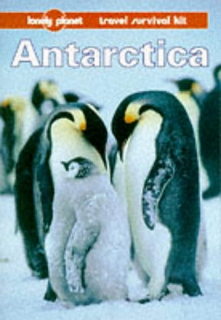
525. Lonely Planet Antarctica: A Lonely Planet Travel Survival KitYes, my friend, there are travel guides to Antarctica, and have been for a surprisingly long time. The product description sounds like a minor variation on a canned summary, which assumes a macabre new significance when you realize where it’s talking about: “provides information necessary to visitors on all budgets, including advice on getting there, accommodation, local cuisine, places to visit, language tips, and health and safety.” 1996 edition: 336 page paperback by Jeff Rubin (Pictured); 1 collectible at $12.99, 7 new from $1.99, 31 used from one cent. http://amzn.to/2drsalG 2000 edition: 375 page paperback by Jeff Rubin: 11 new from $1.99, 35 used from one cent. http://amzn.to/2eDHr4r 2012 edition: 224 page paperback by Alexis Averbuck: Kindle $15.99, 52 new from $13.03, 30 used from $10.84. http://amzn.to/2ecNSMZ Of these, we recommend the 2000 edition as the best; when they run out, the 1996 edition because it’s the cheaper of the alternatives. Unfortunately, it also has the least attractive cover. |
|||
 |
|||
Books about The Arctic
|
|||

526. The Arctic Guide: Wildlife of the Far North – Sharon ChesterThis 544-page book “covers the complete spectrum of wildlife–more than 800 species of plants, fishes, butterflies, birds, and mammals–that inhabit the Arctic’s polar deserts, tundra, taiga, sea ice, and oceans. Published by Princeton University Press, with a load of color illustrations and a full-color population distribution map to show where different creatures can be located. Kindle $15.28, Paperback 53 New from $11.99 20 Used from $18.49, there is a hardcover but prices are around the $70+ mark, so forget it. |
|||
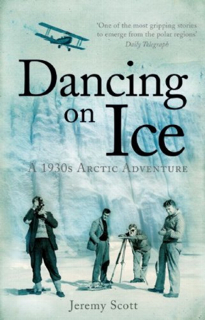
527. Dancing On Ice: A 1930s Arctic Adventure – Jeremy ScottThis is useful beyond the story of the expedition itself; it “douses the reader with lush descriptions of the jaunty era that produced these men” according to the Star Tribune of Minneapolis. This book tells the tale of one of the most harebrained adventures imaginable: 14 young men with barely any experience between them decide to travel to the Arctic and stay there for a year. Led by Gino Watkins, they “charted the east coast of Greenland, discovered a mountain range, ate polar bears, and taught the Inuit to dance the Charleston.” But there was an equal measure of tragedy and hardship to match the adventure and achievements. Paperback: 1 collectible at $34, 6 new from $39, and 19 used from $0.98. Hardcover: 1 collectible at $79, 9 new from $39, 17 used from $0.49. |
|||
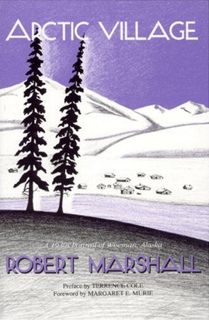
528. Arctic Village: A 1930s Portrait of Wiseman, Alaska – Robert MarshallWritten by one of America’s foremost conservationists of the era, this is an account of the people of the North. First published more than 75 years ago, the book is still a favorite among old-time Alaskans. Marshall is careful in his descriptions of the characters that he met in the town of Wiseman. 428 pages. Forget the hardcover version, they cost too much. There are 20 new copies of the paperback and 24 used, at $13.66 and $3.97, respectively. |
|||
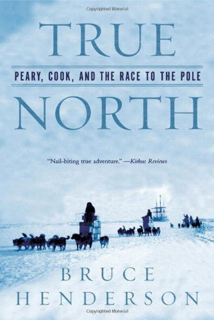
529. True North: Peary, Cook, and the Race To The Pole – Bruce HendersonWho got to the North Pole first? According to a lot of the history books, it was Peary – but he had a rival, who claimed to have beaten him there, and there was evidence that Peary had never achieved the feat he claimed. Even today, the controversy is unresolved, though opinion is slowly swinging toward supporting Cook’s claim. This book examines both claims without prejudice and tells the story of the subsequent dispute. Amazon have multiple listings for this book and the prices vary wildly. The one below is the only one that came closest to our criteria: 8 new copies $12.58 and 7 used from $10.65. |
|||
 |
|||
Books about The Hollow Earths
|
|||
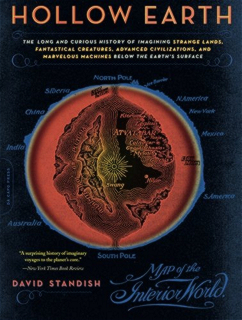
530. Hollow Earth – David StandishAn overview volume and excellent starting point. |
|||
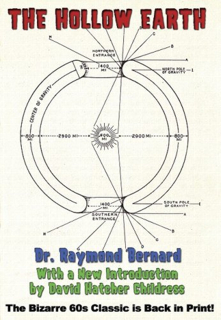
531 The Hollow Earth – Dr Raymond BernardAnother and somewhat flakier general volume, not quite as comprehensive as the Standish book. |
|||
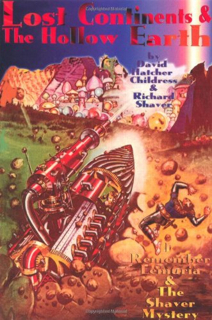
532. Lost Continents and The Hollow Earth – David Hatcher Childress & Richard ShaverologyLargely a reprint of Shaver’s “I Remember Lemuria”, which is useful if you can’t get the original. Also takes information from “Subterranean Worlds” by Walter Kafton-Minkel (the last hundred pages) and rephrases it (also useful if you can’t get the original. We looked at including that volume in our recommendations but copies are just too expensive). Also has an excellent bibliography for further research. |
|||

533. Finding Lost Atlantis Inside The Hollow Earth – Brinsley Le Poer TrenchA former member of Britain’s House Of Lords combines Hollow Earth, UFO, and Atlantis lore and legend. One of the more ‘out-there’ books on the subject – not necessarily a bad thing in this context! |
|||
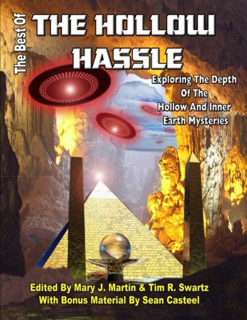
534. The Best Of The Hollow Hassle – edited by Mary J Martins & Tim R SchwartzFrom Amazon’s description: There are two sets of “unorthodox” beliefs about the interior of our planet – the theory that the earth may be “hollow” and possibly inhabited, and the second that a system of caverns exists beneath our feet that are controlled by both good and evil entities (thus the concept of a hell down below). For over 10 years the author put out a widely circulated newsletter covering this immensely popular subject. This book compiles articles on the Hollow Earth from that conspiracy magazine, including letters to the editor. |
|||
 |
|||
Books about Lost Cities & Civilizations
|
|||
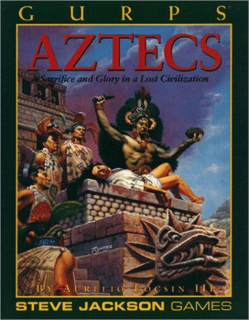
535. Gurps Aztecs: Sacrifice and Glory in a Lost Civilization – Aurelio Locsin III (Steve Jackson Games)The Aztecs were totally alien to the lives most of us know, stranger than any fantasy land. Their empire stretched from Ocean to Ocean; they worshiped hundreds of mostly unpronounceable Gods, kept elaborate calenders and built gigantic stepped pyramids that still stand as testament to their might. Their armies were relentless and seemed unstoppable. And then a few hundred Spanish invaders toppled the entire society. This game supplement permits you to step into the Aztec culture, or its remains, as your adventure demands. |
|||
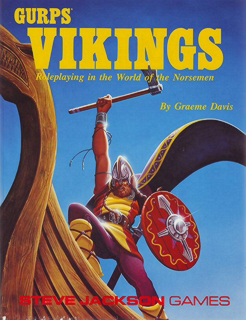
536. Gurps Vikings 1st edition – Graeme DavisThis setting may predate the pulp era but it is easily transferable and full of pulp-era possibilities. Appears to have information not present in the 2nd edition and vice-versa. |
|||
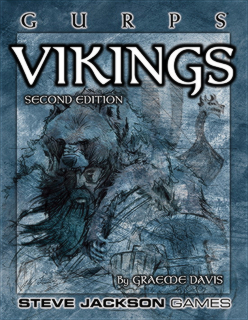
537. Gurps Vikings 2nd ed – Graeme DavisSee comments above. |
|||
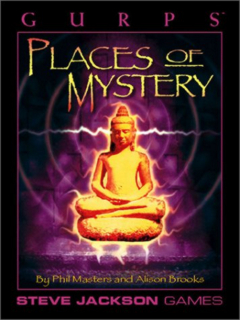
538. Gurps Places of Mystery – Phil Masters & Alison BrooksDescriptions of lost cities and many other locations suitable for high adventure. |
|||
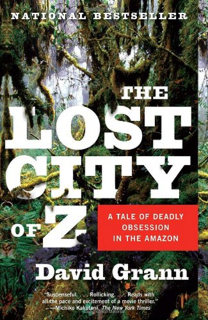
539. The Lost City of Z – David GrannTells the story of the author’s search for the lost 1925 expedition of Percy Fawcett and what they were searching for in the South American jungles. |
|||
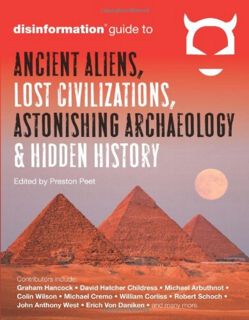
540. Disinformation Guide to Ancient Aliens, Lost Civilizations, Astonishing Archeology, and Hidden History – edited by Preston PeetDiscovered during the research for this article, this omnibus introduction to the outer fringes of archeology was too tantalizing to ignore. None of us have read it, but the list of contributors is a who’s who of the ‘field’. |
|||
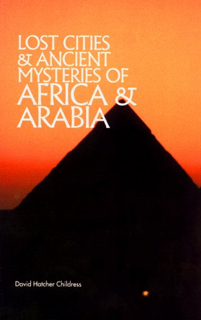
541. Lost Cities & Ancient Mysteries of Africa and Arabia – David Hatcher ChildressChildress, sometimes described as “The Real Life Indiana Jones”, goes in search of lost cities and civilizations in this series. This volume deals with the Empty Quarter in Arabia, King Soloman’s Mines, ‘Atlantean’ Ruins in Egypt and the Kalahari, the Ark Of The Covenant, and more. Parts of Childress’ writing is out-with-the-pixies fantastic, but there’s room for that in a Pulp Campaign – and the balance is invaluable. |
|||
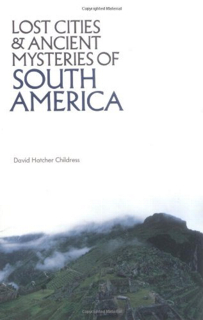
542. Lost Cities & Ancient Mysteries of South America – David Hatcher ChildressThis volume continues the series, dealing with the Jungles, Deserts and Mountains of South America. |
|||
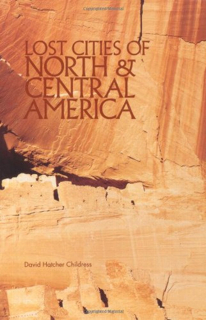
543. Lost Cities of North & Central America – David Hatcher ChildressLost Mayan cities and books of gold and much more. |
|||
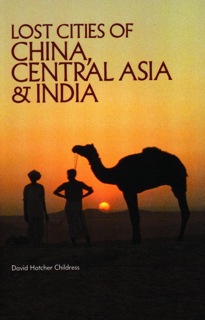
544. Lost Cities of China, Central Asia, and India – David Hatcher ChildressThe Gobi desert, lost city of Rama, forgotten monasteries, Tibet, Mongolia, and more. http://amzn.to/2apHUTf Also available is what appears to be an older (and much shorter) edition subtitled ‘a traveler’s guide’. |
|||
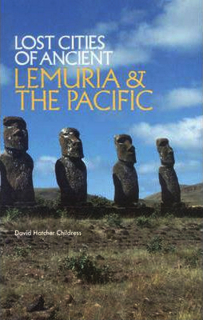
545. Lost Cities of Ancient Lemuria & The Pacific – David Hatcher ChildressStrains credulity a little more than most of Childress’ books but in a pulp world, who knows? |
|||
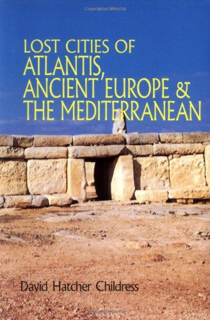
546. Lost Cities of Atlantis, Ancient Europe, and The Mediterranean – David Hatcher ChildressFrom Ireland to Turkey, Morocco to Eastern Europe, Childress explores it all. |
|||
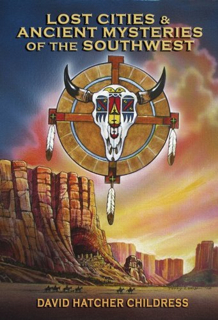
547. Lost Cities & Ancient Mysteries of the Southwest – David Hatcher ChildressA volume that even our Lost Cities collector didn’t know about. The lost mines of the Aztecs, the strange lights of Marfa, and much much more. |
|||
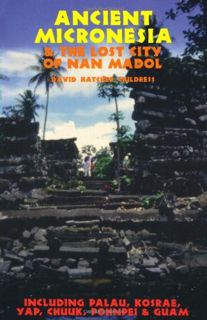
548. Ancient Micronesia and the Lost City of Nan Madal – David Hatcher ChildressAnother tome which escaped the attention of our Childress buff. Includes Palau, Kosrae, Yap, Chuurk, Ponnpei, and Guam – and if you have only heard of half of those, you aren’t alone. This book doesn’t quite meet our standards of price and availability but is included to be comprehensive. |
|||
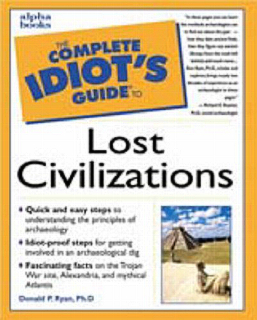
549. The Complete Idiot’s Guide To Lost Civilizations – Donald P RyanThe applicability is self-evident, really. Likely to be only the broadest overview. About 270 pages appear to be entirely factual, and about 38 pages discuss subjects as rooted in scientific plausibility as Alice In Wonderland. Both can be equally useful – just in different ways. |
|||

|
|||
Documentaries |
|||
Documentaries about Lost Civilizations
|
|||
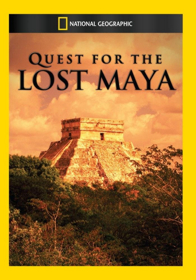
550. Quest For The Lost MayaThis National Geographic documentary is a little hard to find but well worth the effort. To quote from Amazon’s editorial review: “In the past decade, researchers working in Mexico’s Yucatan Peninsula have made a series of startling discoveries, revealing a gaping hole in our understanding of the Maya… could it be that what we thought we knew has suddenly turned out to be just half the story?” This documentary completely transformed our understanding of the Maya and the role that a lost tribe of them could play in the Adventurer’s Club campaign.
|
|||

|
|||
Books about Atlantis & Lemuria
|
|||
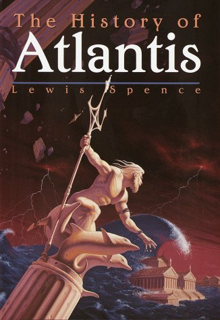
551. The History Of Atlantis – Lewis SpenceOriginally published in 1926, full of pseudo-scholarship but a fascinating extrapolation on life in Atlantis. For the first time while researching this series, it was noticed that the cover was different in all three countries – the image shown is the Amazon US version, the British version features more Greek-style architecture and pastel colors, while the Canadian version has deep blue waves lapping on a beach. In addition to the physical book, Amazon US and Canada list a Kindle edition, but (somewhat curiously), Amazon UK does not. |
|||

552. Atlantis the Antediluvian World – Ignatius DonnellyYou may also want to consider this earlier work, which is the start of the modern Atlantean Mythos. This is neither our first or second preference in Atlantis reference, but it is one that comes close to our availability/price standards. “Lost Continents” by DeCamp synopsizes this book and adds considerable new material, but we were unable to locate any copies of it. Our second choice was GURPS Atlantis, but there are nowhere near enough affordable copies of that, either. |
|||
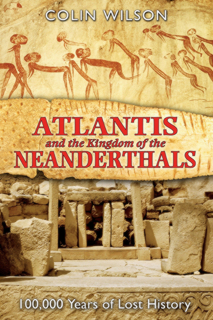
553. Atlantis and the Kingdom Of The Neanderthals – Colin WilsonWith our two most-preferred options off the table, we went looking for alternatives and found this. It’s completely out there in terms of scientific plausibility but that doesn’t matter too much in terms of a pulp campaign. If you can’t get half-a-dozen adventures out of this book, you’re not trying hard enough (we got about that many ideas just from the Amazon review). |
|||
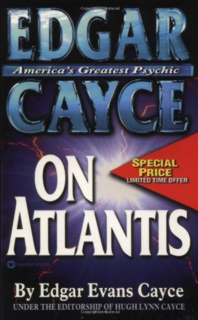
554. Edgar Cayce On Atlantis – Edgar CayceIf you go with “Kingdom Of The Neanderthals”, you may as well extend the content with the technology offered in this even more out-with-the-pixies volume to have a better idea of what the Atlanteans in a Pulp World might be able to do. |
|||
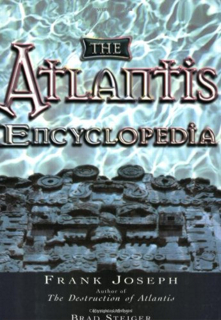
555. The Atlantis Encyclopedia – Frank JosephVery short pieces on the myths, legends, and literature from all over the world that may pertain to Atlantis or Lemuria. Notable in that it takes a dispassionate perspective over the existence or otherwise of the reputed lost civilizations, rather than attempting to convince the reader. In addition to the physical book, Kindle editions are also available but are relatively expensive. |
|||
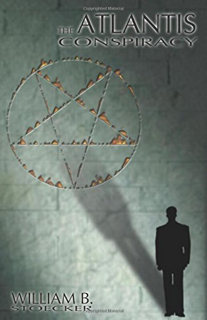
556. The Atlantis Conspiracy – William B StoeckerTries to sell the reader on the idea that the world is being controlled by a 12,000-year-old conspiracy that originated in ancient Atlantis. Very well organized, and presented with greater clarity than is often the case in such “out-with-the-pixies” material, this connects ideas as diverse as UFO Abductions, the Kennedy Assassination, Lost Civilizations (obviously) and the Paranormal into one grand theory. That level of organization is both a blessing and a curse: it makes it easier to locate and use snippets, but makes it harder to separate and isolate those parts that the pulp GM might find useful. |
|||
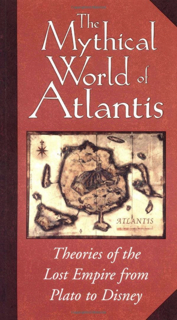
557. The Mythical World Of Atlantis Theories Of The Lost Empire from Plato to Disney – Jeff Kurtti and Preston B WhitmoreWe haven’t actually read this book yet, so take this recommendation with a grain of salt. It looks like an Interesting overview but makes a lot of extreme claims. Has an interesting bibliography that would make a great starting point for anyone who wanted to get deeply into Atlantis mythology for their campaigns. |
|||
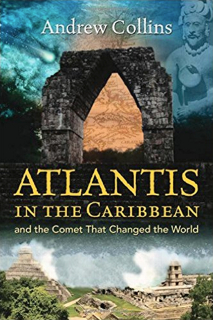
558. Atlantis In The Caribbean – Andrew CollinsThe most recent entrant in the subject, this was published only two weeks ago as this article goes online, so we certainly haven’t read it yet. “An in-depth investigation of the mounting evidence that Atlantis was located in the Bahamas and Caribbean, near Cuba in particular. Explains how Atlantis was destroyed by a comet, the same comet that formed the mysterious Carolina Bays; Reveals evidence of complex urban ruins off the coasts of Cuba and the Bahamas; Shows how pre-Columbian mariners visited the Caribbean and brought back stories of Atlantis’ destruction; and Compares Plato’s account with ancient legends from the indigenous people of North and South America, such as the Maya, the Quiché, and the Yuchi of Oklahoma.” |
|||
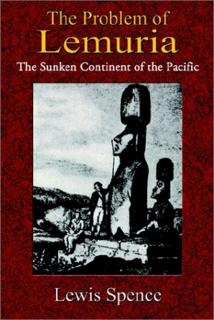
559. The Problem Of Lemuria – Lewis SpencerA detailed attempt to make the case for the existence of a “lost continent” in the pacific, this volume actually has an index (unlike most books in this area). Note that only the copies available from Amazon US come close to being reasonable in price, and copies range from limited to extremely few. Amazon US: |
|||
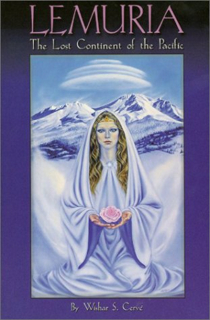
560. Lemuria The Lost Continent Of The Pacific – Wishar S CerveA Rosicrucian view of Lemuria, including speculation on possible colonies in North America. (If you don’t know what is meant by “Rosicrucian”, look at the wikipedia page on Rosicrucianism). There are two editions of this book – one with a very plain cover from 1982, and a decidedly more modern one from 1997 (pictured). Of the two, only the older ones are what we consider to be approaching reasonable in price, the new ones are both harder to find and up to seven times the price. So, despite the cover, we’re only linking to the older edition. |
|||

561. Shaverology – Richard TorontoA series of anecdotes about Richard Shaver and Ray Palmer by people who knew them. |
|||
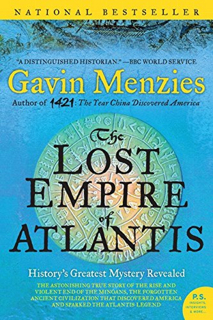
562. The Lost Empire Of Atlantis: History’s Greatest Mystery Revealed – Gavin MenziesLast on our list in this section and the book that places the greatest strain on credulity. For example, Menzies equates Atlantis with Crete/Santorini etc, but has them mining copper in North America. Amazon lists the paperback and hardcover separately, and it’s difficult to predict which will be the best quality for the price, so we’re providing links to both. Paperback & Kindle: http://amzn.to/2aqZUPm Hardcover: http://amzn.to/29X4Mfs |
|||
| See also our Hollow Earth section and several of the Childress books listed earlier in this section. | |||

|
|||
Books about Picturesque PlacesSpectacular places go hand in hand with spectacular action and drama. These collections celebrate the natural (and sometimes man-man) wonder of the world in which our characters adventure. Expect additional P&H on all these books. |
|||
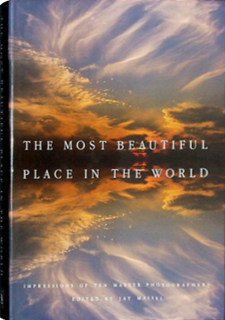
563. Most Beautiful Place In The World – Jay NaiseiTen photographers. 254 pages of full-page and double-page photographs. 10.5 x 13 inches. Hardcover, 1 collectible at $9.85, 8 new from $14.39, 45 used from one cent. |
|||
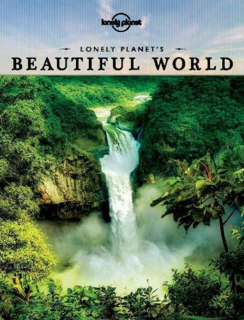
564. Lonely Planet’s Beautiful WorldThree hundred photographs of the world’s most captivating spectacles. 10.4 x 14 inches. 256 pages. Hardcover; Kindle $12.49, 67 New from $20.59, 33 Used from $15.77 http://amzn.to/2eshipY Paperback: 64 New from $15.75, 31 Used from 9.73 http://amzn.to/2ehjNXj |
|||
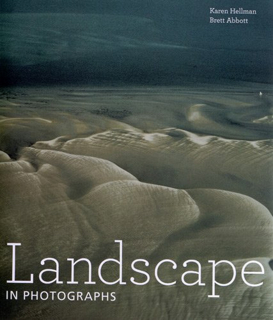
565. Landscape In Photographs – Karen Hellman and Brett AbbottLandscapes used to be just background. As urban landscapes closed in, the natural landscape developed an appeal all of its own. This collection illustrates a range of photographic works held by the J Paul Getty Museum; it was designed to accompany an exhibition at the Getty Center in 2012. 7.2 x 8.6 inches, 112 pages, Hardcover. 22 New from $12.24, 16 Used from $8.76. |
|||

566. Discovering the Wonders of Our World: A Guide to Nature’s Scenic MarvelsThere is a similar Reader’s Digest book that was the entire inspiration for this section, but there are only three quite-expensive copies of that book available. Despite an almost complete lack of information on the content, we are recommending this book on the basis of that other volume. 10.9 x 8.6 inches, no page count but it weighs 4.3 pounds so we estimate 300+ pages, Hardcover. 10 New from 2.50, 68 Used from one cent. Additional copies available here: 9 New from $19.42, 10 used from $3.31. http://amzn.to/2e3Gz7g |
|||
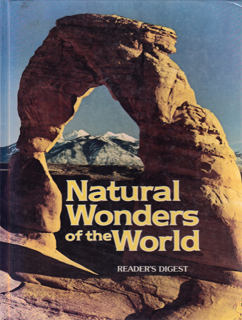
567. Reader’s Digest Natural Wonders of the WorldSame comments as the previous book. Nine reviews, all five stars out of five. 11.2 x 8.6 inches, weight 3.2 pounds, 463 pages, Hardcover. 2 Collectible from $12.99, 36 New from $2.10, 206 used from 1 cent. This is a bargain of almost criminal proportions. |
|||
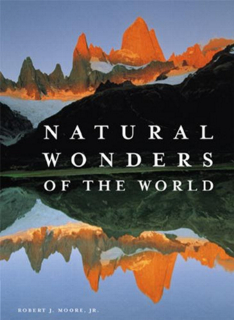
568. Natural Wonders of the World – Robert J Moore“Some wild places are known for their sheer physical beauty, others for their incomprehensible vastness or their vanishing ecosystems. This comprehensive portrayal of such wondrous locales … includes marvels from every continent”. 10.2 x 14 inches, 320 pages, 6.1 pounds. 4 new from $58.18, 23 used from $11.64. |
|||

569. 100 Natural Wonders of the World“…the perfect guide to discovering and exploring some of nature’s greatest wonders”. 6 x 9 inches (trade paperback size), 112 pages. 1 collectible at $9.85, 18 New from $4.98, and 30 used from one cent. |
|||
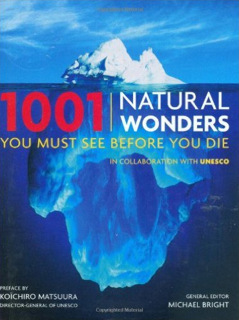
570. 1001 Natural Wonders you must see before you die“…some of the most beautiful sights on Earth and comes from the world’s best traveled writers, ecologists, photographers, and conservationists.” The wonders were all selected by UNESCO as World Heritage sites. Hardcover (pictured): 6.8 x 8.2 inches, 960 pages. 38 New from $14.65 and 62 used from $4.55. http://amzn.to/2drOeMQ Paperback (different cover): 6.3 x 8.3 inches, 960 pages. 7 New from $41.79, 18 Used from $0.98. http://amzn.to/2dEN6Dm |
|||
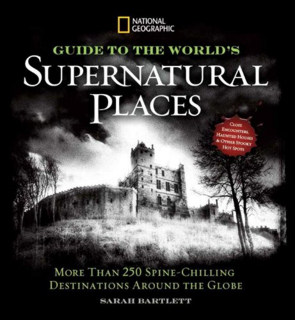
571. National Geographic Guide to the World’s Supernatural Places: More Than 250 Spine-Chilling Destinations Around the GlobeWe are closing out this section with a curve ball, a plot twist, because that’s very Pulp, too. In their own very atmospheric way, these images and locations are just as beautiful as any others here. “A dazzling array of haunted castles, forbidden hideaways and otherwise eerie landmarks.” 8.4 x 9.4 inches, 256 pages; 41 New at $13.94, 29 Used from $3.88. |
|||

|
|||
Books about Strange Exotic, and Miscellaneous Places
|
|||
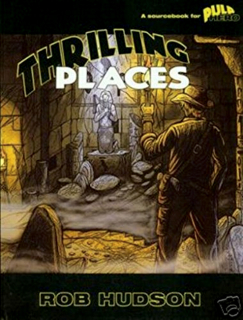
572. Thrilling Places – Rob HudsonPulp Hero sourcebook detailing a dozen or so locations for adventures. |
|||
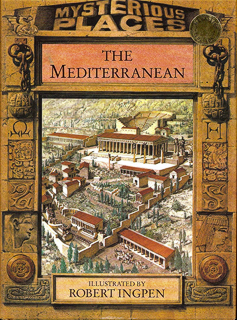
573. Mysterious Places: The Mediterranean – Illustrated by Robert IngpenThe authors, Philip Wilkinson & jacqueline Dineen, don’t even rate a mention on the cover or the spine, which gives you some idea of the relative emphasis of pictures over text in this book. Large print suggests that this is intended for Primary School children, but there’s an awful lot of useful information and illustrations on everything from Tarxien in Malta to The Topkapi Palace in Istanbul – Malta, Greece, Rhodes, Lybia, and Turkey. Italy is a surprising omission. A couple of copies short of our standard. |
|||
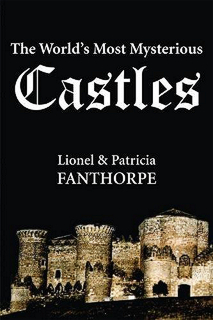
574. The World’s Most Mysterious Castles – Lionel & Patricia FanthorpeAn overview of castles and similar structures from all over the world (including the Alamo), organized by geographic location. There is an emphasis on reported hauntings. Reviews criticize this work on a factual level, but none of the criticism leveled detracts from the appeal as a reference for pulp adventures, where realism is always second in priority to a good story. Just don’t use it for your history thesis. |
|||
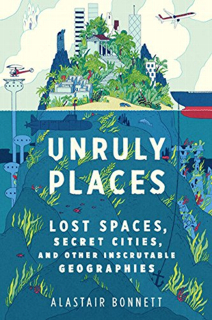
575. Unruly Places: Lost Spaces, Secret Cities, and other Inscrutable Geographies – Alastair BonnettMoving villages, secret cities, no man’s lands, floating islands, and more. Explores places as disorienting as Sandy Island, an island included on maps until just two years ago despite the fact that it never existed., and Sealand, an abandoned gun platform off the English coast that a British citizen claimed as his own sovereign nation, issuing passports and crowning his wife as a princess, and Baarle, a patchwork of Dutch and Flemish enclaves where walking from the grocery store’s produce section to the meat counter can involve crossing national borders, or much more. This stuff is pure pulp Gold, worth the effort of throwing back in history if necessary. |
|||
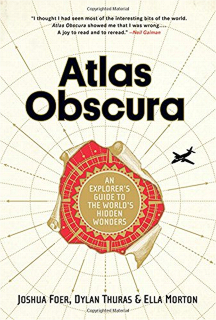
576. Atlas Obscura: An Explorer’s Guide To The World’s Hidden Wonders – Joshua Foer, Dylan Thuras, and Ella Morton“Celebrates 700 of the strangest and most curious places on earth,”. From the Glowworm caves in New Zealand to a baobab tree in South Africa that is so large it has a pub inside that holds 15 patrons. “Compelling descriptions, hundreds of photographs, surprising charts, and maps for every region of the world”. “Anyone can be a tourist. Atlas Obscura is for the Explorer.” And the perfect thing to add a touch of the strange or oddball to a visit to some remote – or nearby – part of the world. |
|||
Books about Florida’s Coral Castle
|
|||
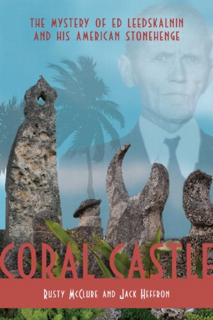
577. Coral Castle: The Mystery of Ed Leedskalnin and his American Stonehenge – Rusty McClure and Jack HeffronThe first book to take an objective, journalistic look at one of America’s most intriguing places Coral Castle, located in Homestead, Florida. Edward Leedskalnin, an eccentric Latvian immigrant, built Coral Castle in the 1920s and 30s. Working alone with primitive tools, he quarried, carved, and set in place more than 1,100 tons of coral rock, creating what is commonly known as the American Stonehenge. How he accomplished this amazing feat remains a mystery. |
|||
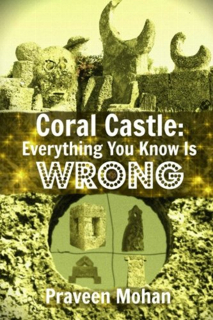
578. Coral Castle: Everything You Know Is Wrong – Praveen Mohan“A standard description of Coral Castle goes like this: Coral Castle is a love monument built by an eccentric man called Edward Leedskalnin. The Castle is a giant doll house built for Ed’s sweet sixteen and his imaginary children. Ed built stone models of household objects like couches, bathtub, cooker, etc to be used by his fictional family. He also created strange meaningless carvings like the moon fountain and obelisk to impress his lost love. Experts have shown that there is nothing mysterious about the castle or how it was constructed, just one man’s persistent work. In this book, you will see that all the above statements are false.” This book swallows the “Mysterious Forces” explanation whole, and attempts to disprove the basic-engineering explanation that most people now accept. But “Basic Engineering” is no fun in a pulp context, while a mastery of “mysterious forces” can be a lot of fun. So it has been included. |
|||
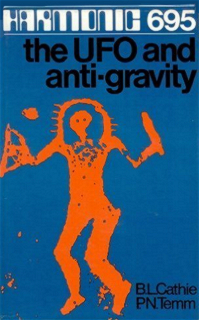
579. Harmonic 695 – Bruce CathieMost of the book falls into the discredited-but-fun fringe-science category, but there is a great description and set of photos of the Coral Castle and its for that reason that we are recommending it. http://amzn.to/1YEUT5J A new edition is even more widely available, listed as “The Energy Grid” |
|||
 |
|||

Afterword by Blair:
There’s an art form to using especially-strange places. It’s a seduction; in order to achieve credibility in the eyes of a player. Often, the easiest way to do that is to start with something that thy will recognize and accept as representing their world, and then to permit the strangeness to ‘seep in’ over time, gradually increasing in concentration until they have just about noticed it – then Wham! hit them between the eyes, full force.
I start with a hint of strangeness – a small detail in the location description that is just a little off or odd, but that has no impact on gameplay; it’s just something that gets mentioned every now and then.
Sometime after they have gotten used to this strangeness, you can up the ante, introducing another element of strangeness, this time in something to which they will pay close attention, but again, in a way that doesn’t materially affect the way the circumstances are resolved. But I will keep this hint of strangeness more conspicuous by using it an an adjective incorporated into however you identify whatever-it-is, and continue this until they do so, too.
That’s when they are ready to tolerate and even enjoy anything, from confrontation with the strange to full-on Ditko-esque Dr Strange -style cosmic weirdness.
A haunted house? Start with some spiderweb billowing as though in a breeze – even though no breeze can be felt. In stage two, the ticking of a clock is noticed to be a little strange = every now and then it misses a ‘tick’, or double-ticks to make up the lost ground. I will match the ebb-and-flow of the action to that tick; for a moment, every now and then, things will seem to stand still, only to rush through a moment later. When they are used to this rhythm – step, step, pause, double-step – they are ready for anything. Full-on poltergeist action with the doors and windows, a candle seeming to float down the hallway on its own, strange sounds abruptly issuing from the walls, a spectral apparition.
The build-up seduces them into accepting the full strangeness, when it occurs. Hint, Tease, Explore – that’s the pattern.
Many of the unexplored or poorly-known parts of the world in a pulp era simply cry out for for use in a game, but we will always start by describing the location in familiar and comfortable terms, letting them slowly get used to the strangeness of the place before placing that weirdness or exotic flavor at the fore-front in a way that cannot be ignored.
Take a little-known location – Mongolia, The Amazon, The Hollow Earth, – and give your PCs a reason to go there: a villainous plot, a mysterious artifact, a lost explorer in need of rescue. What they will find is limited only by your investigation.
When the PCs encountered a “freshwater Kraken” in the Yellow River, we started with the river unexpectedly deepening, changing color from a yellowish brown to a deep violet shade, mentioned in passing. An NPC spots movement beneath the surface for a moment, but then it is gone. And then the deck lurches suddenly to one side as three giant tentacles grasp the ship from the direction away from where the PC was looking, as another softly-glowing tentacle breaks the surface on this side of the ship, and a fifth wraps itself around a screaming NPC and lofts him fifty feet into the air. The Hint, the Tease, the full-on can’t-be-ignored in-your-face reality.
Magic, lost civilizations, or lurking Nazis can all be hidden in the undergrowth. A glimpse, then a hint, and then the presence. Or it might be any number of supernatural or weird science or occult artifacts or creatures, capable of who-knows-what.
If you can impress upon your players how ‘off the map’ they are, it only helps in selling the strangeness as what passes for reality in this place at this particular instant.
Hint, Tease, and then milk the uniqueness you find in a location for all that it’s worth; that’s the recipe for success with any of these locations. It’s a technique that has served us well, and will satisfy yours, too.
After this marathon effort, the Essential Pulp Reference Library series will be taking a brief break while I recharge my batteries. Never fear, it should be back in a week or so, but it’s time to give some other genre a little spotlight time!
Update, 21 October, 2016:
It was noticed during the week that while links would automatically be generated when viewing the post directly, WordPress did not do so when the article was viewed on the home page or other curated pages eg searches. So I have now done what I hoped to avoid and hard-coded all the links, and taken advantage of the opportunity to further tidy up some minor formatting issues. Over the course of the weekend, I intend to bring the other parts of the series up to the same standard, working backwards. Some parts may have to wait until next week, though – this is only a mid-range priority.

- The Essential Reference Library for Pulp GMs (and others) Pt 0: The Front Desk
- Essential Reference Library for Pulp GMs (and others): 1st Shelf
- Essential Reference Library for Pulp GMs (and others): 2nd Shelf
- Essential Reference Library for Pulp GMs (and others): 3rd Shelf
- Essential Reference Library for Pulp GMs (and others): 4th Shelf
- Essential Reference Library for Pulp GMs (and others): 5th Shelf
- Essential Reference Library for Pulp GMs (and others): 6th Shelf
- Essential Reference Library for Pulp GMs (and others): 7th Shelf
- Essential Reference Library for Pulp GMs (and others): 8th Shelf
- Essential Reference Library for Pulp GMs (and others): 9th Shelf
- Essential Reference Library for Pulp GMs (and others): 10th Shelf
- Essential Reference Library for Pulp GMs (and others): 11th Shelf
- Essential Reference Library for Pulp GMs (and others): 12th Shelf
- Essential Reference Library for Pulp GMs (and others): 13th Shelf
- Essential Reference Library for Pulp GMs (and others): 14th Shelf
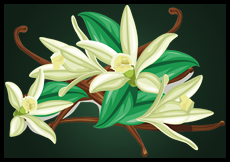





March 14th, 2017 at 1:41 am
We recently received a comment via the “contact” page for the site from Greg Gick, who wrote:
“Love your GM’s Essential Shelf to Pulp. One book I found I truly recommend is “All About Shanghai and Environs: The `34-`35 Standard Guide Book” reprinted by Earnshaw Books. A travel guide to Shanghai of that year [which] lists businesses, phone numbers, the ads in the book from the time period, how long it takes trains and ships to get somewhere (as well as prices) and even where to get ice from. HIGHLY recommended.
We’re very glad that you’re enjoying the series, Greg, and thanks for the recommendation!
Mike Bourke recently posted..An Introduction To The Brilliance Of Derren Brown
August 13th, 2017 at 6:37 am
Thanks for sharing this
praneet thakur recently posted..Chintamani ganpati – ChinchPokli Cha Raja Chintamani aagman 2017 Images
August 13th, 2017 at 3:43 pm
You’re welcome :)